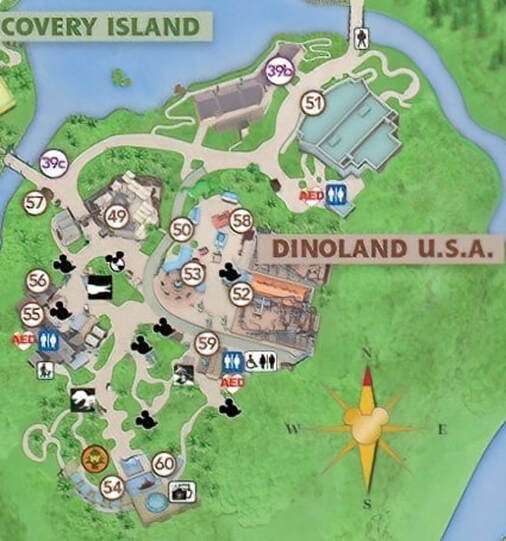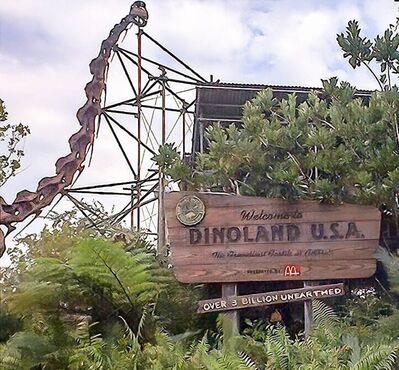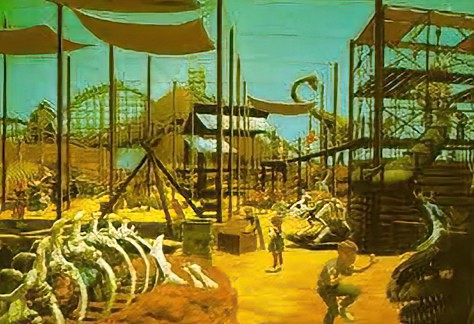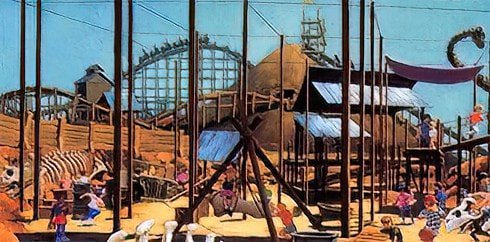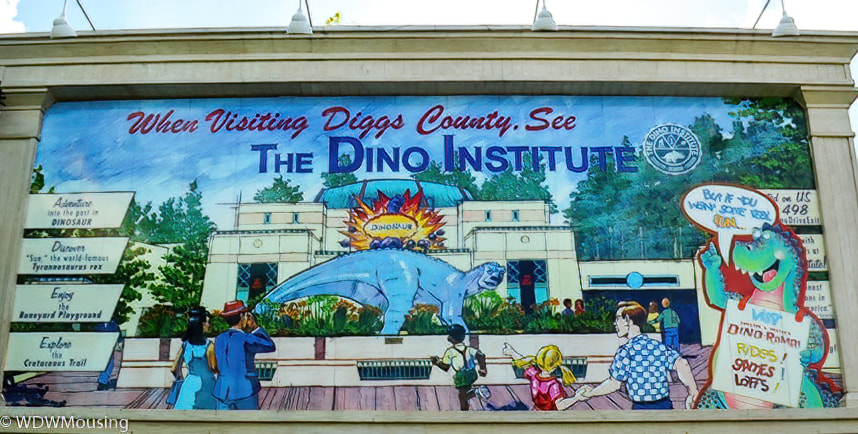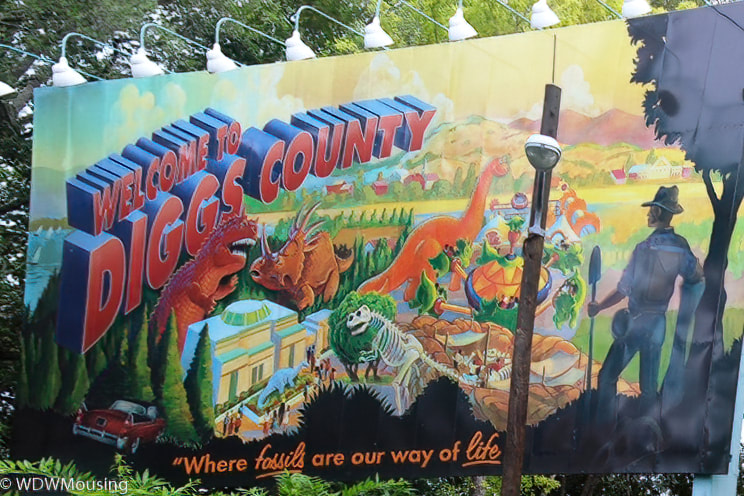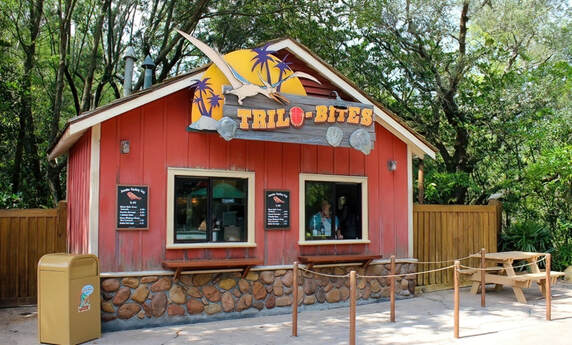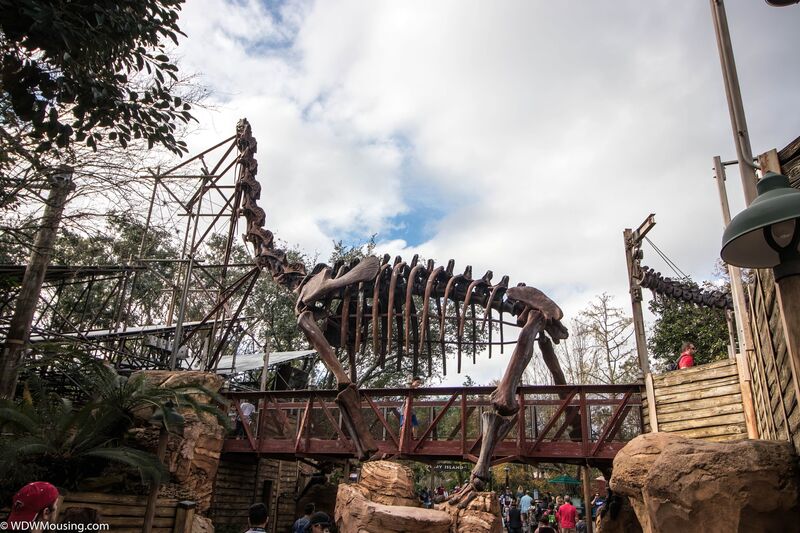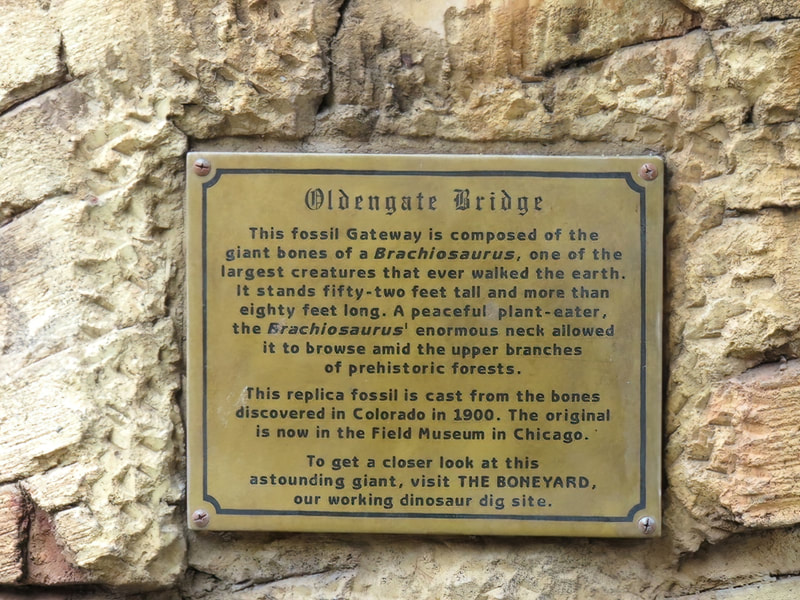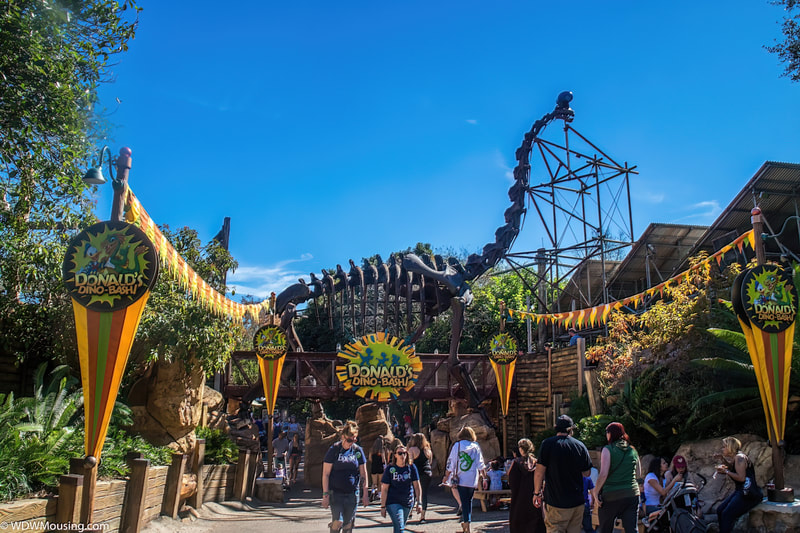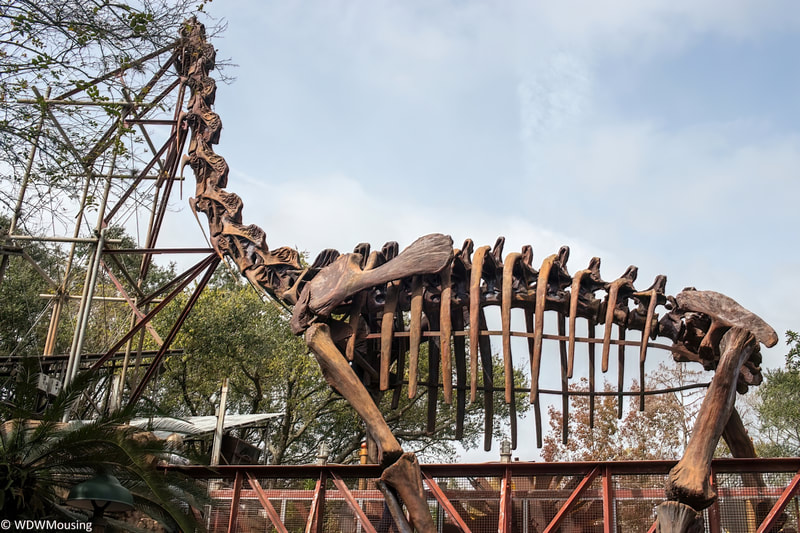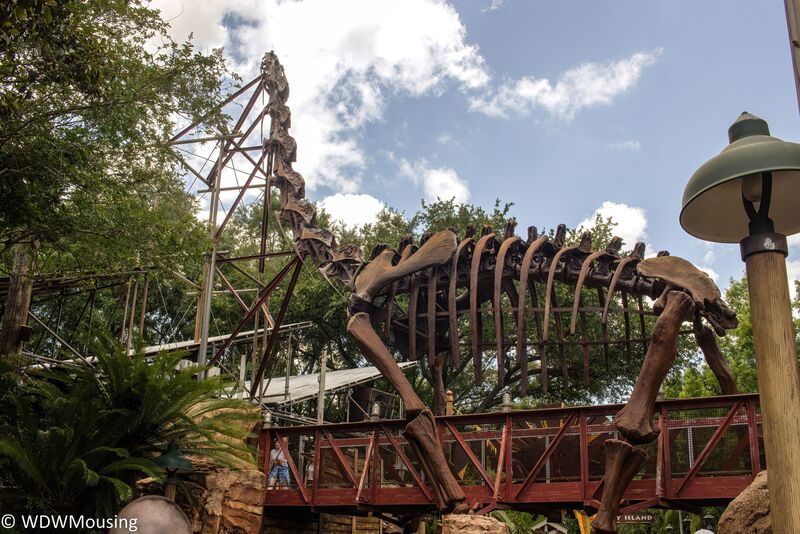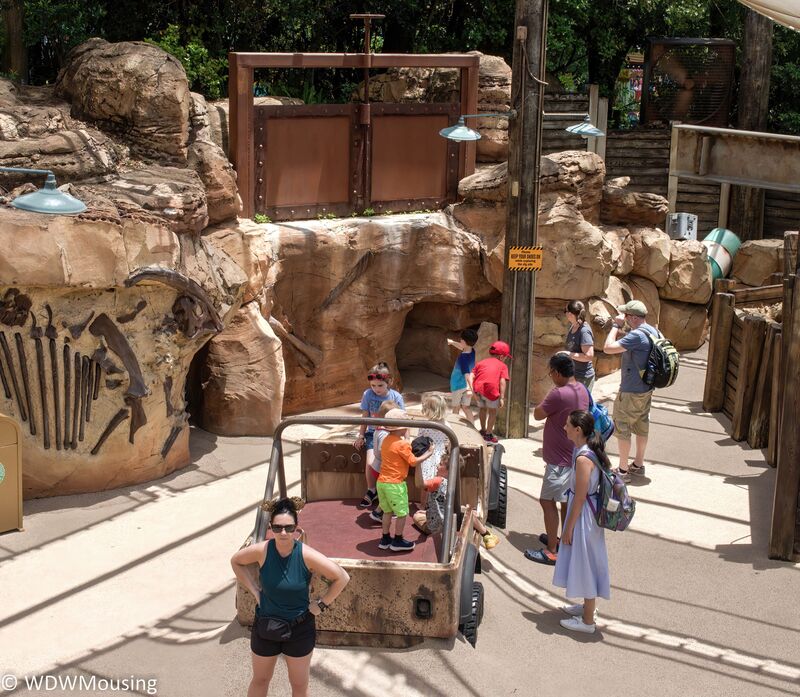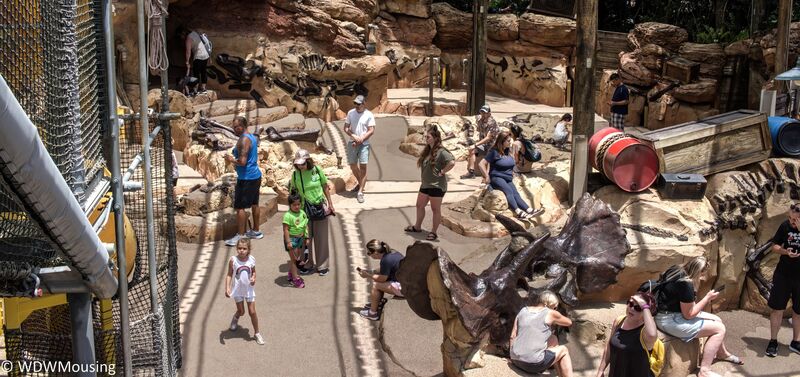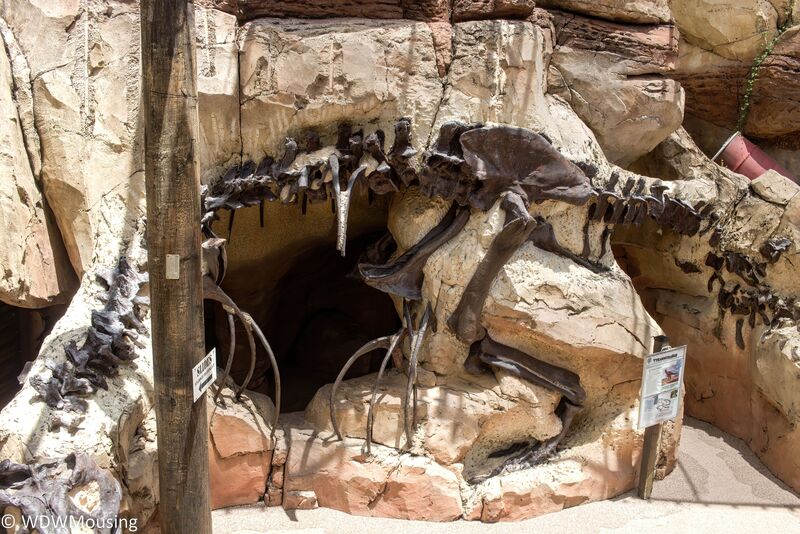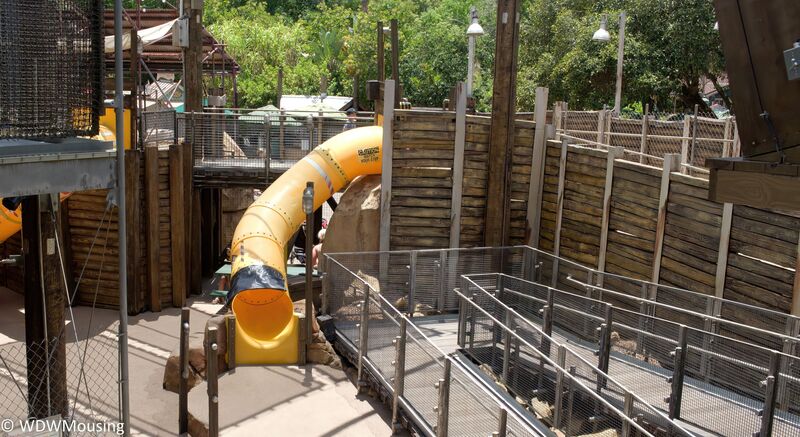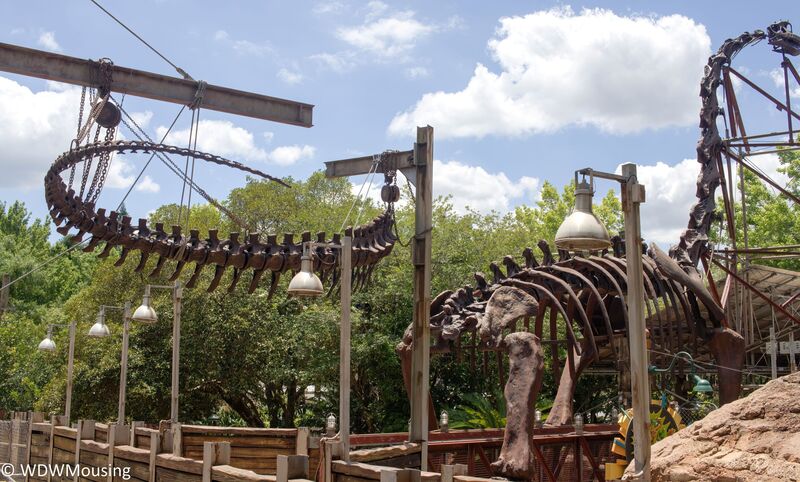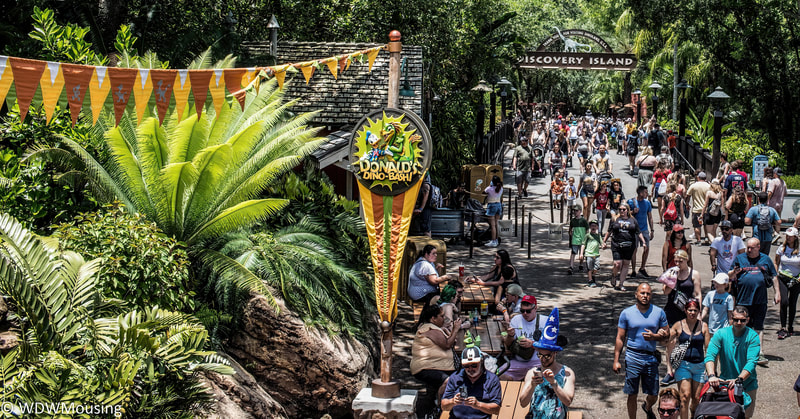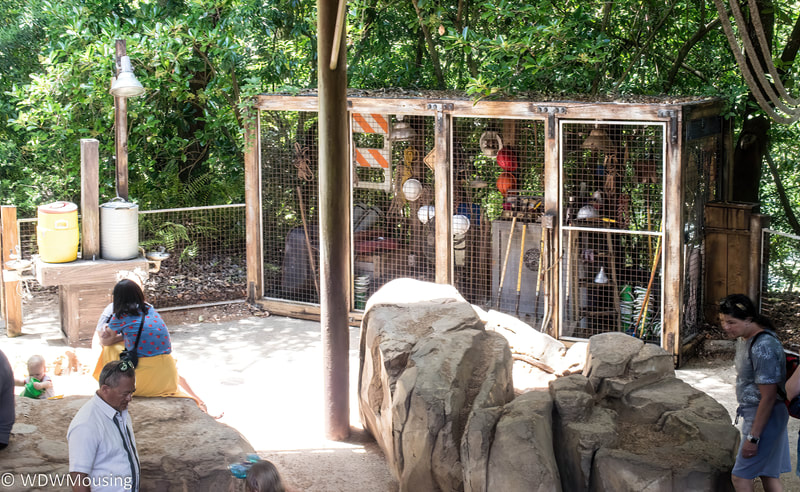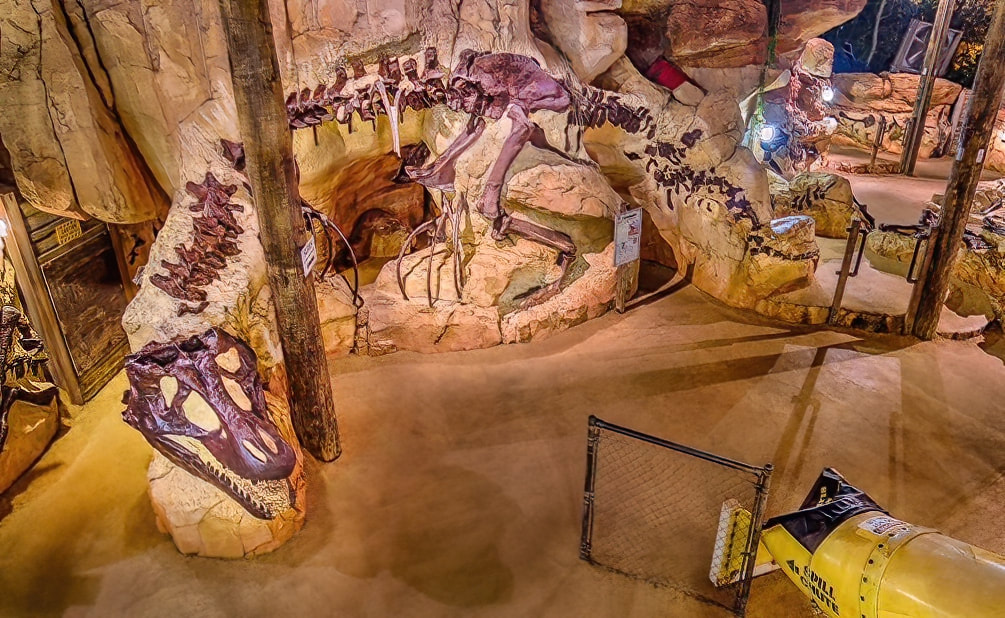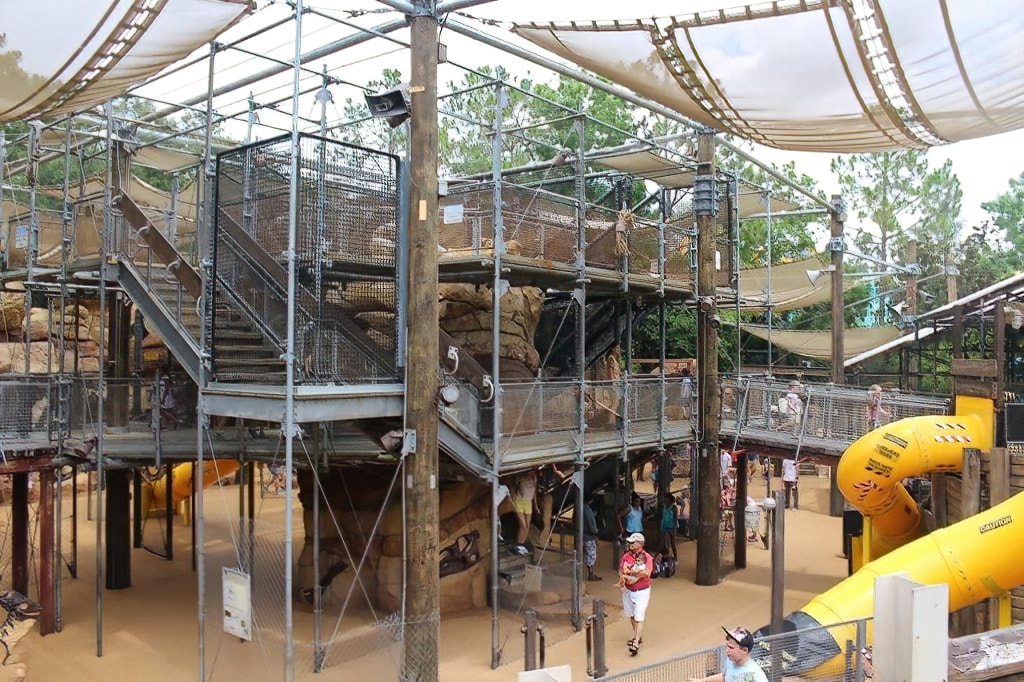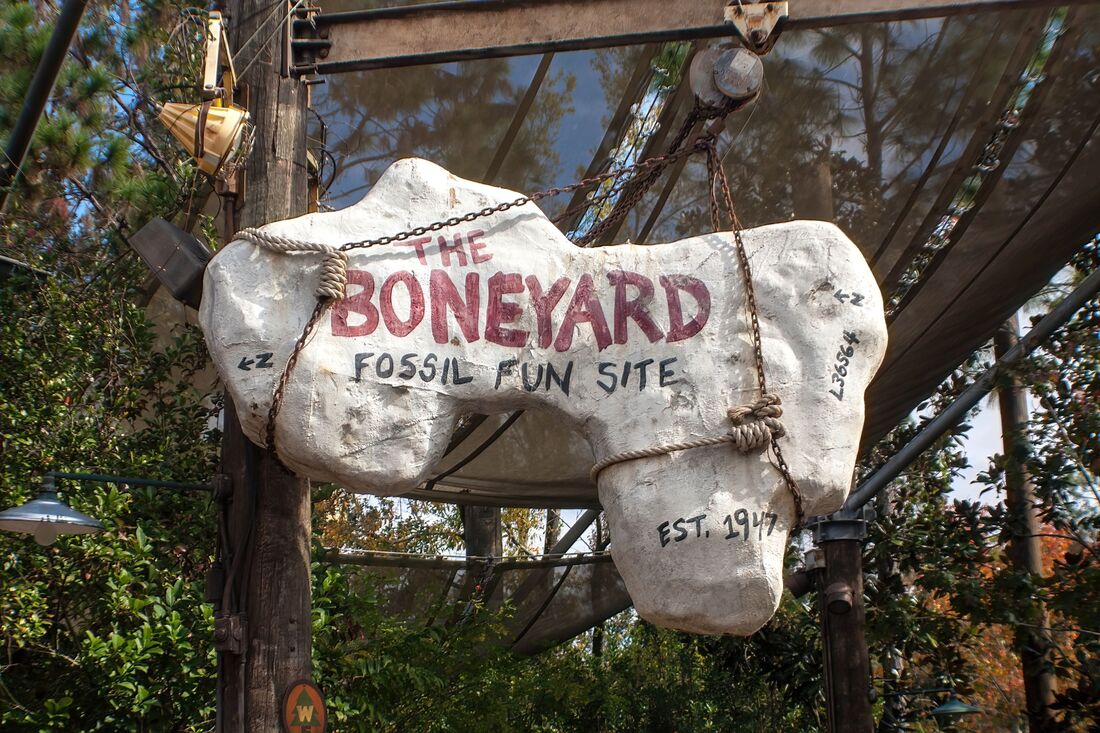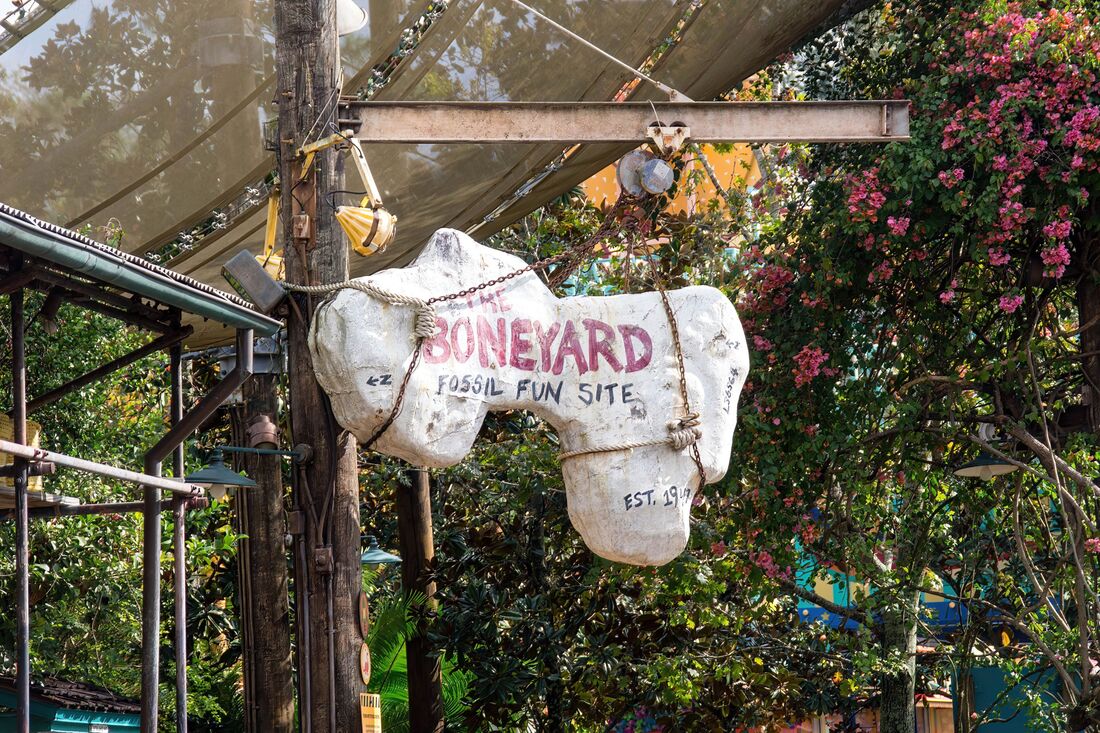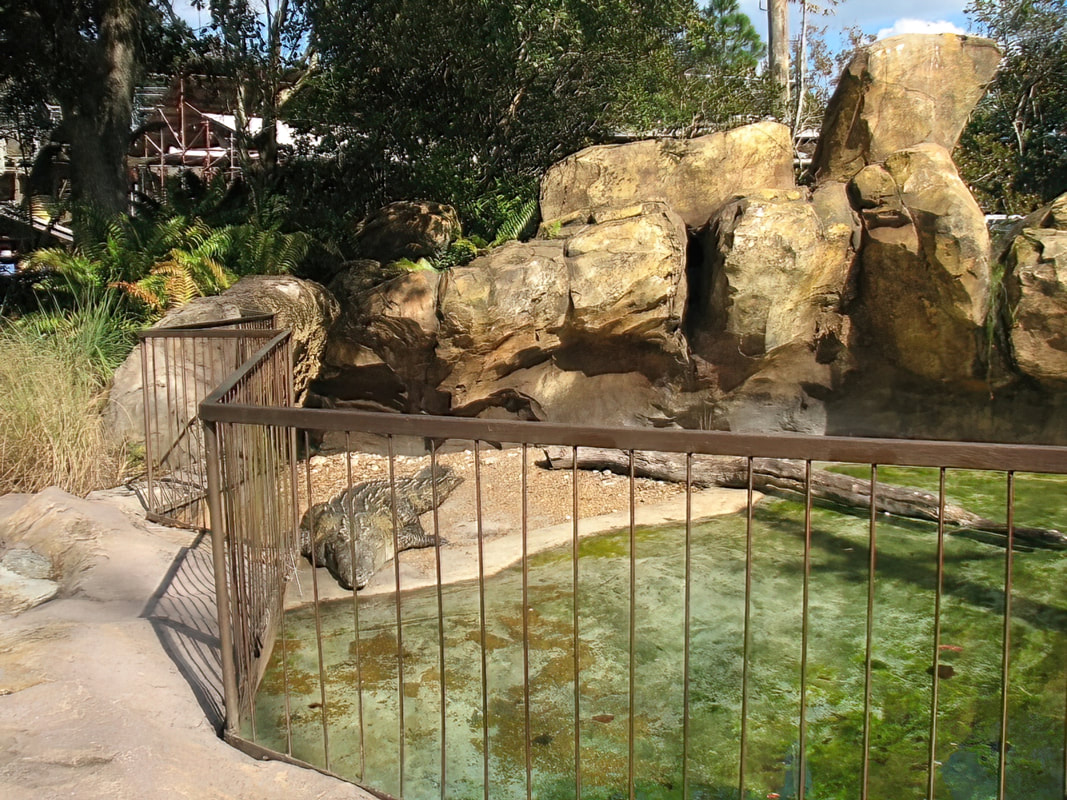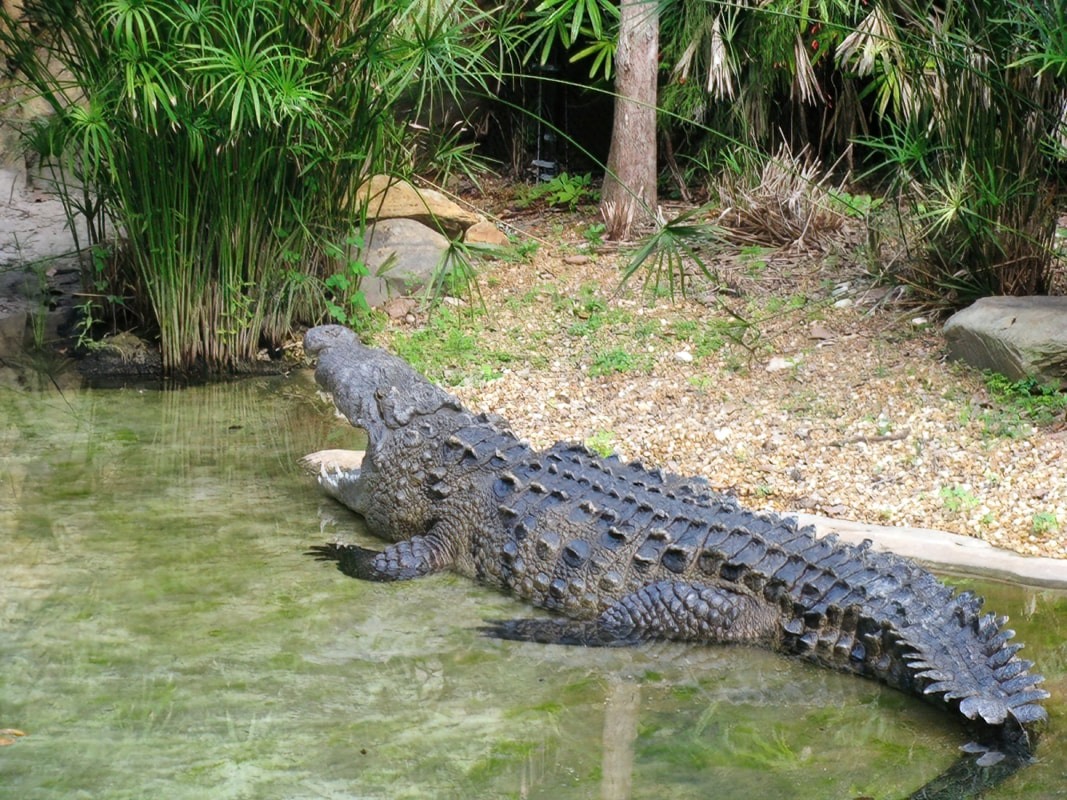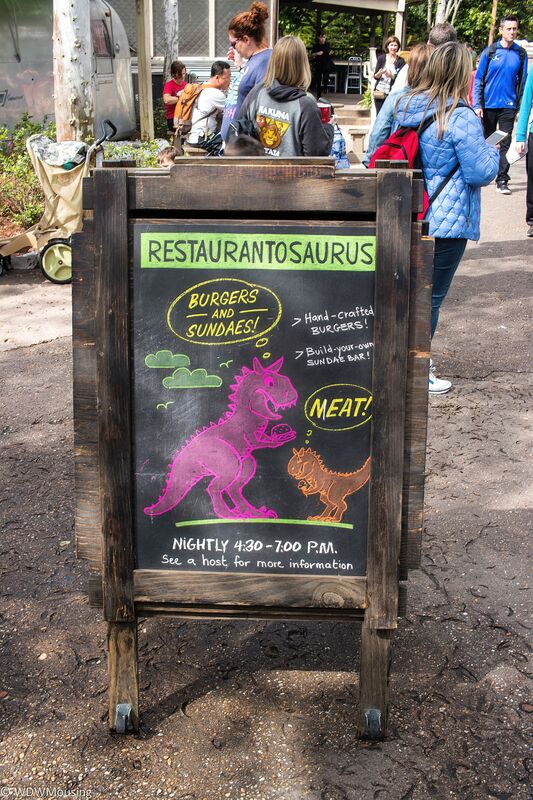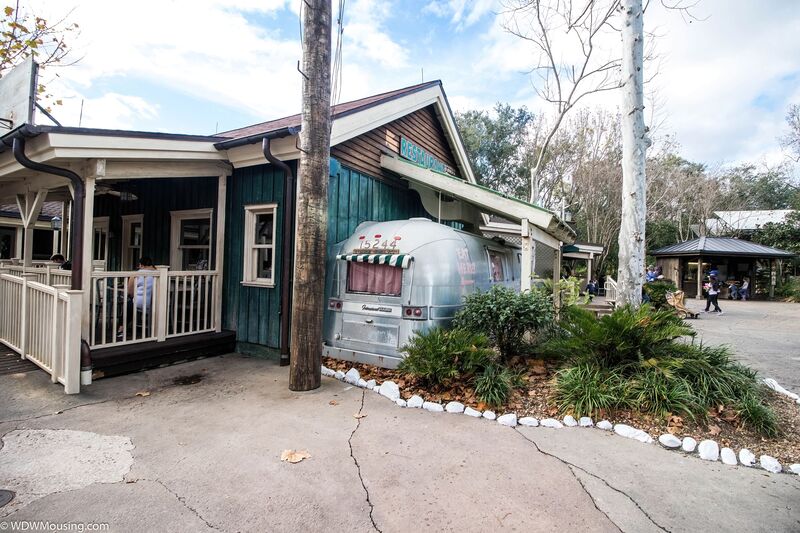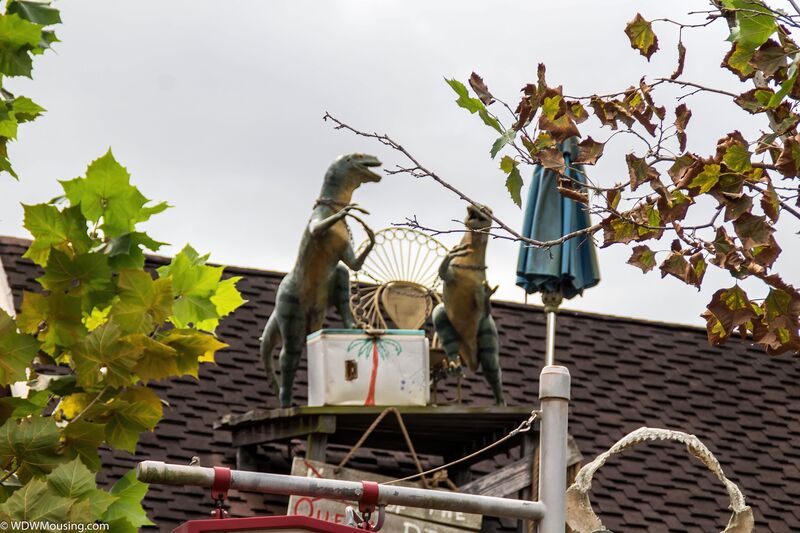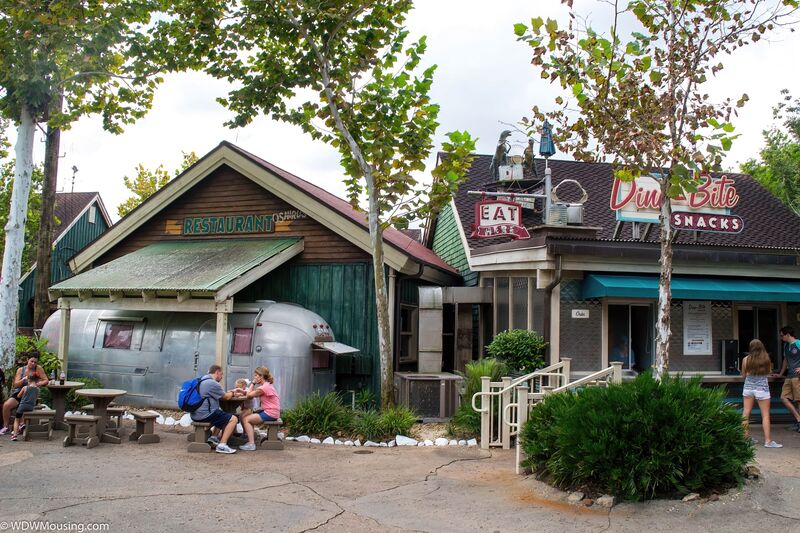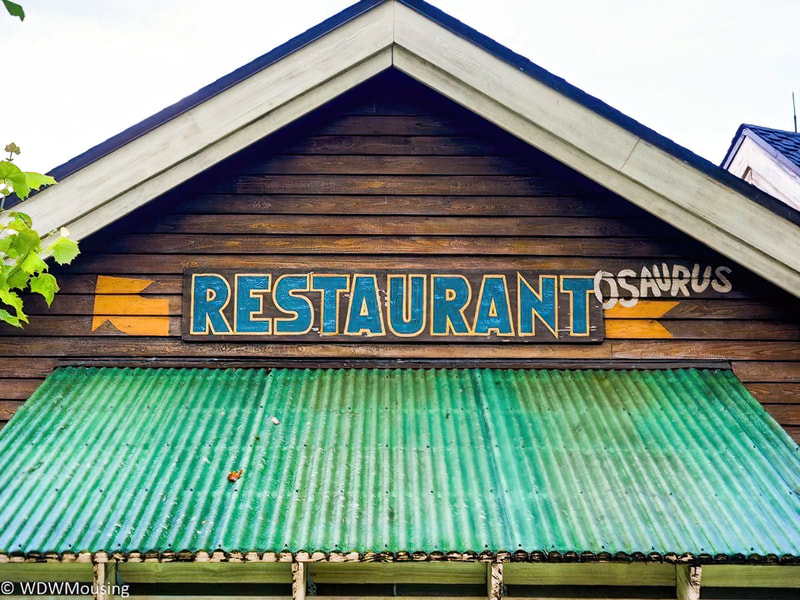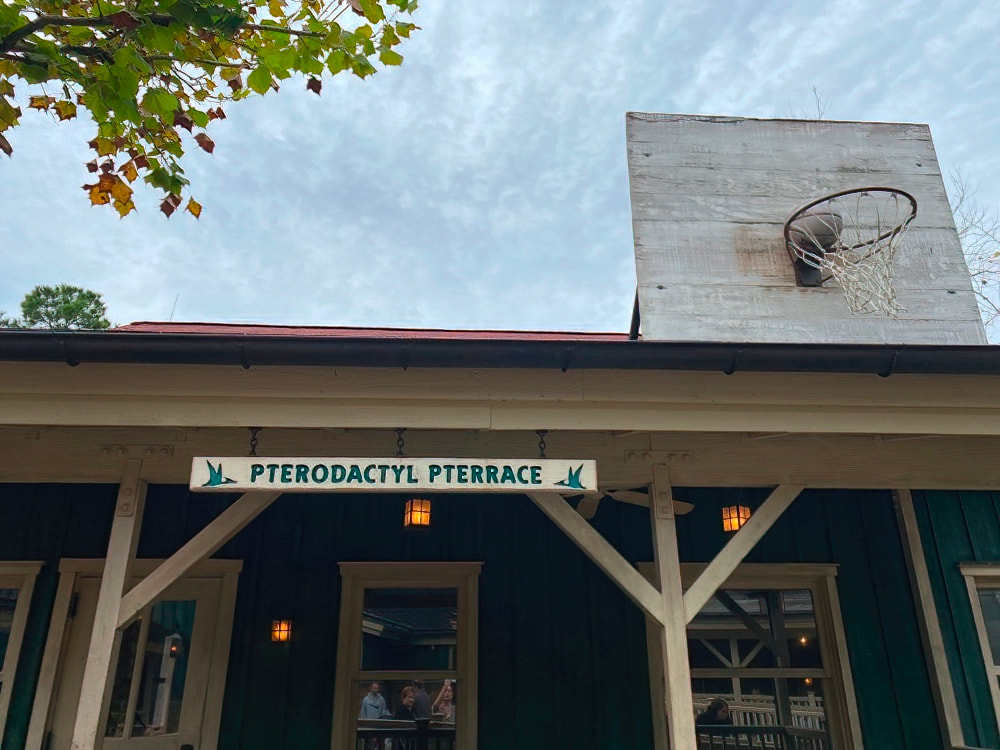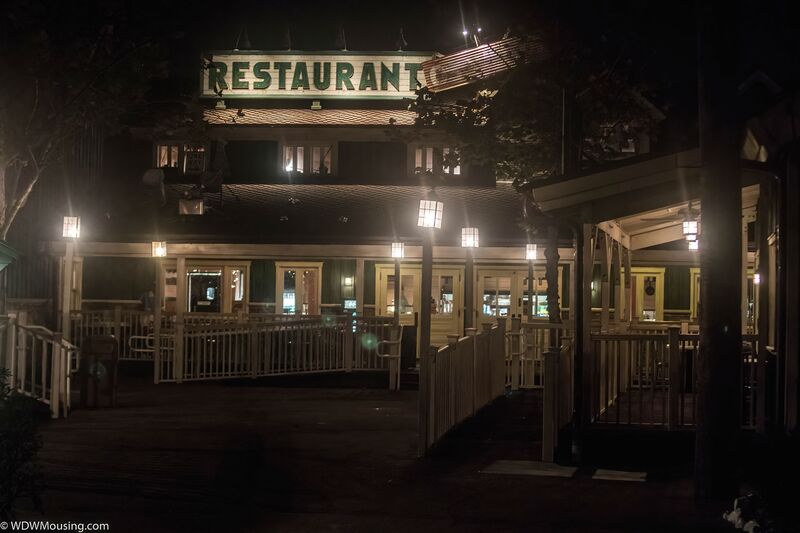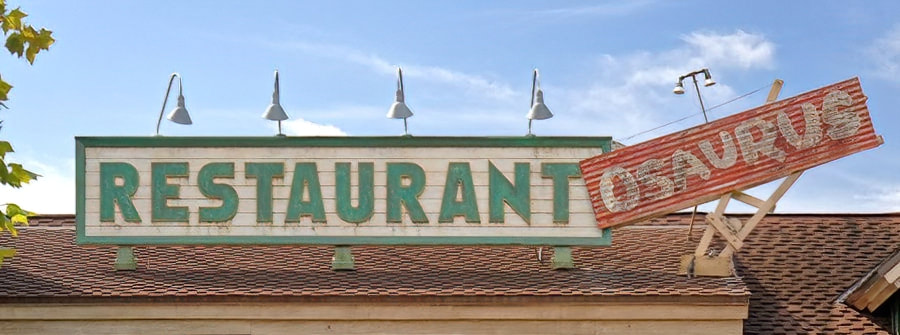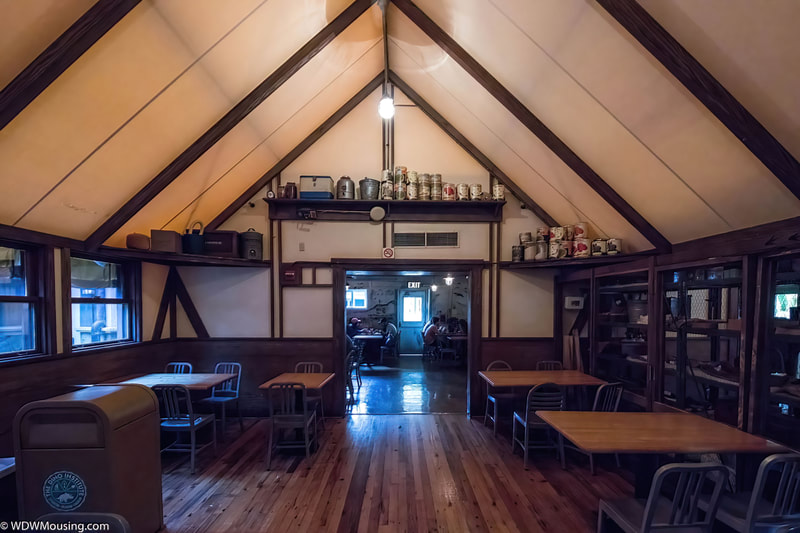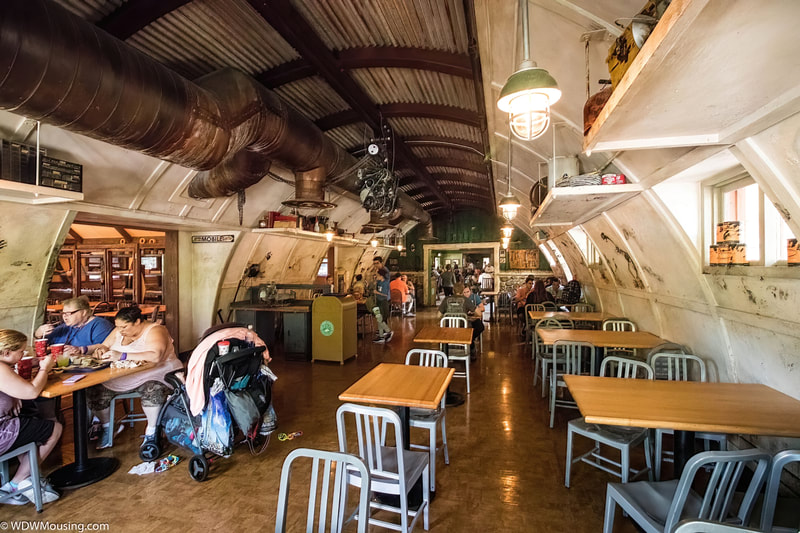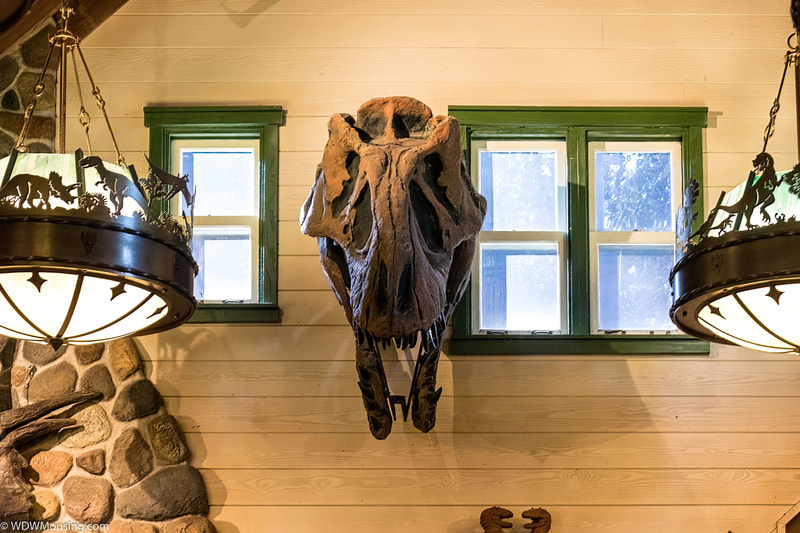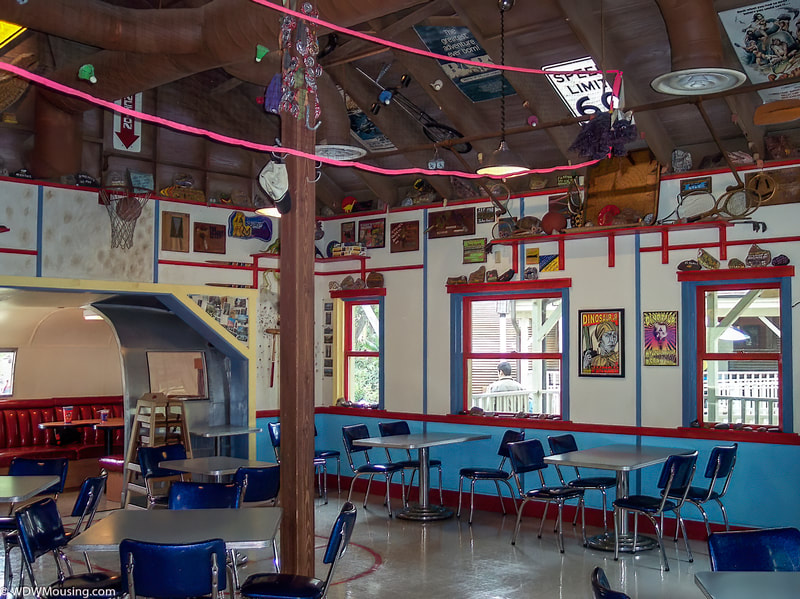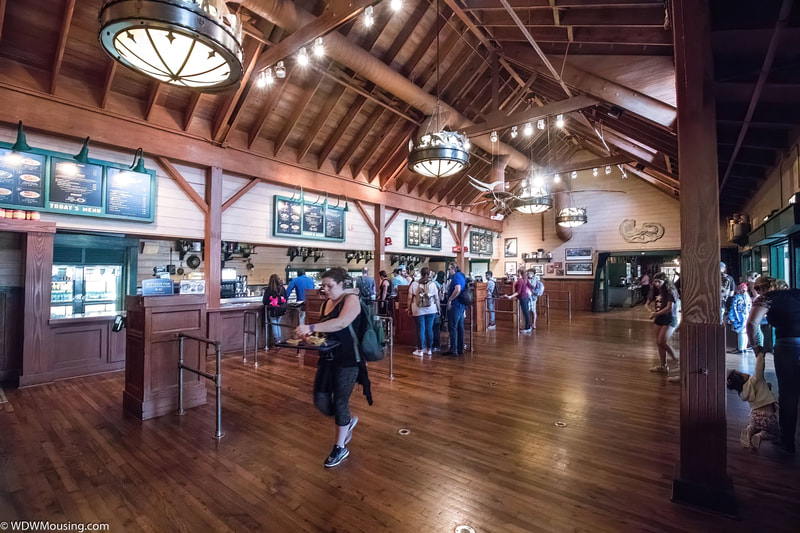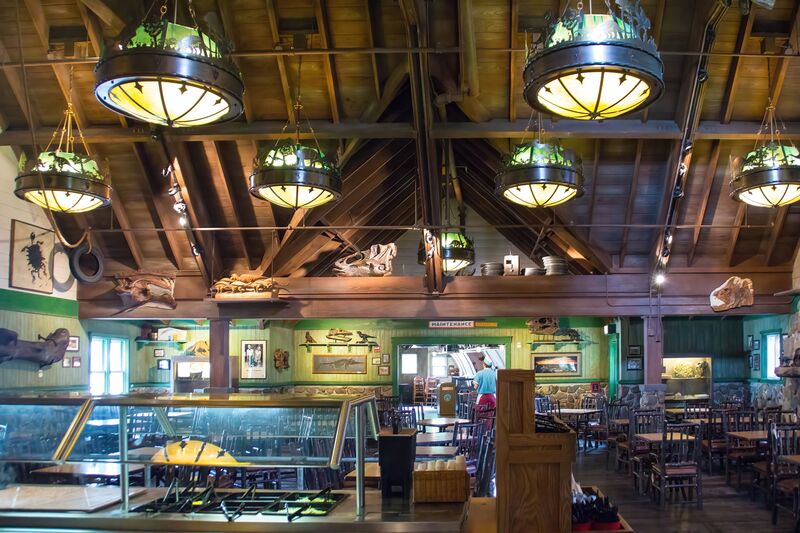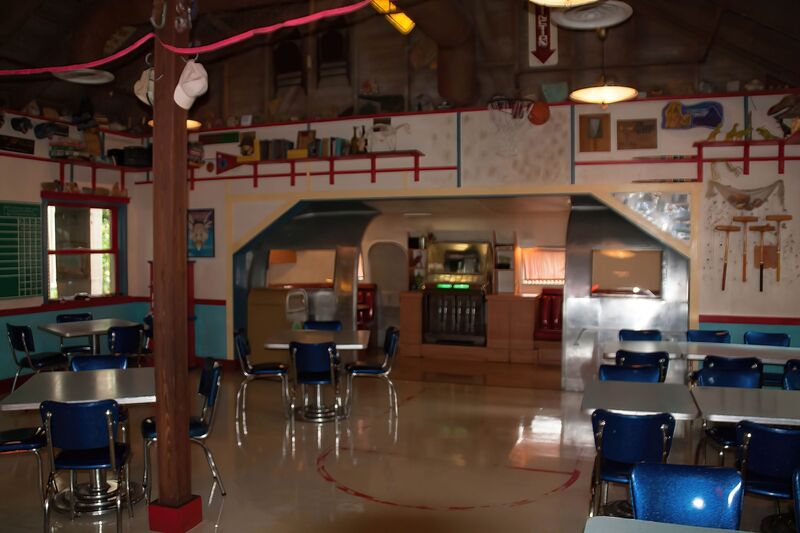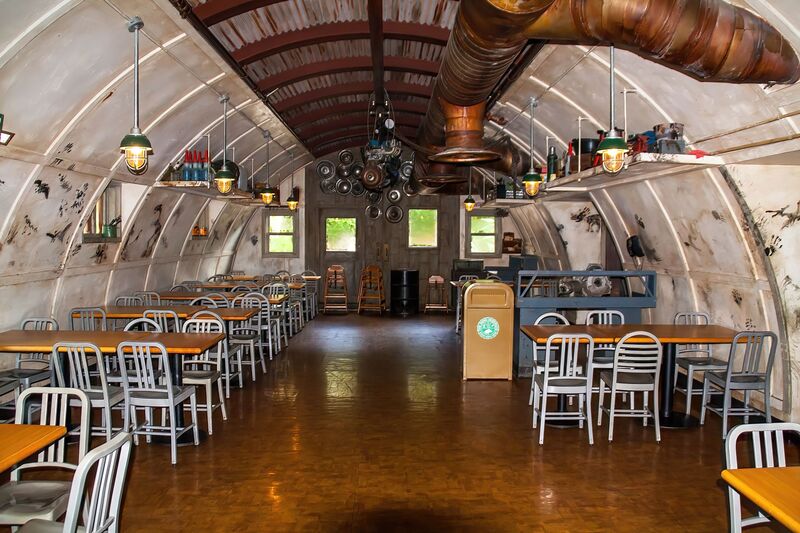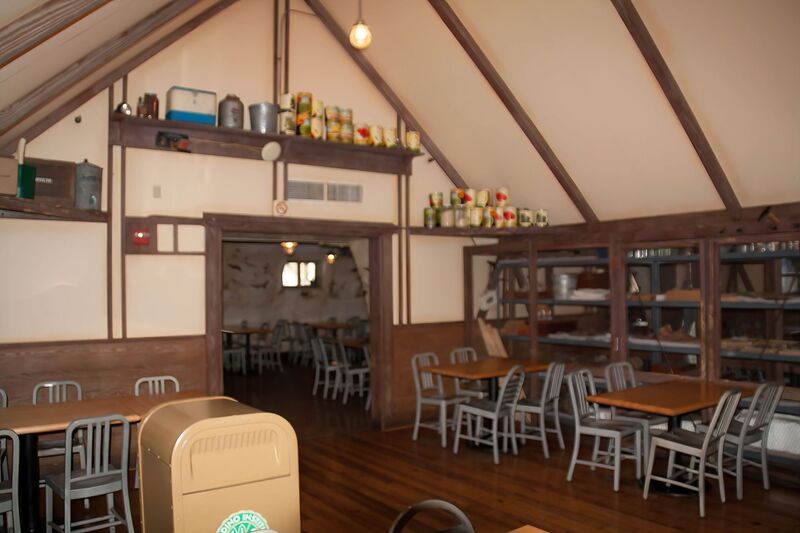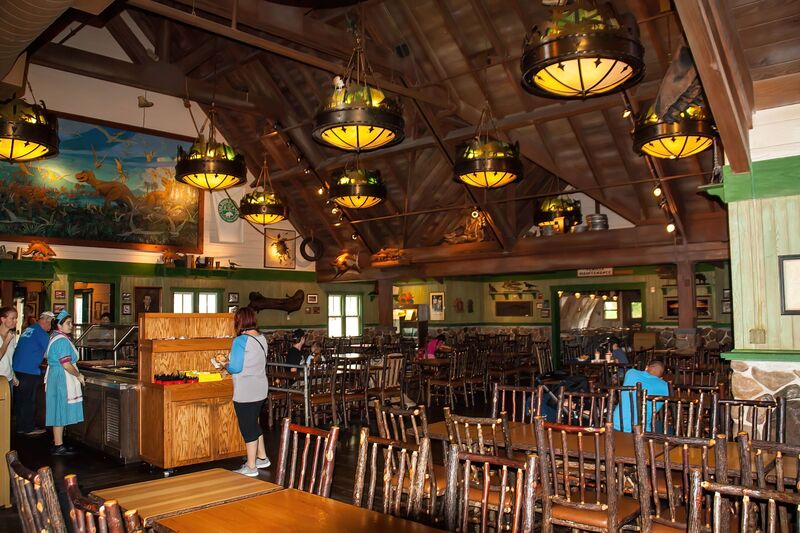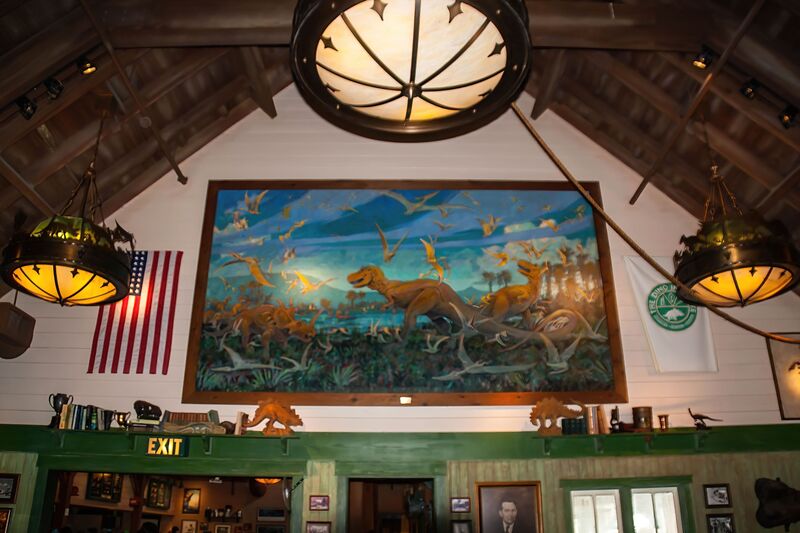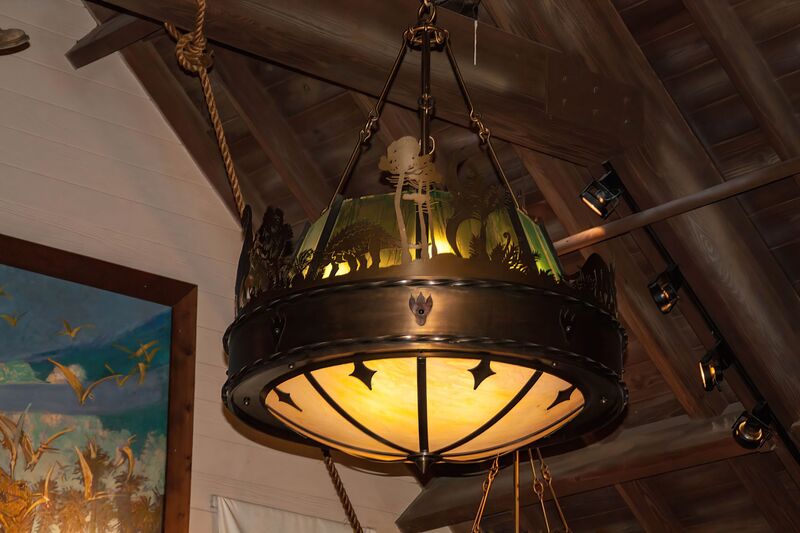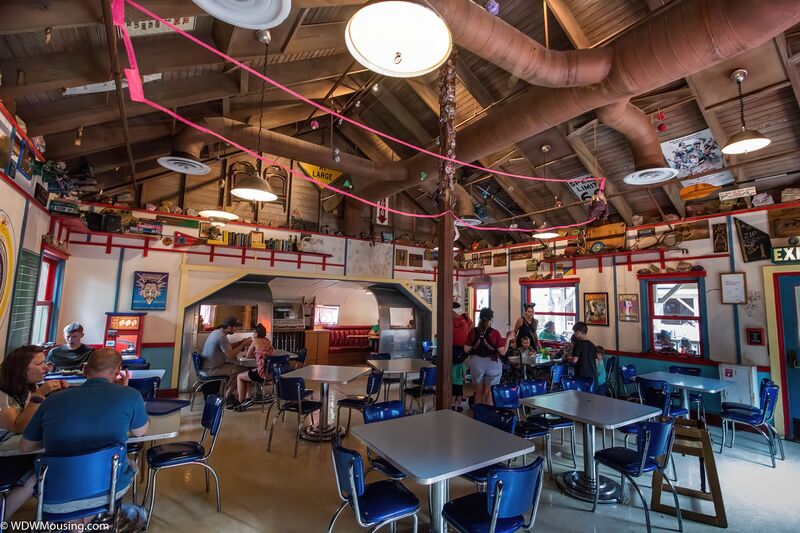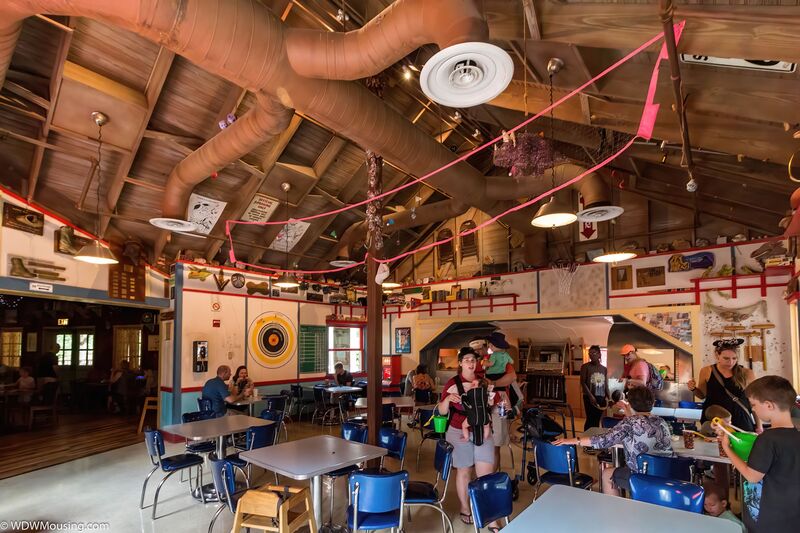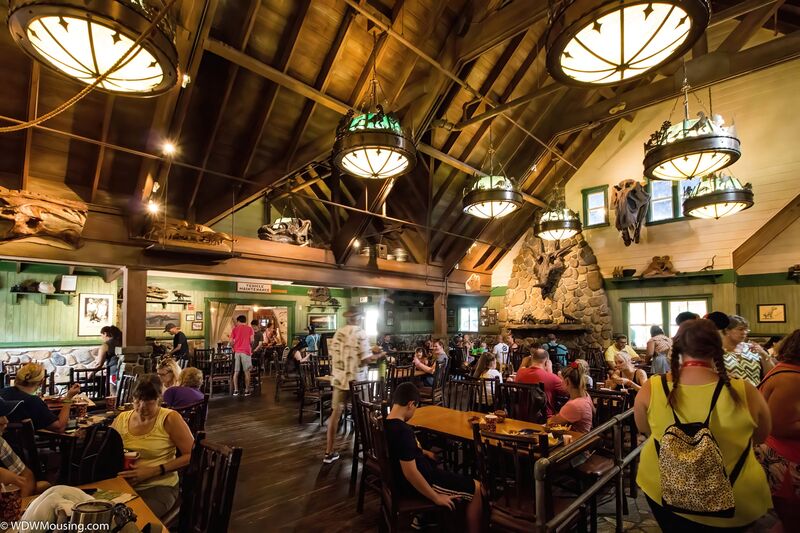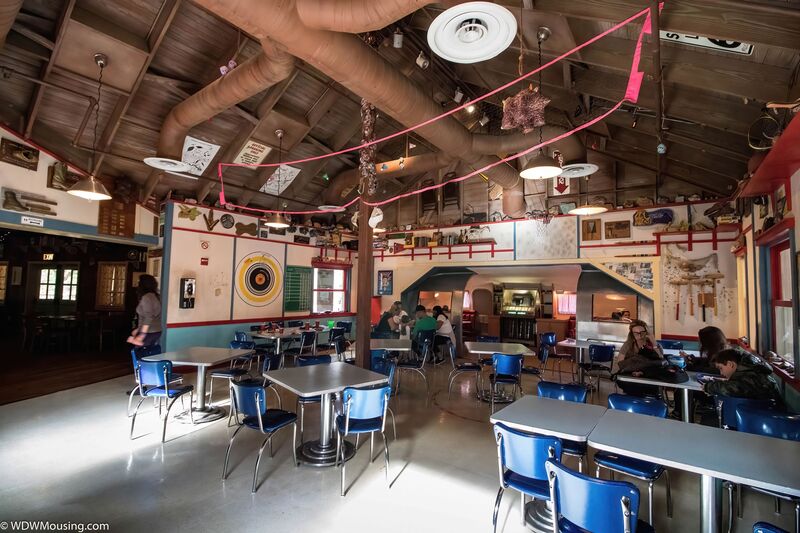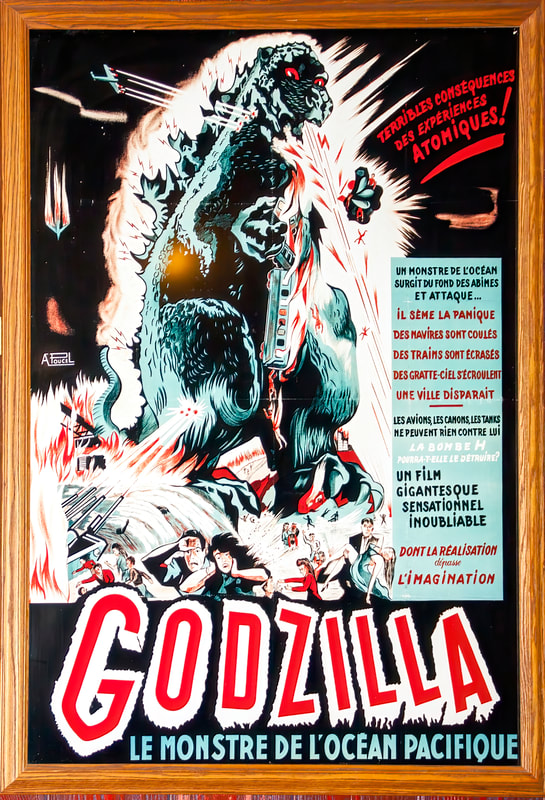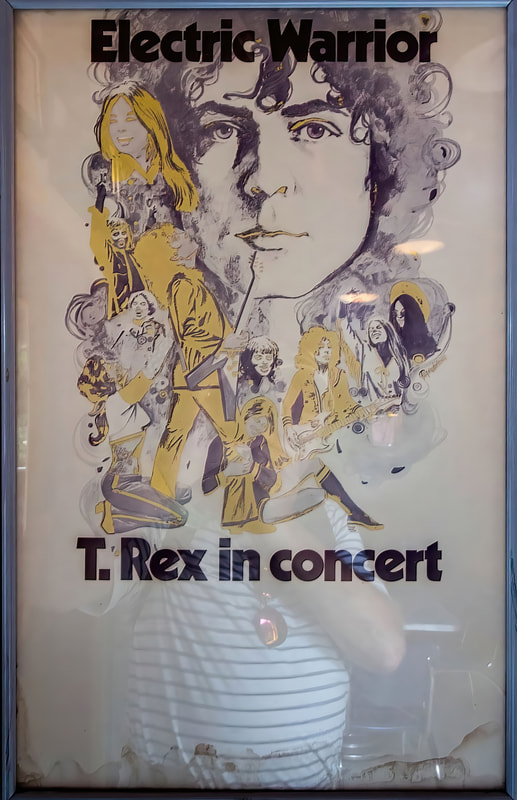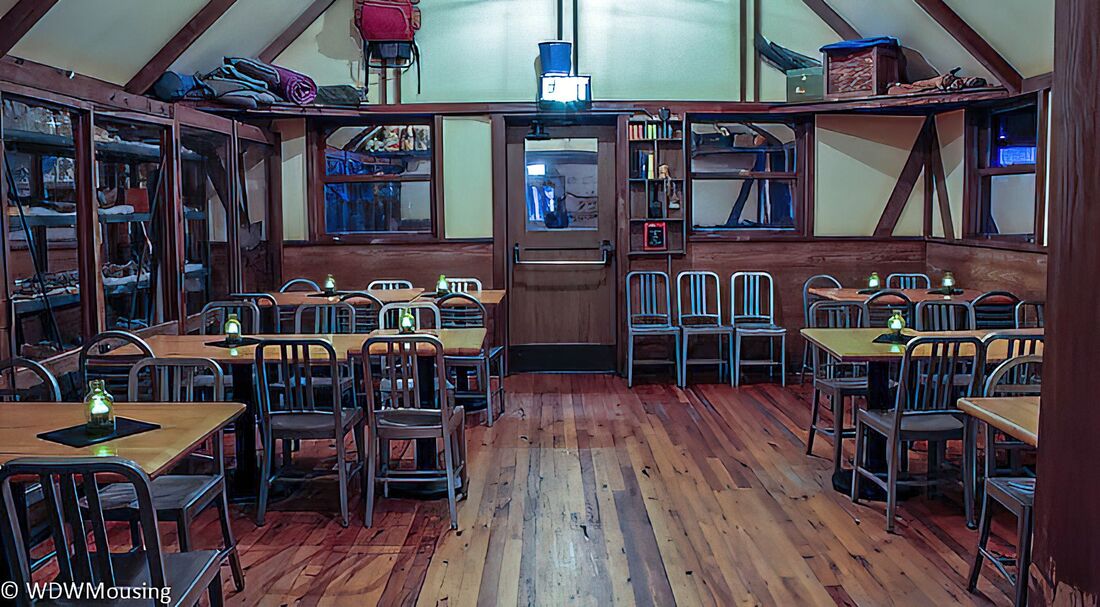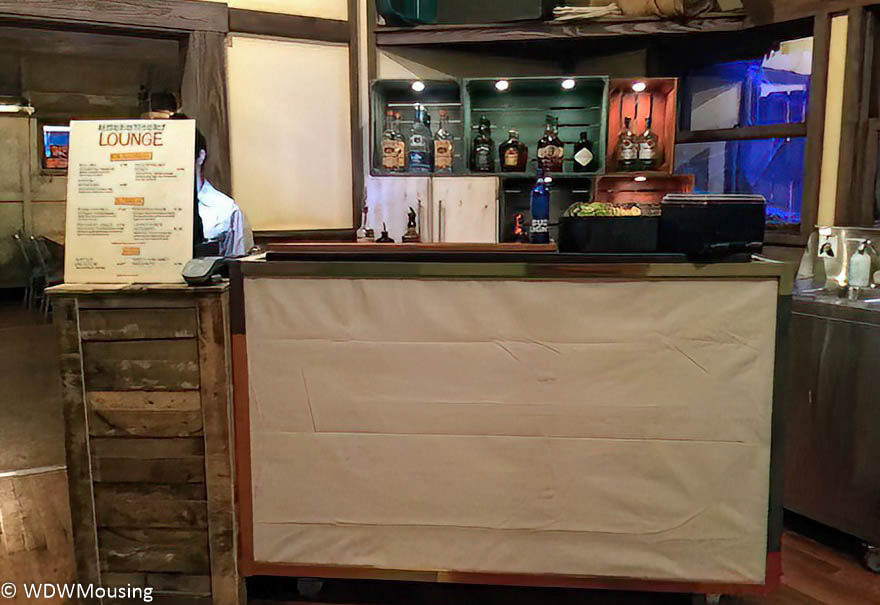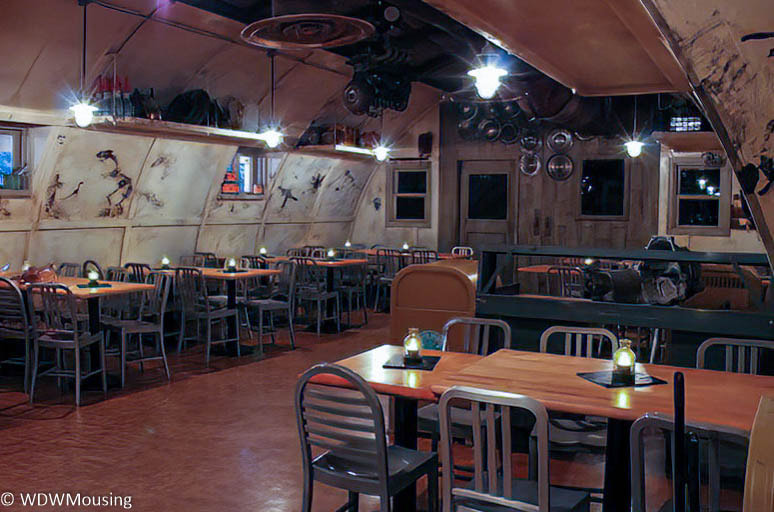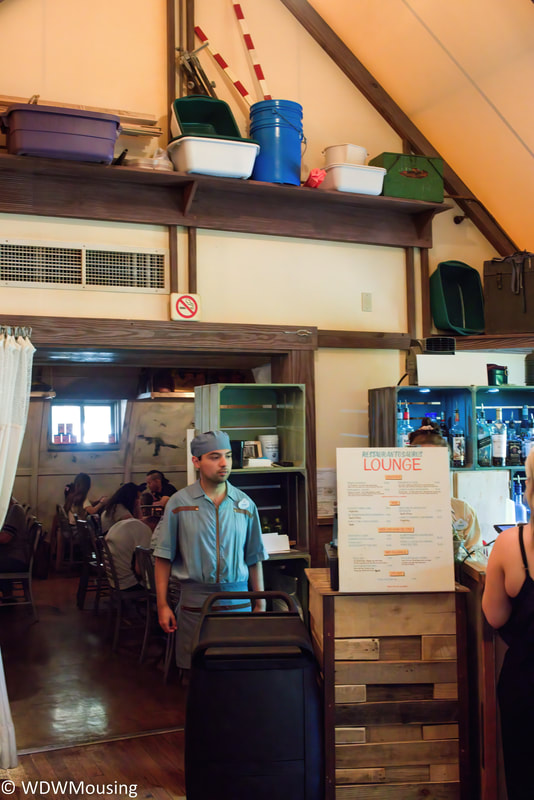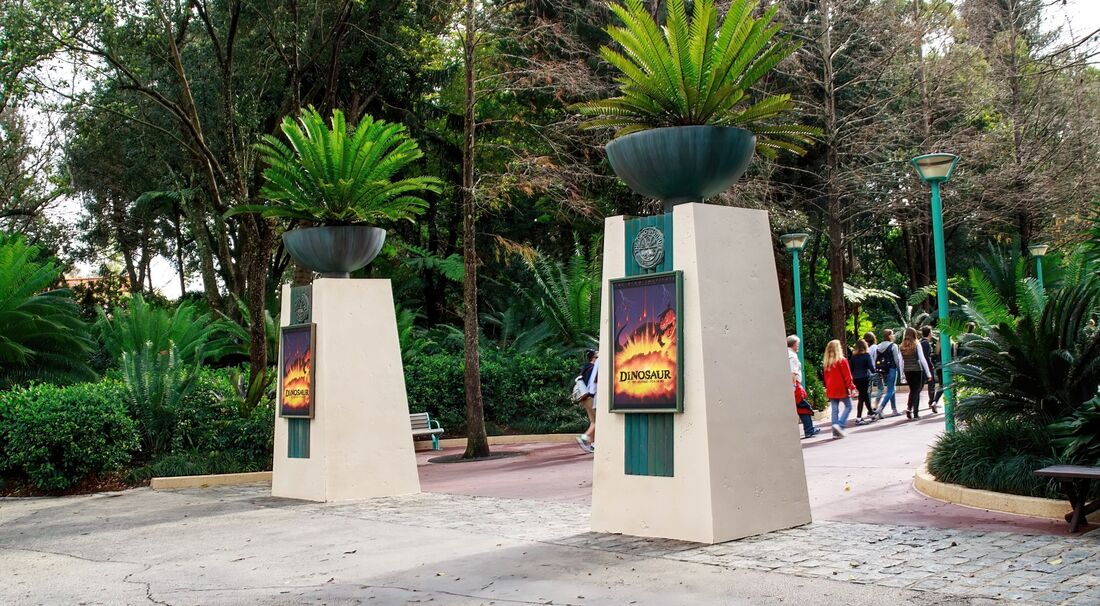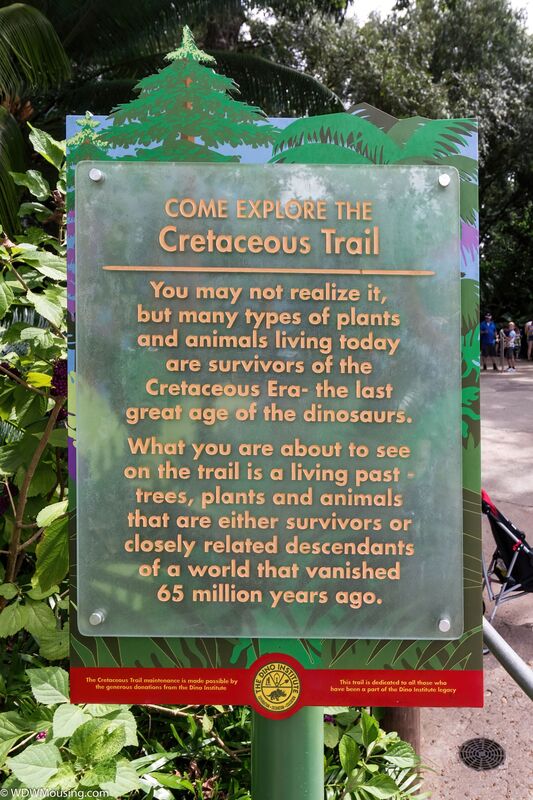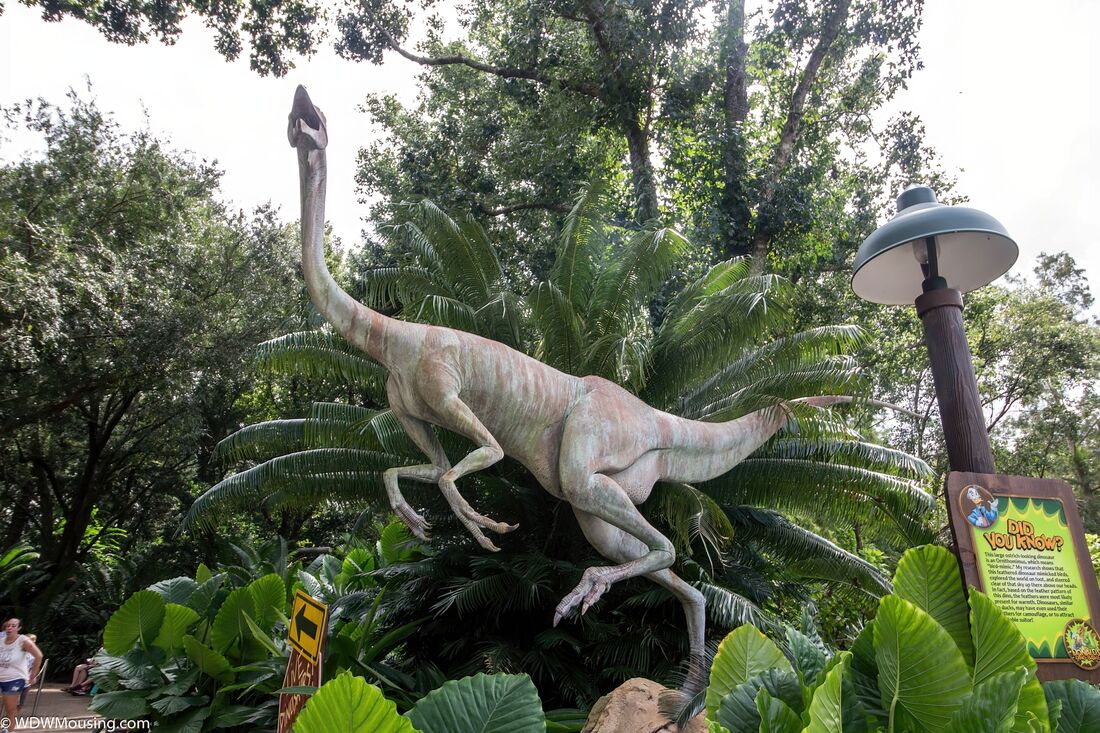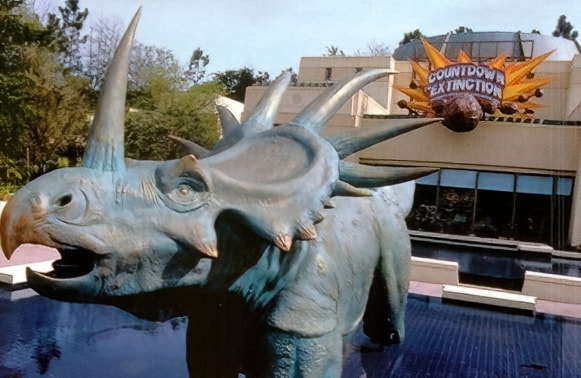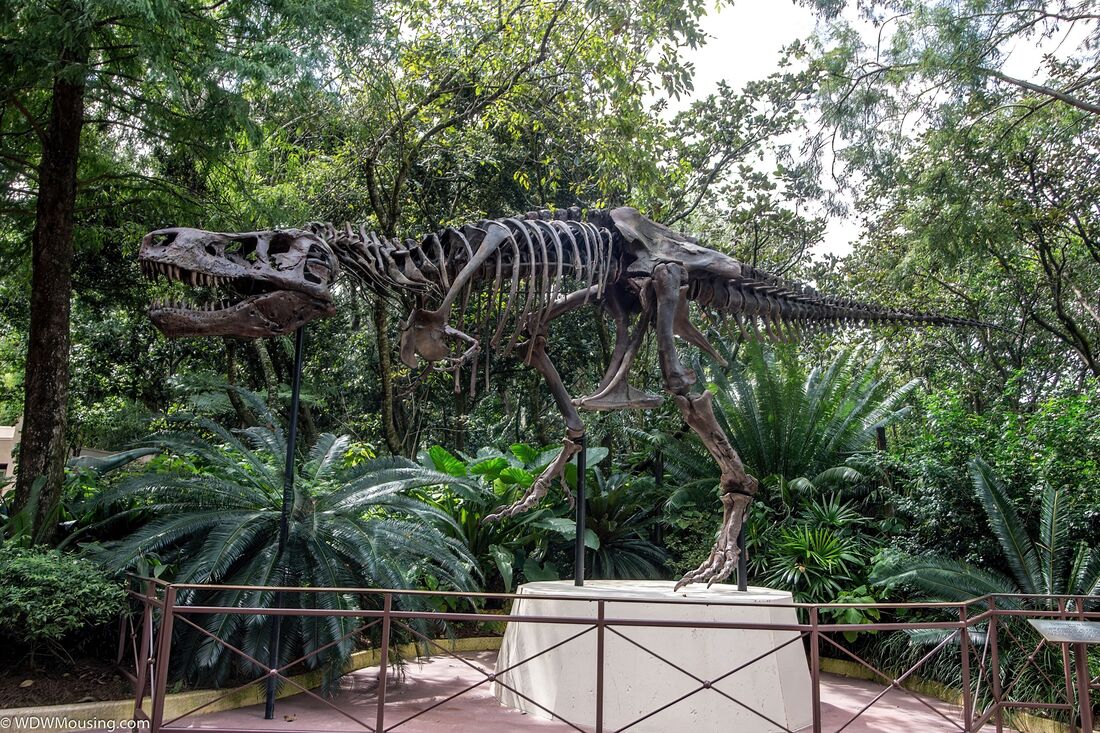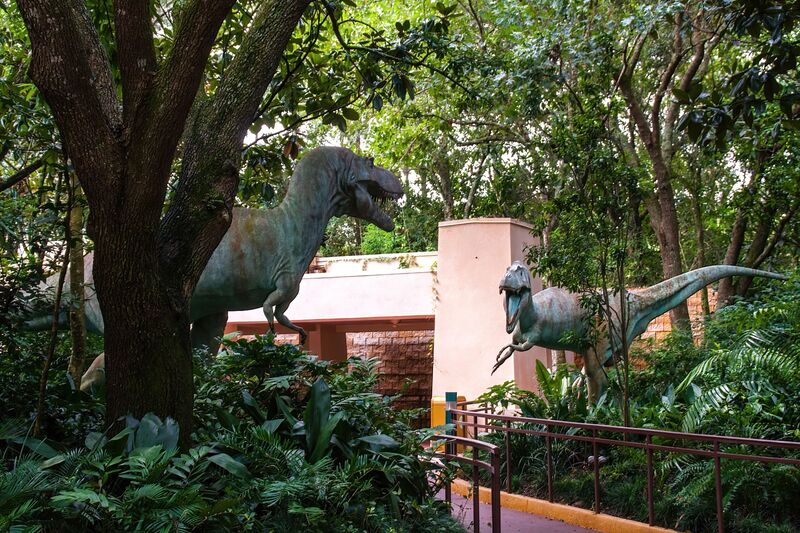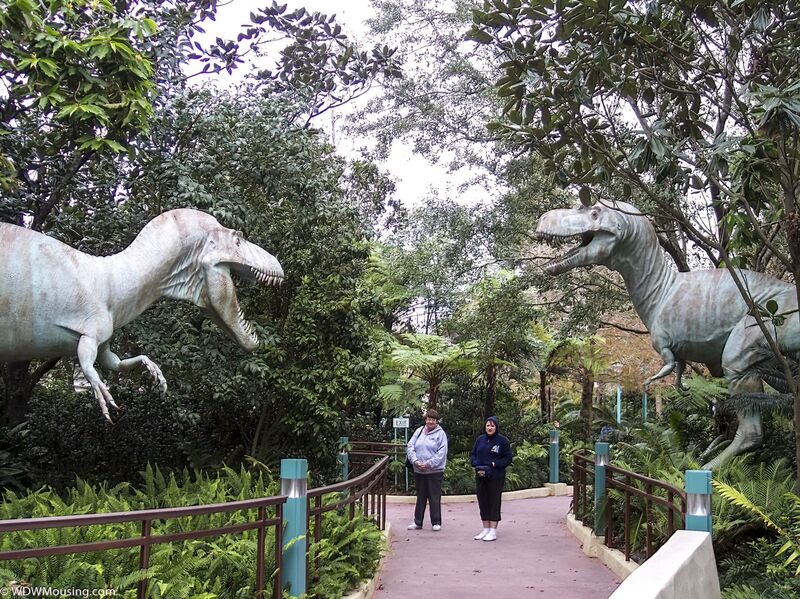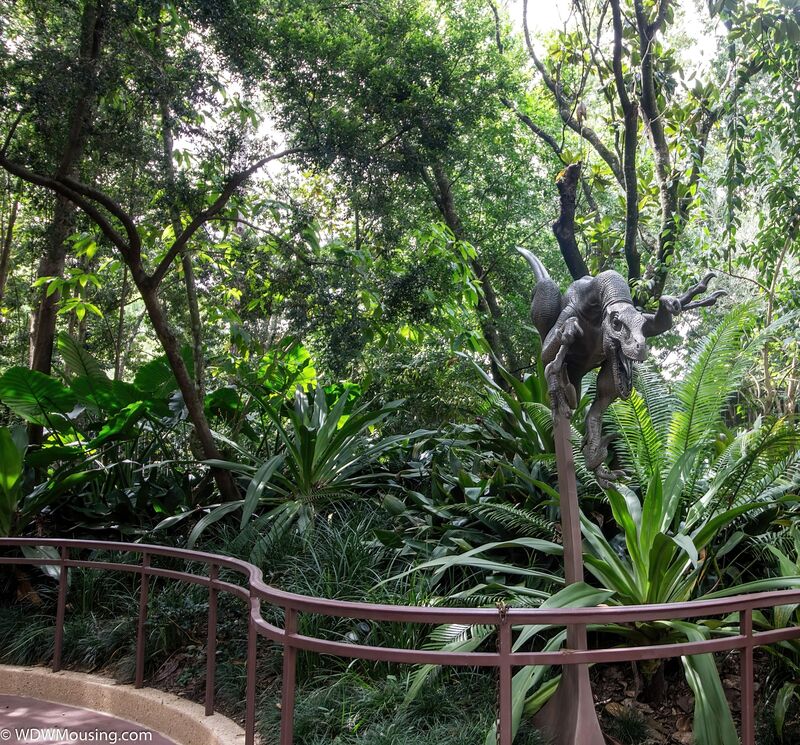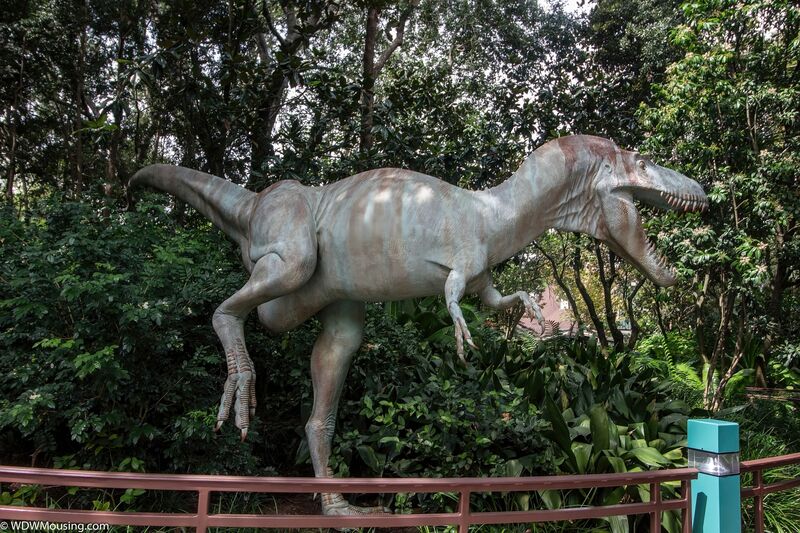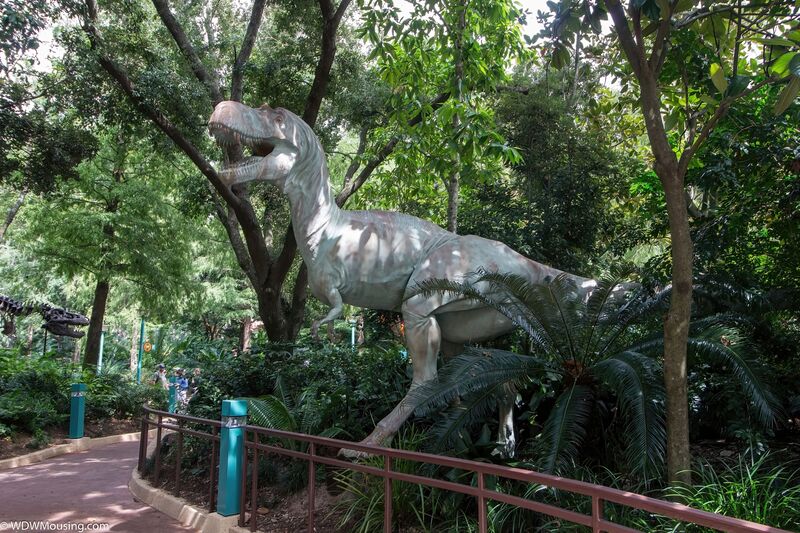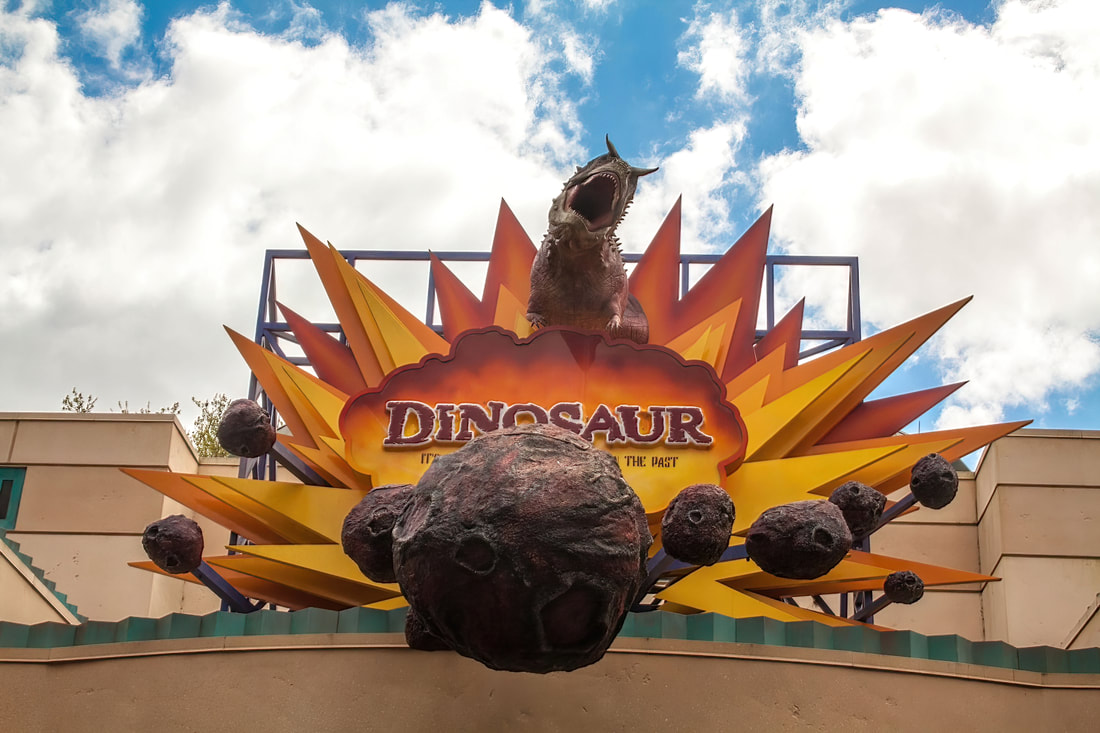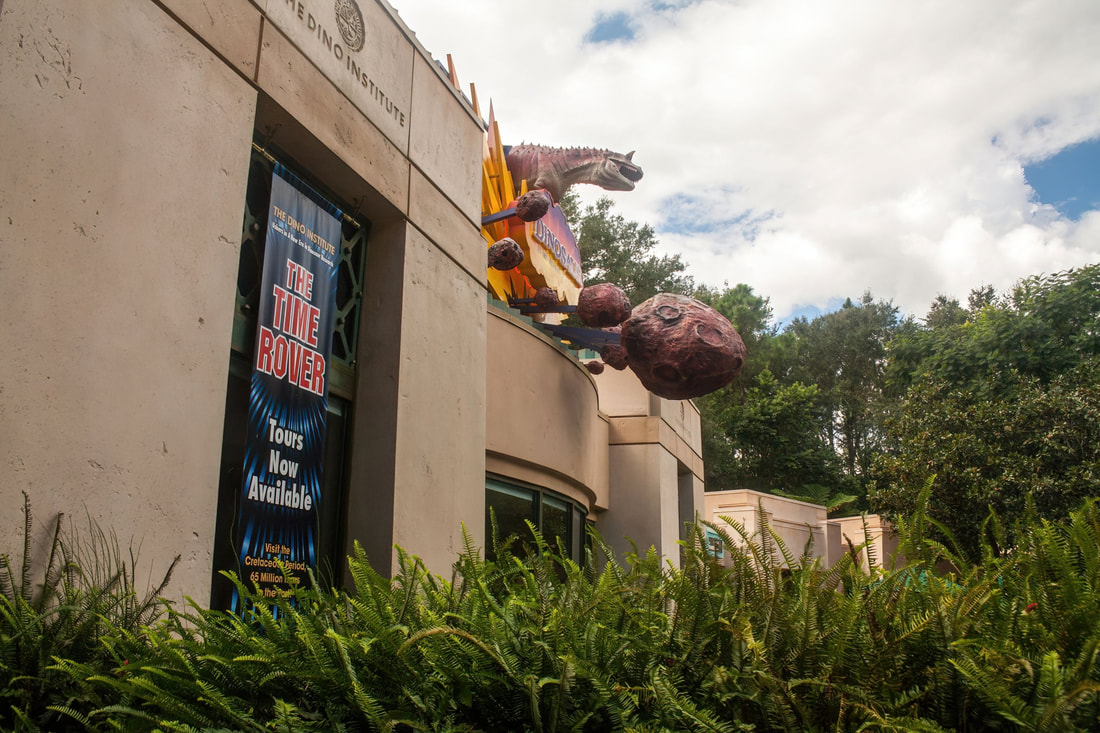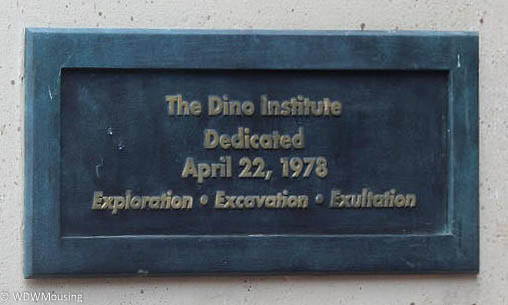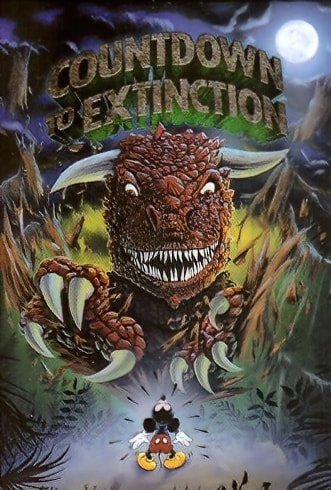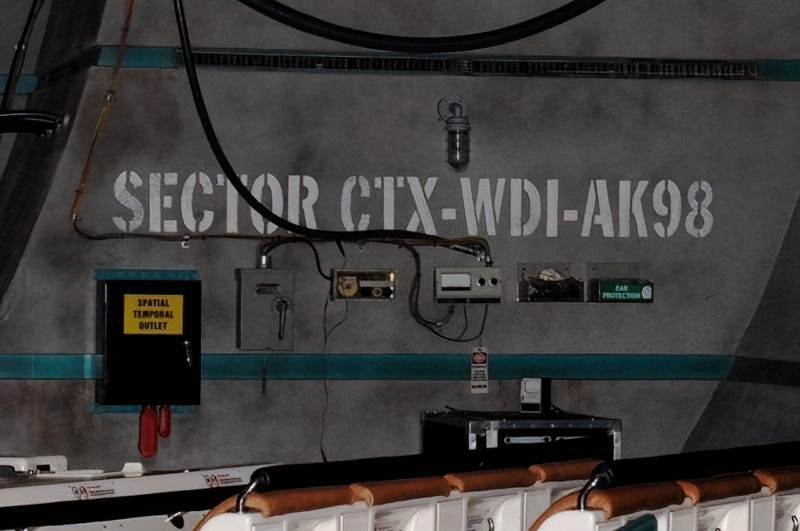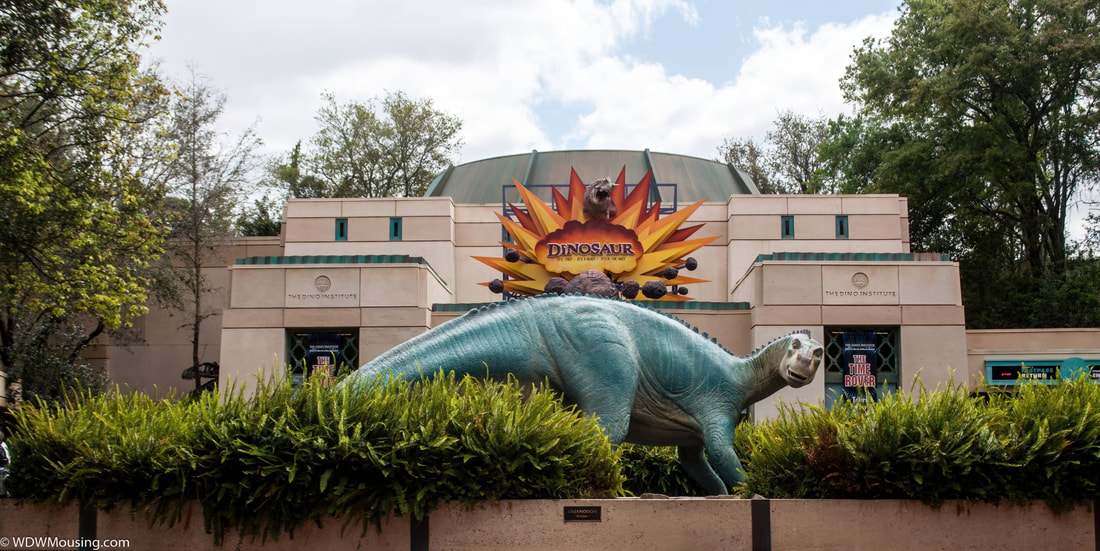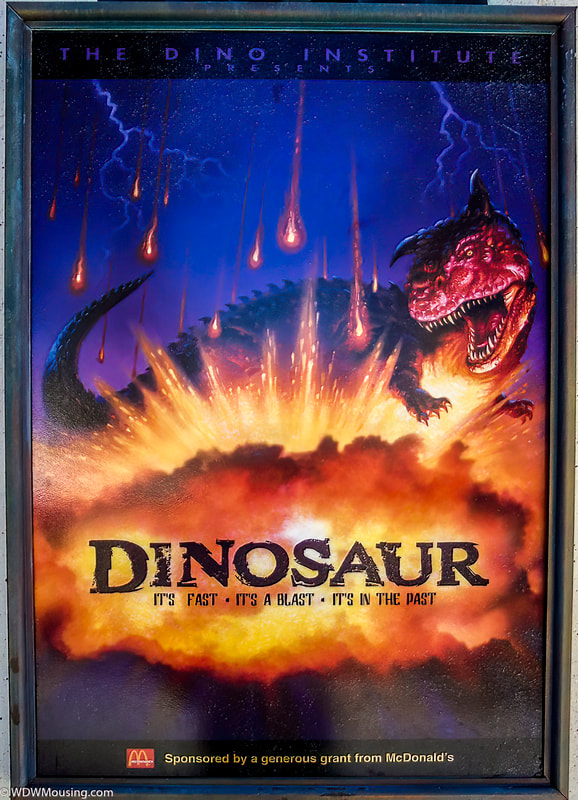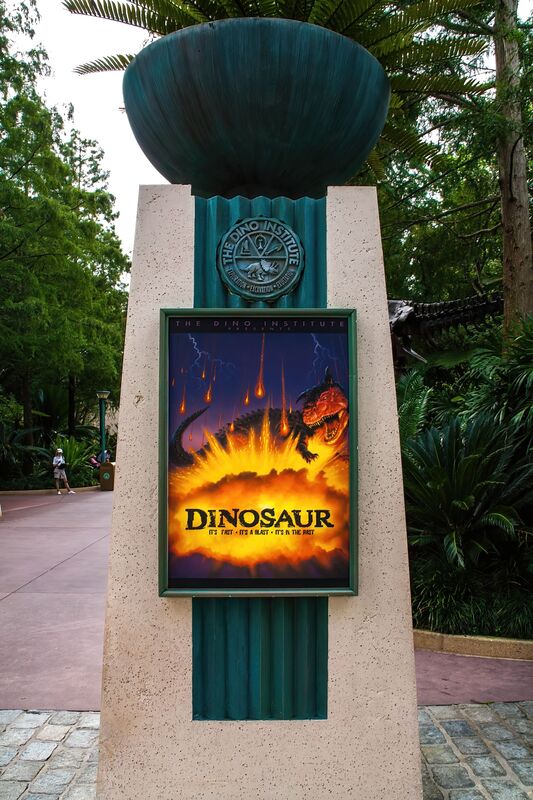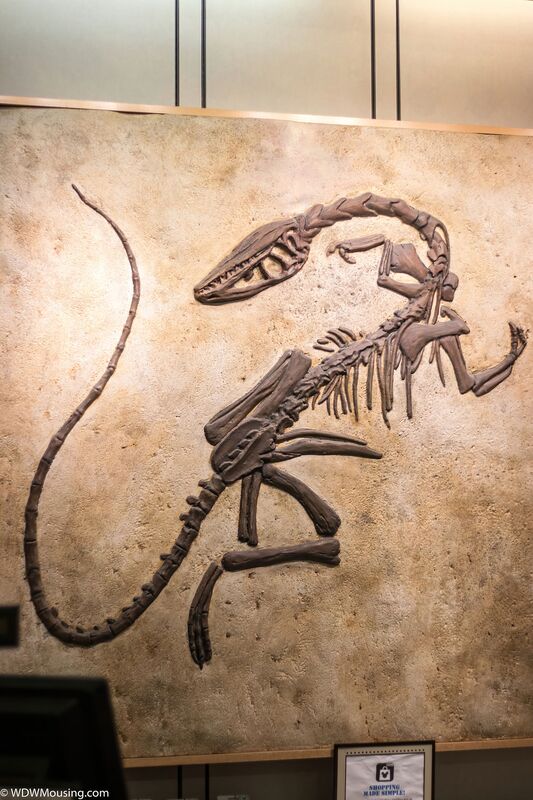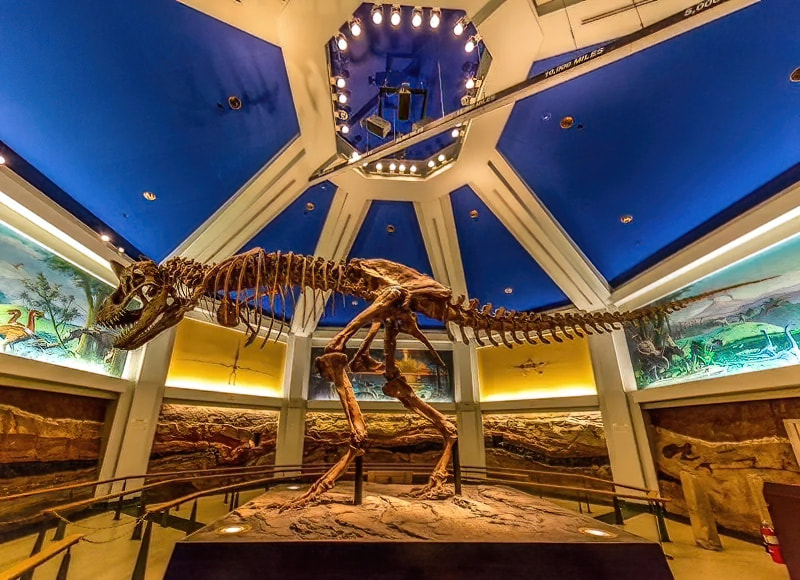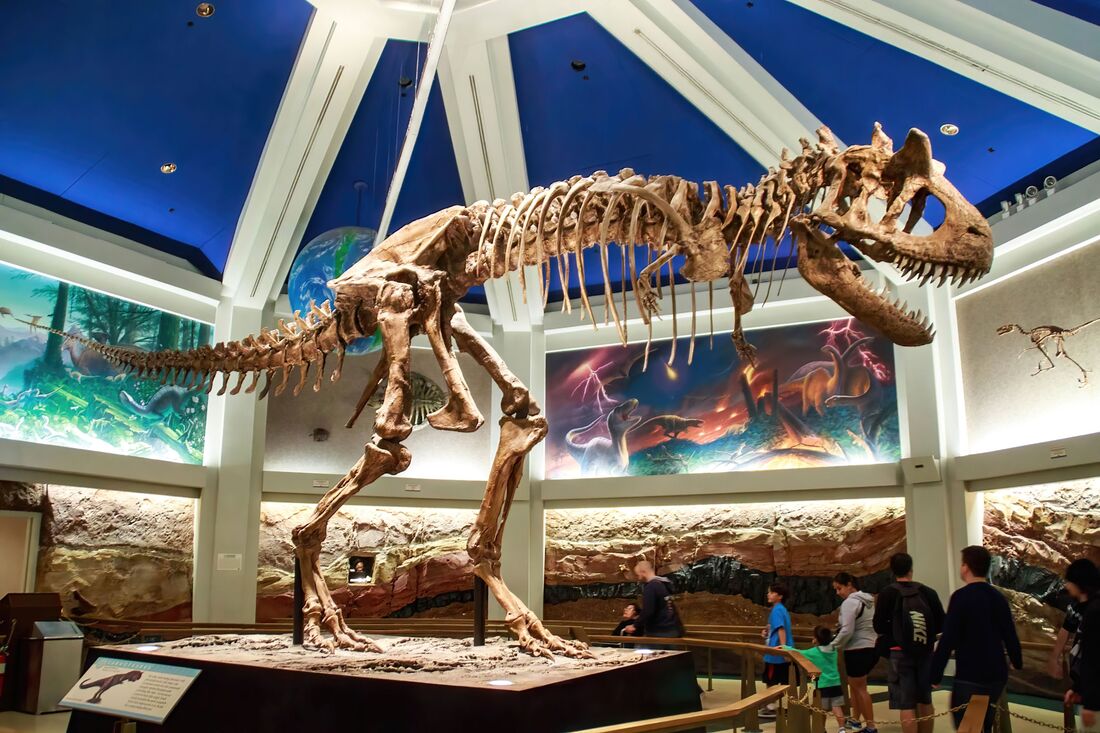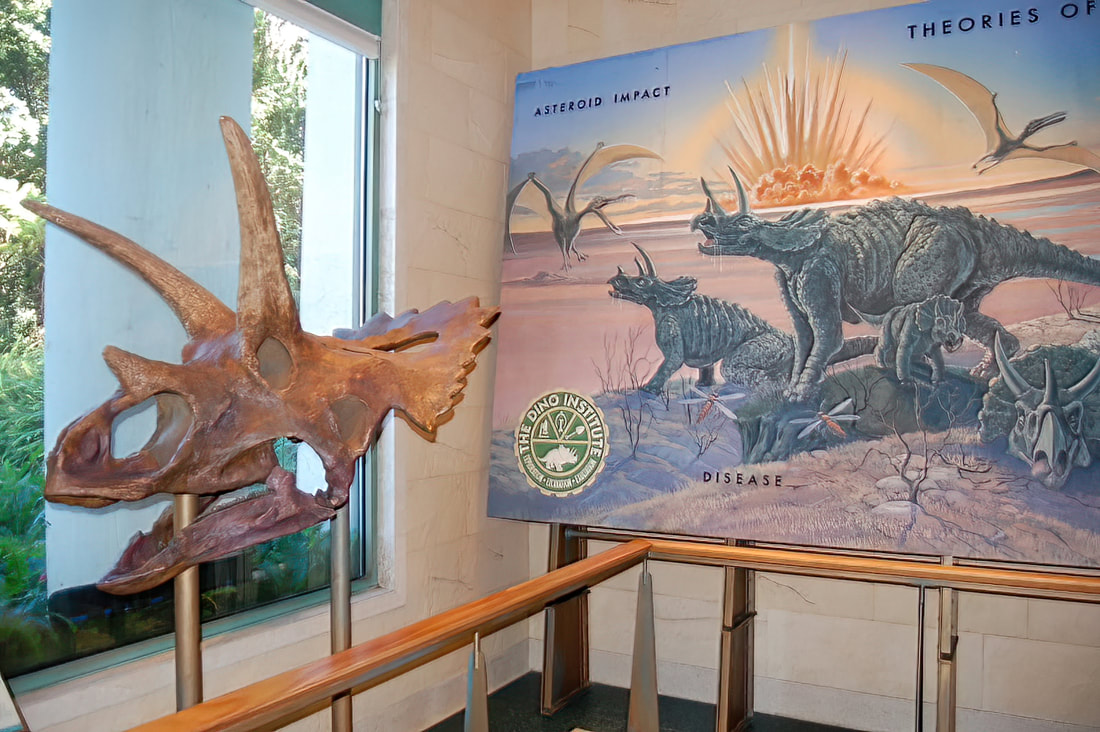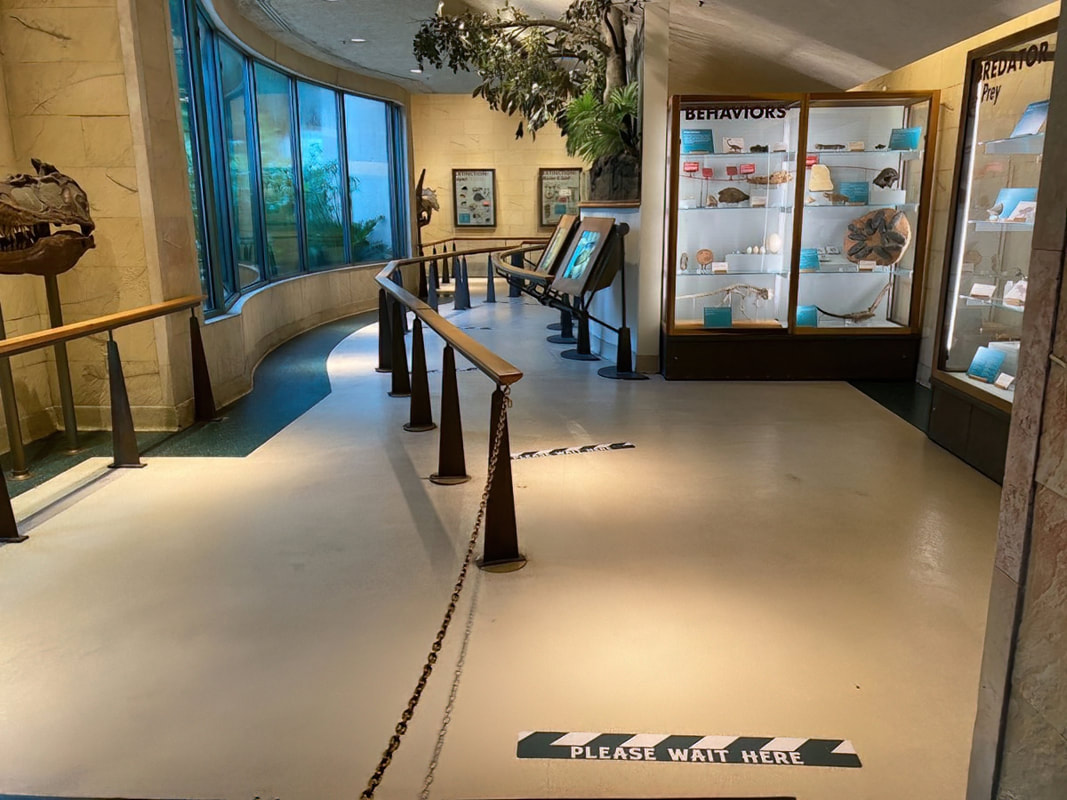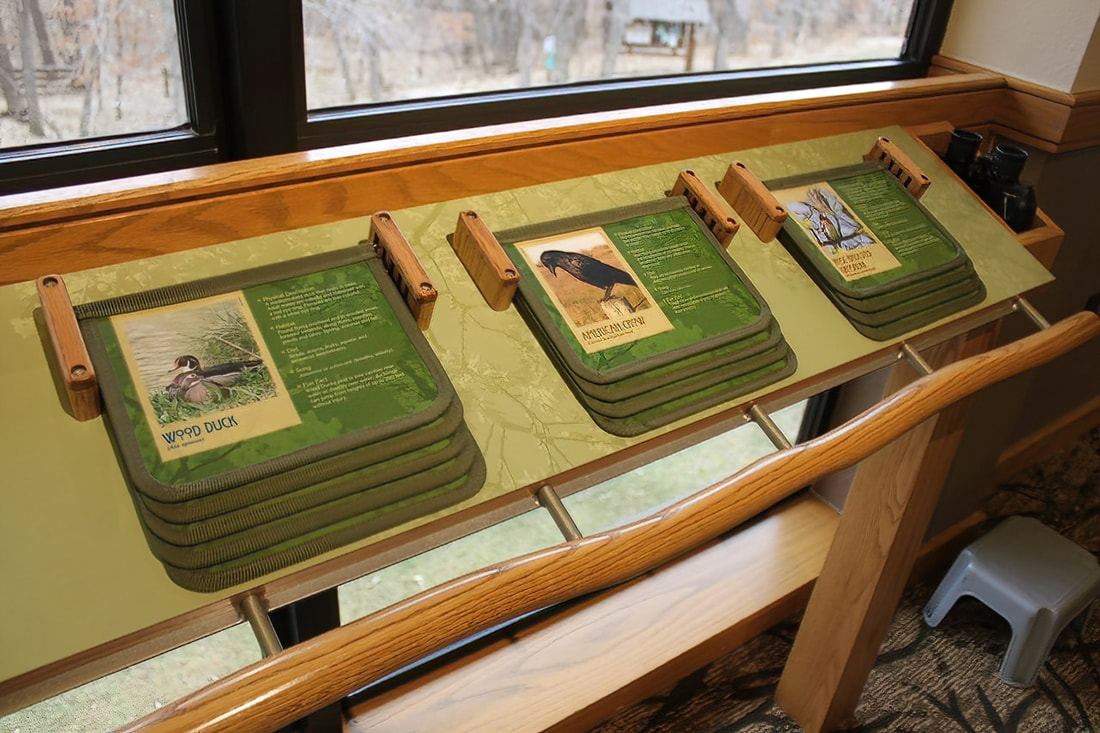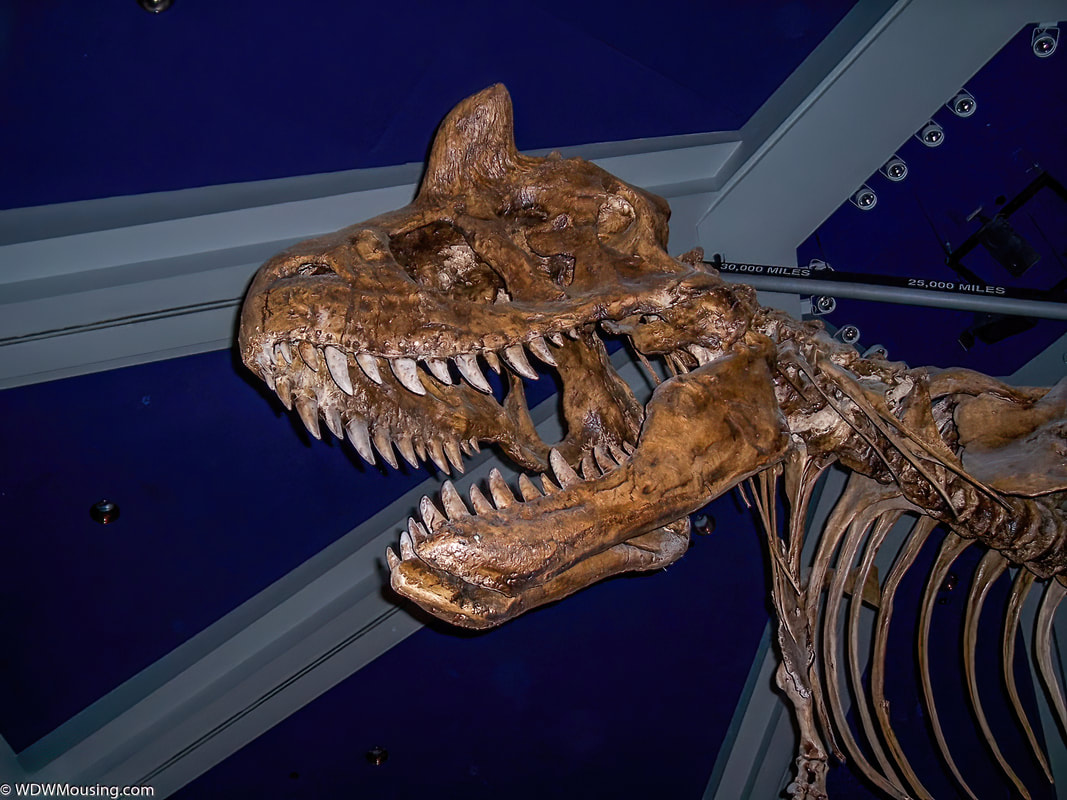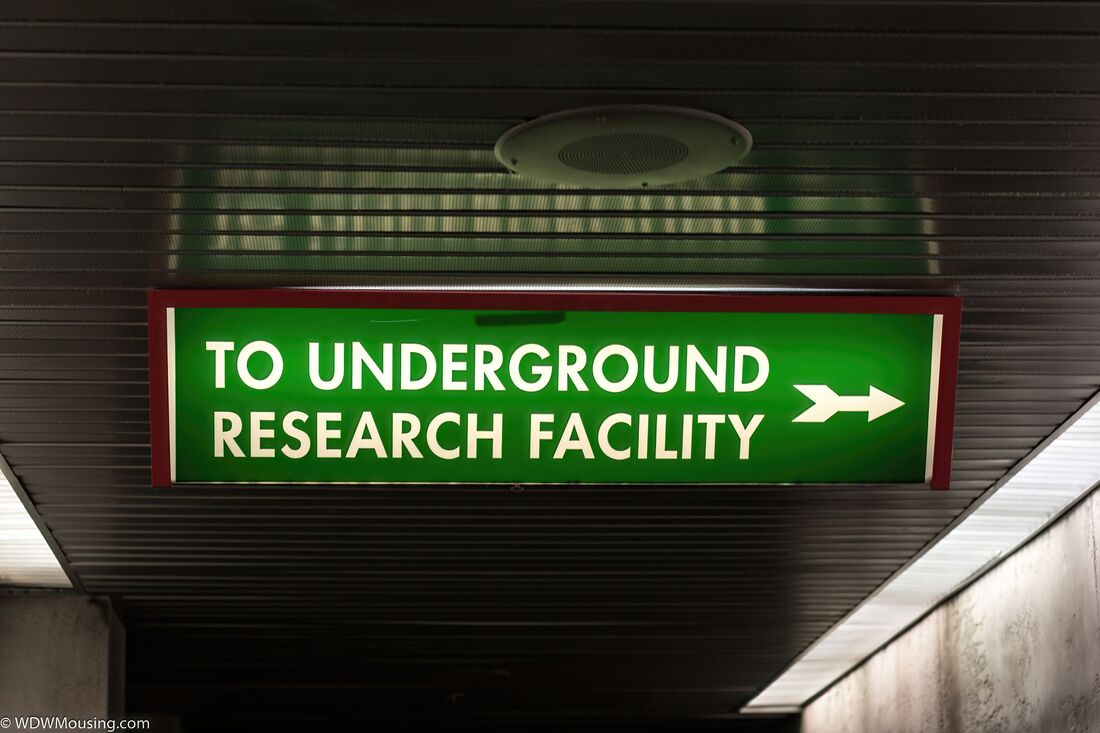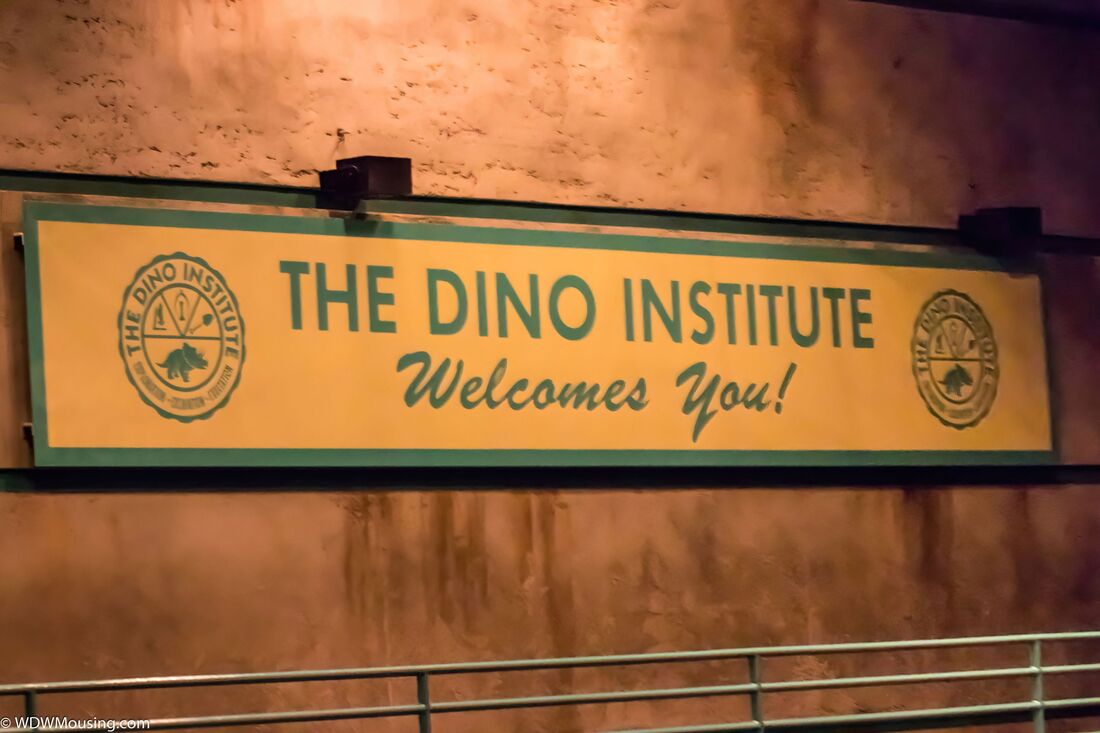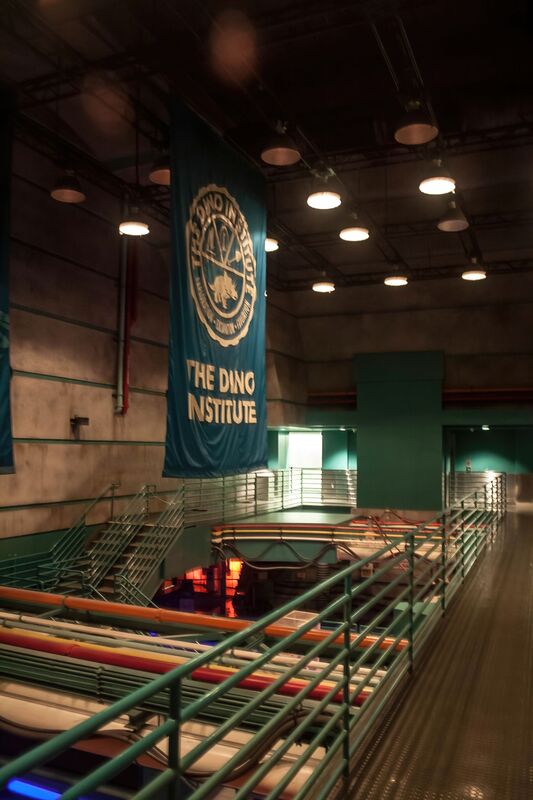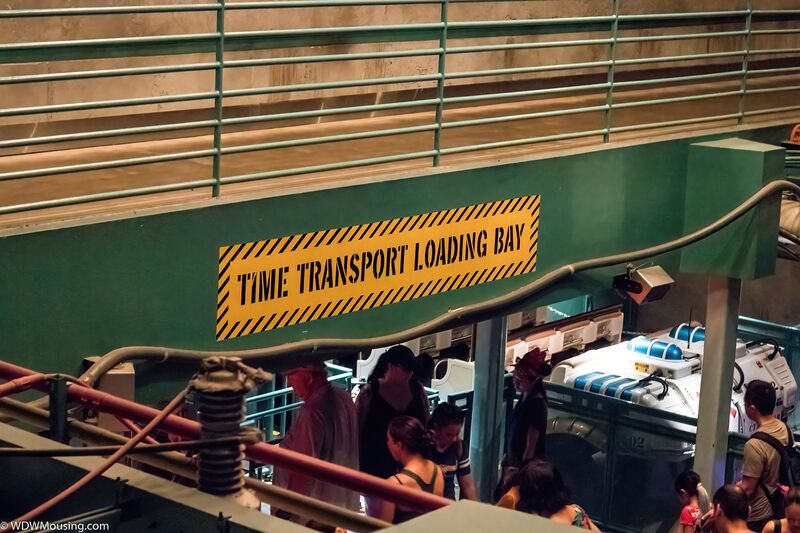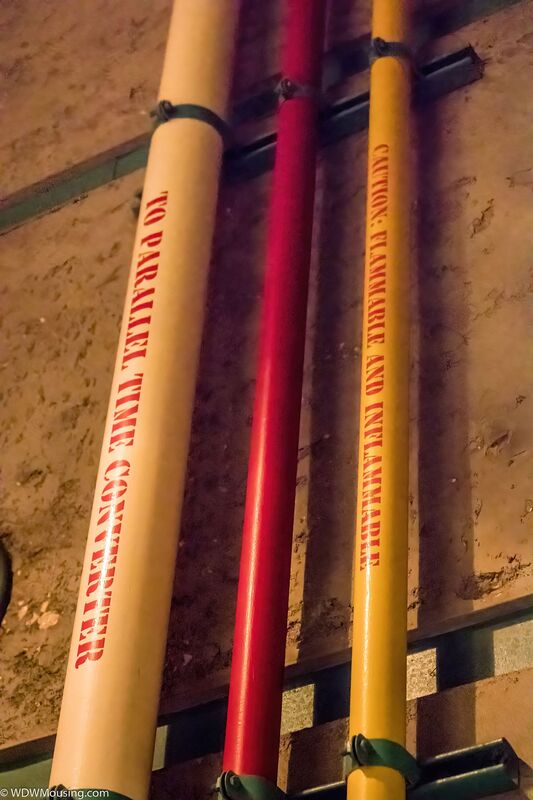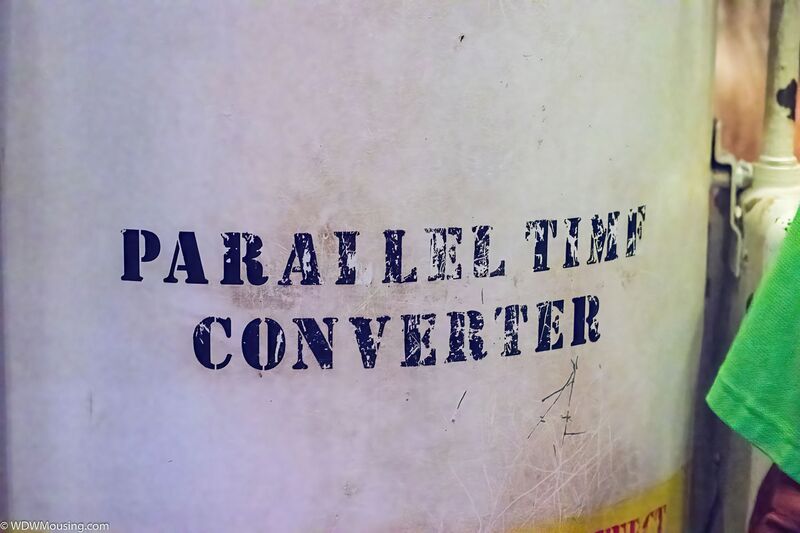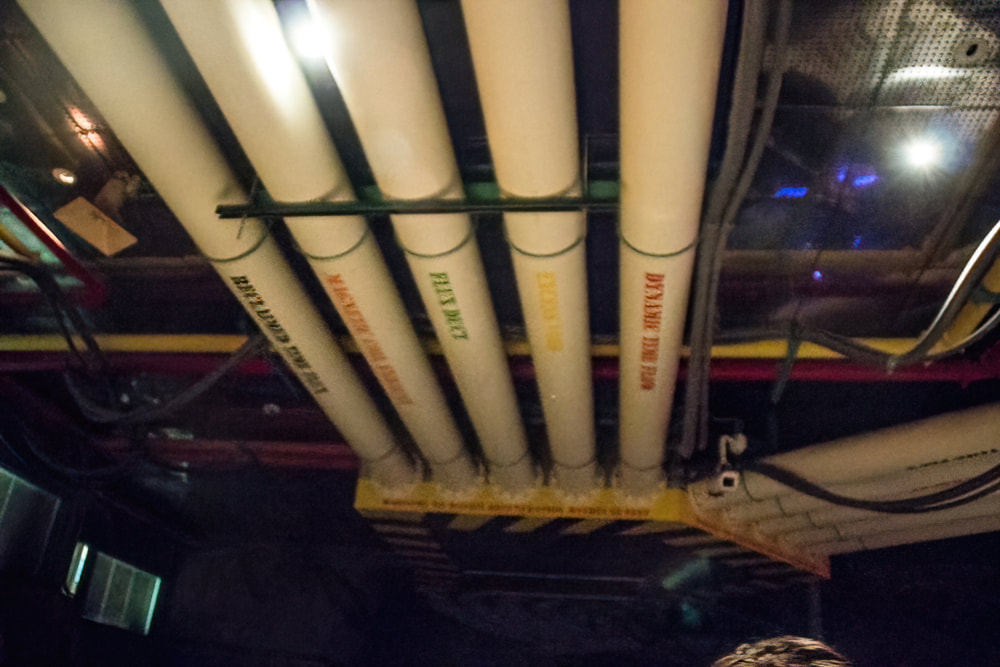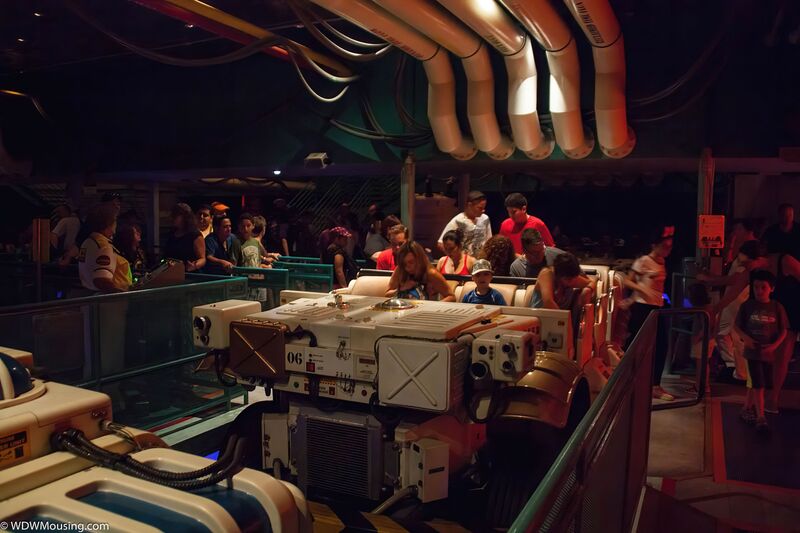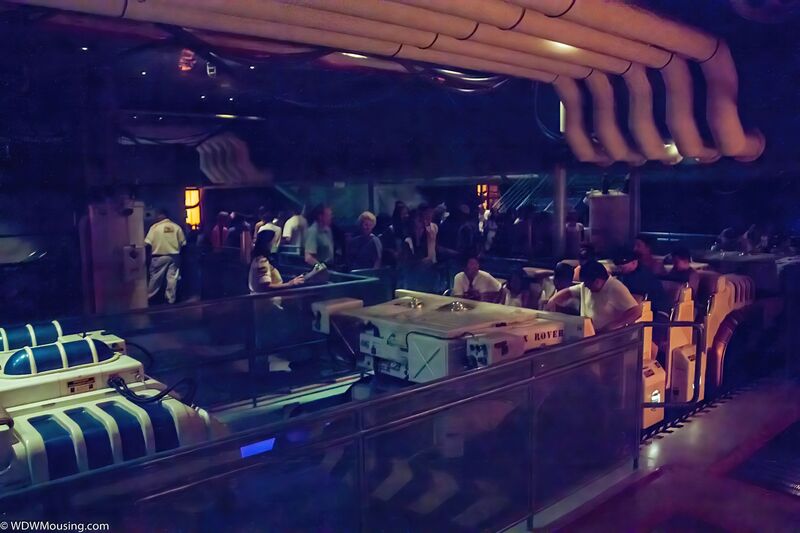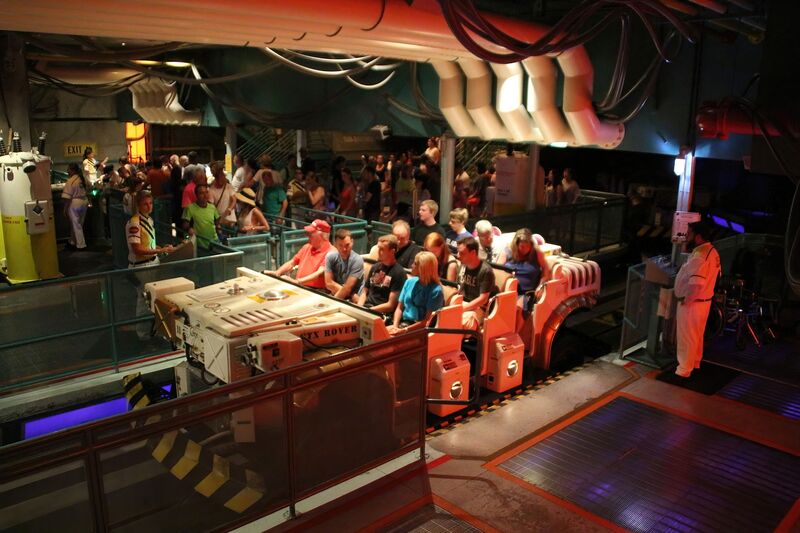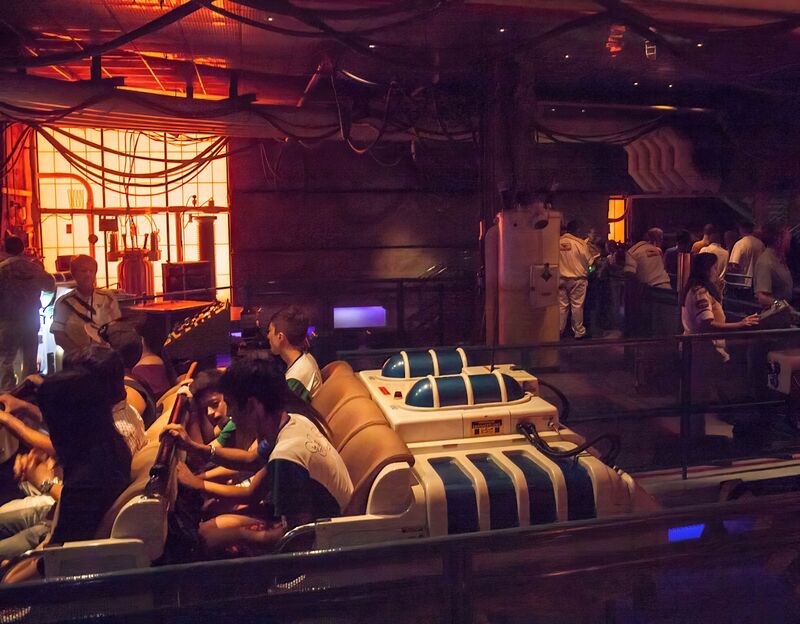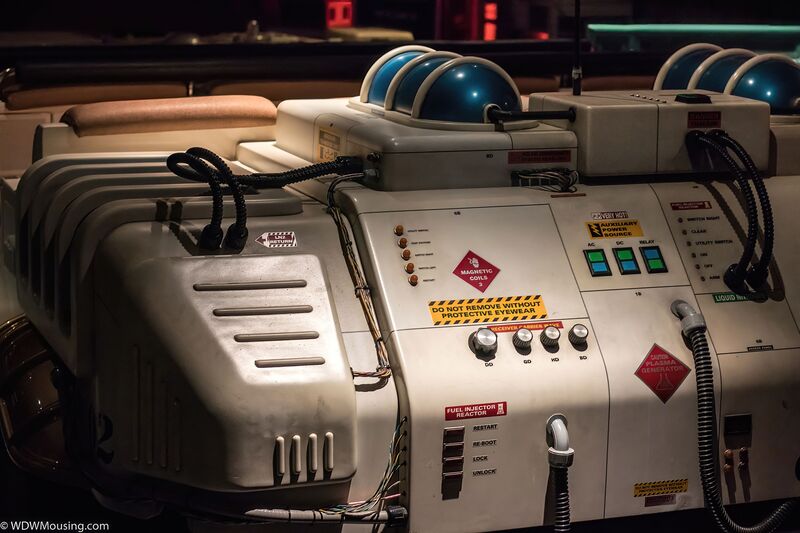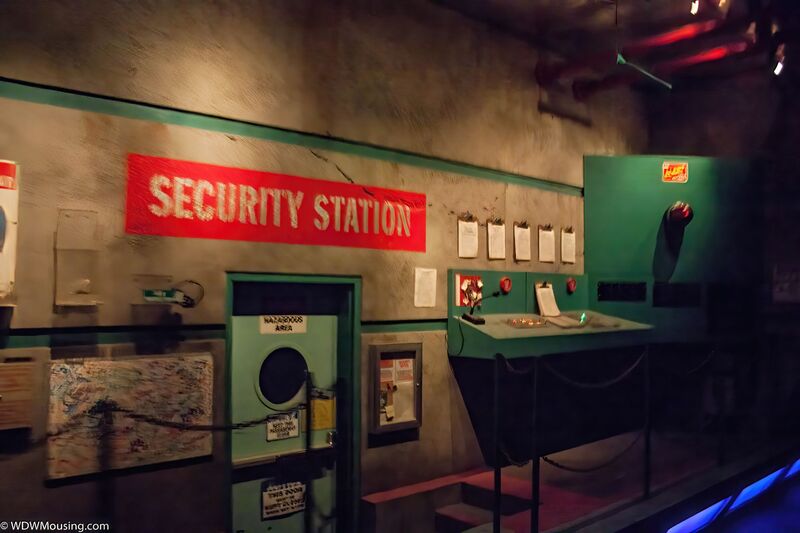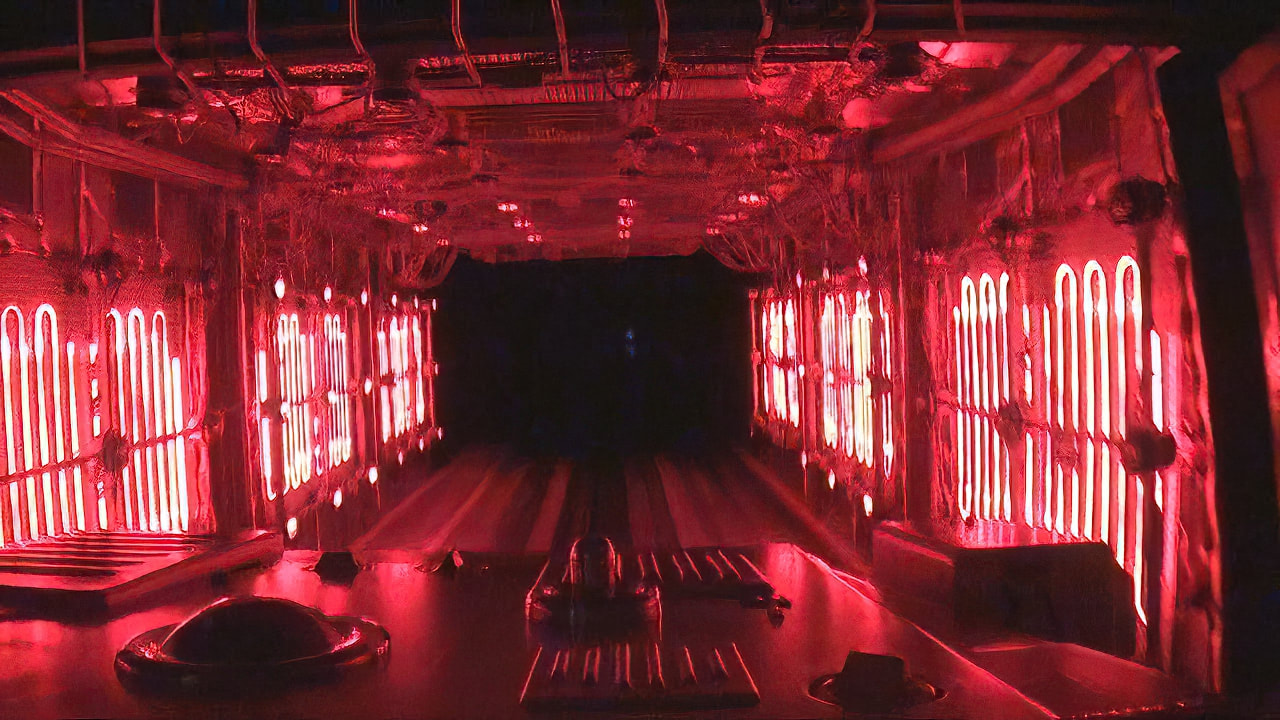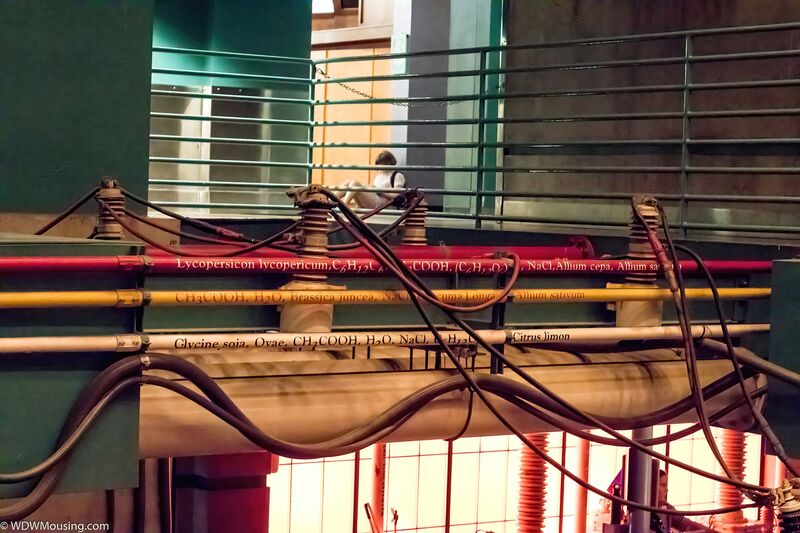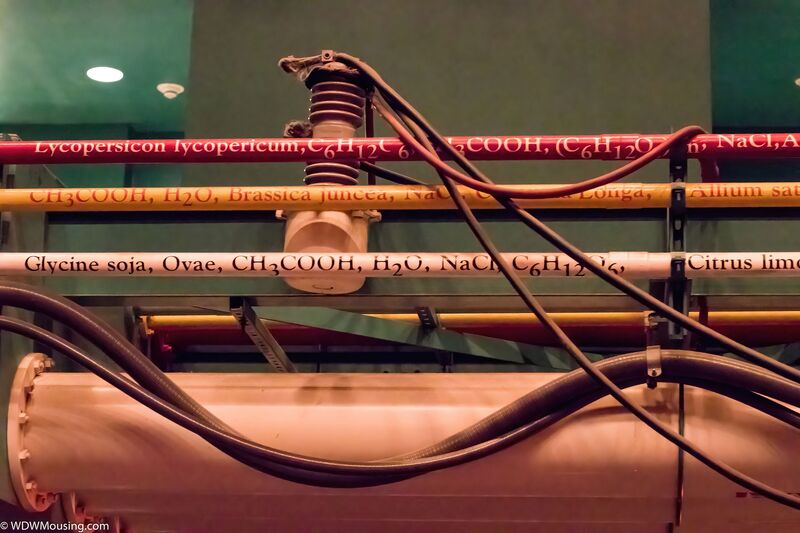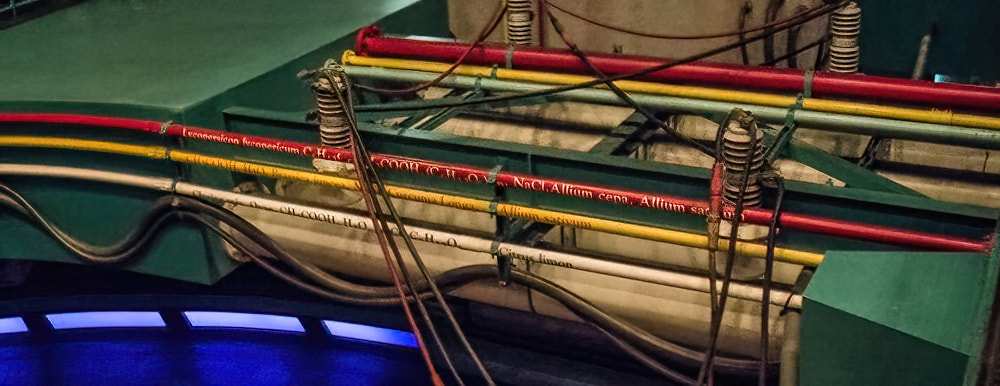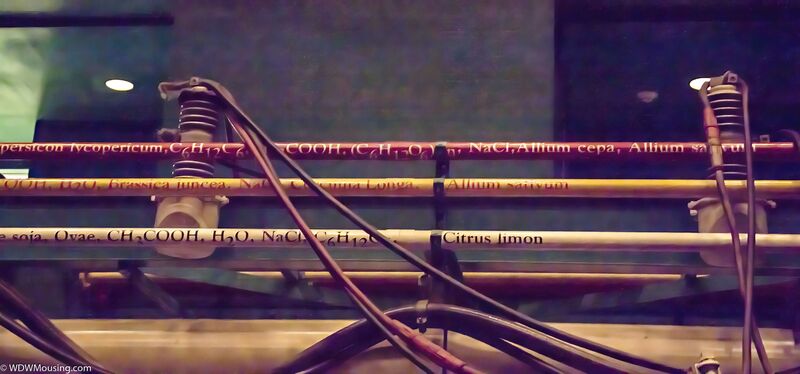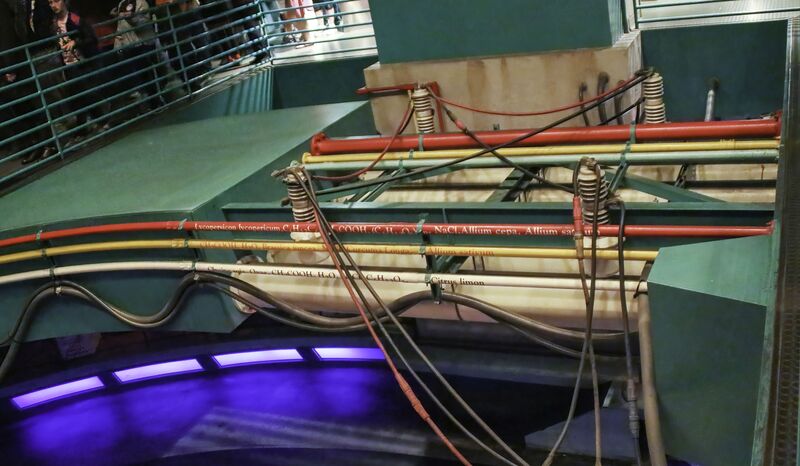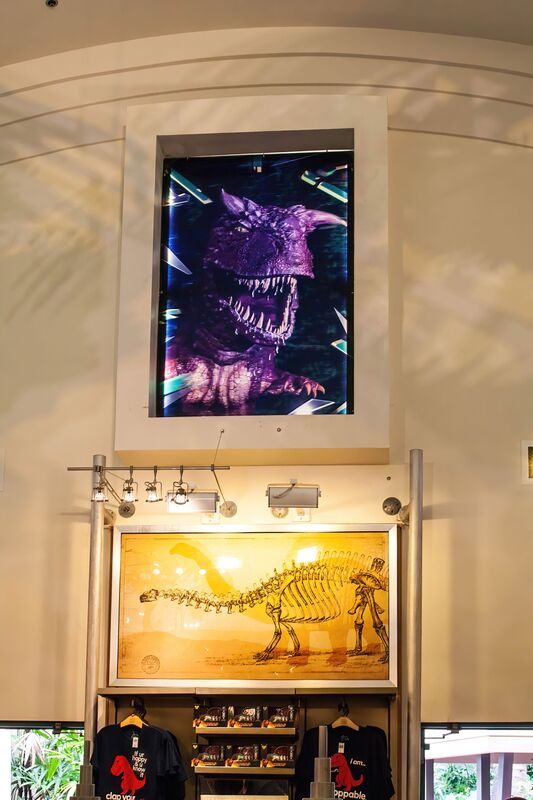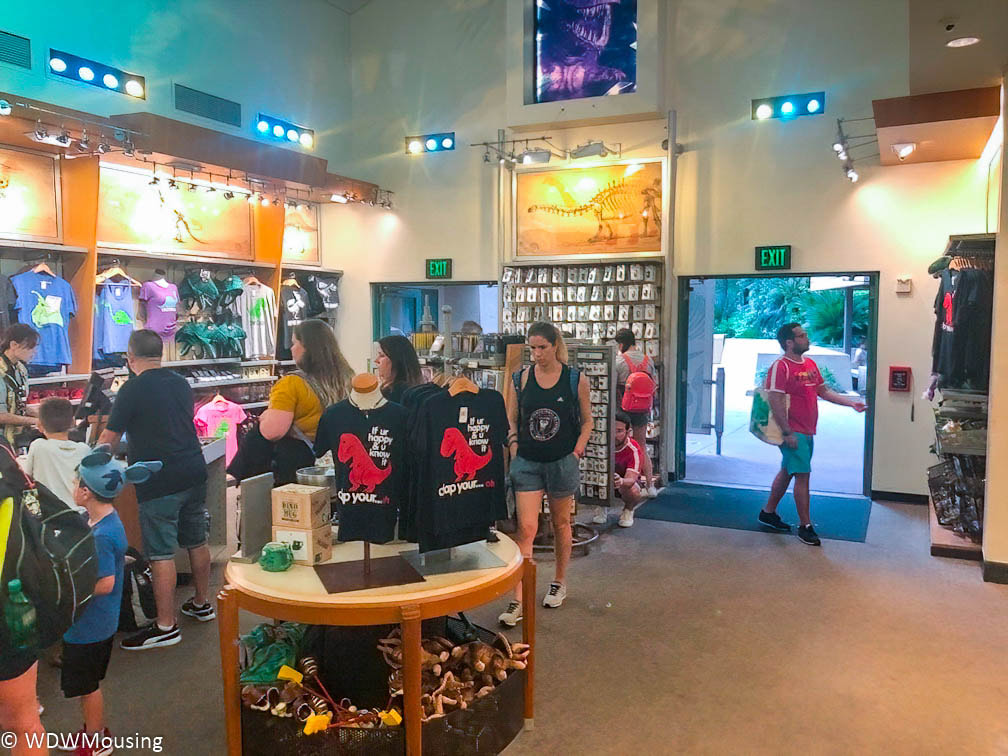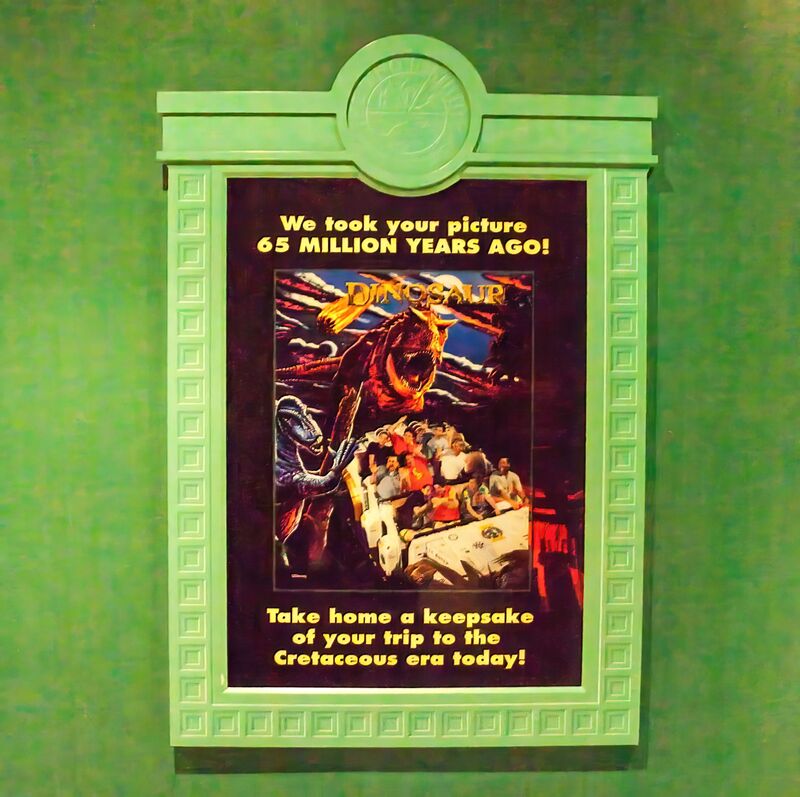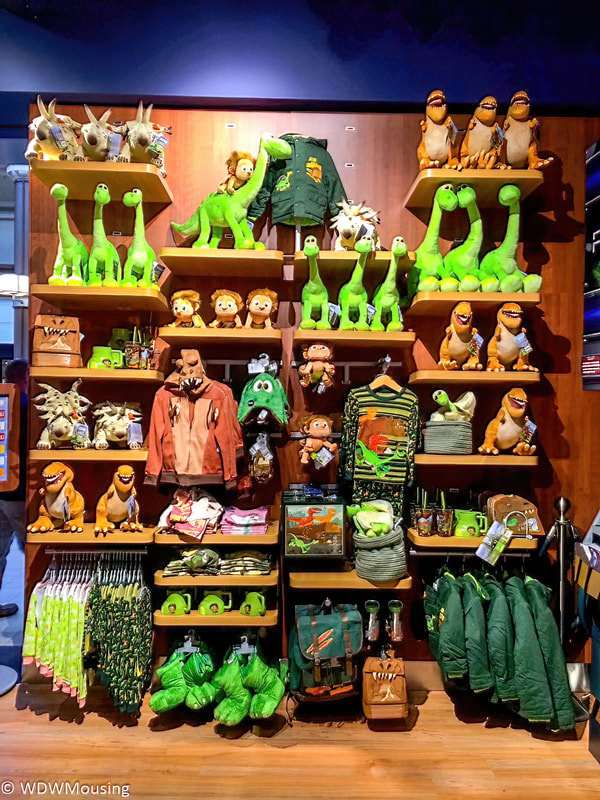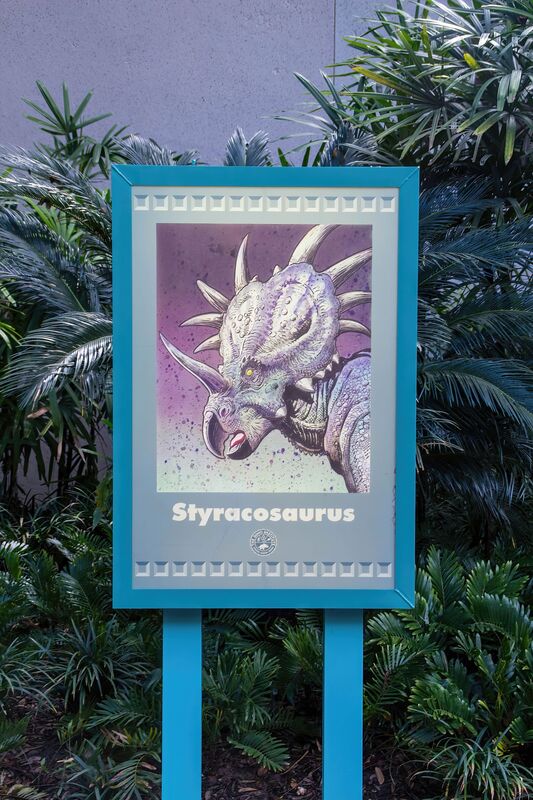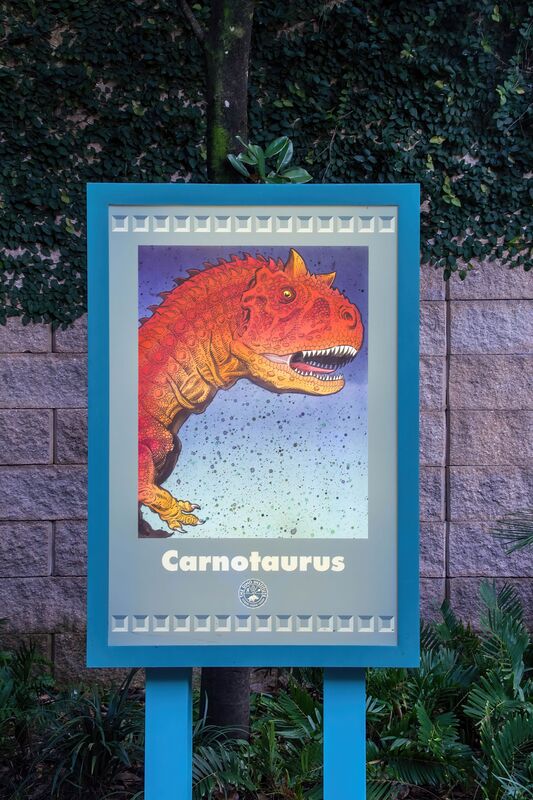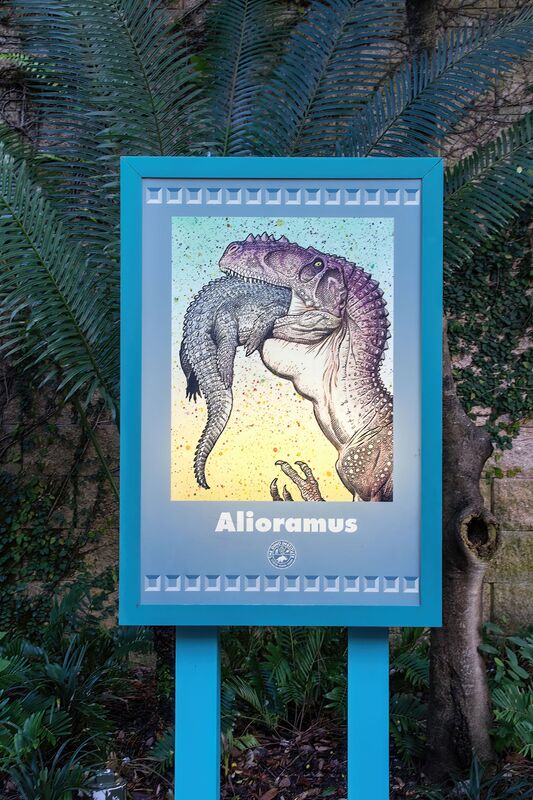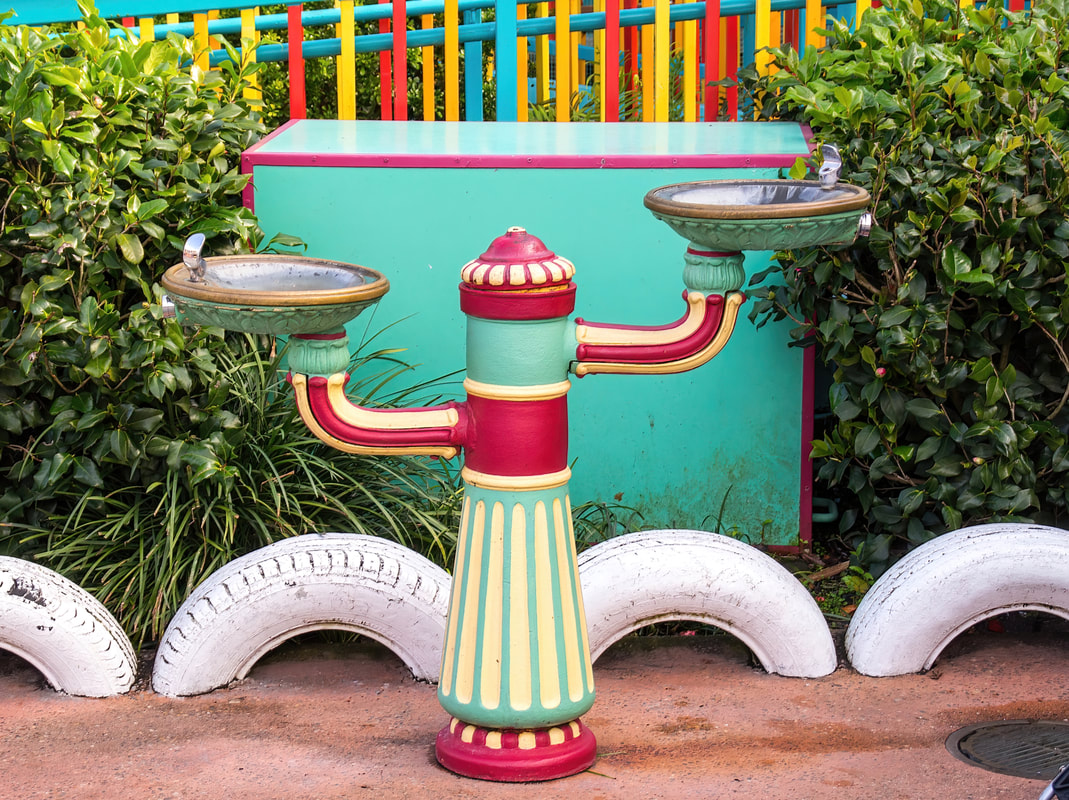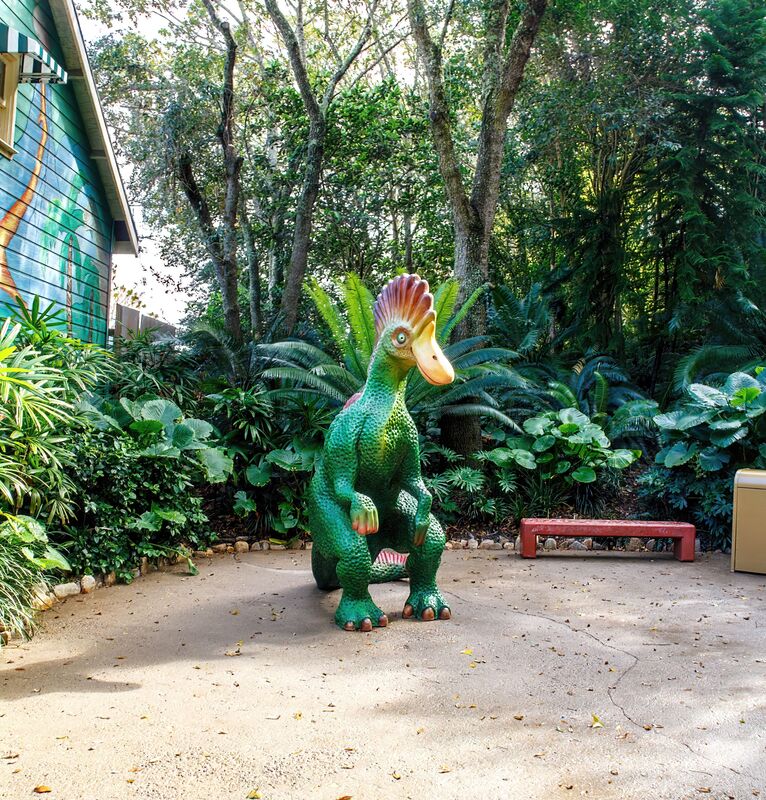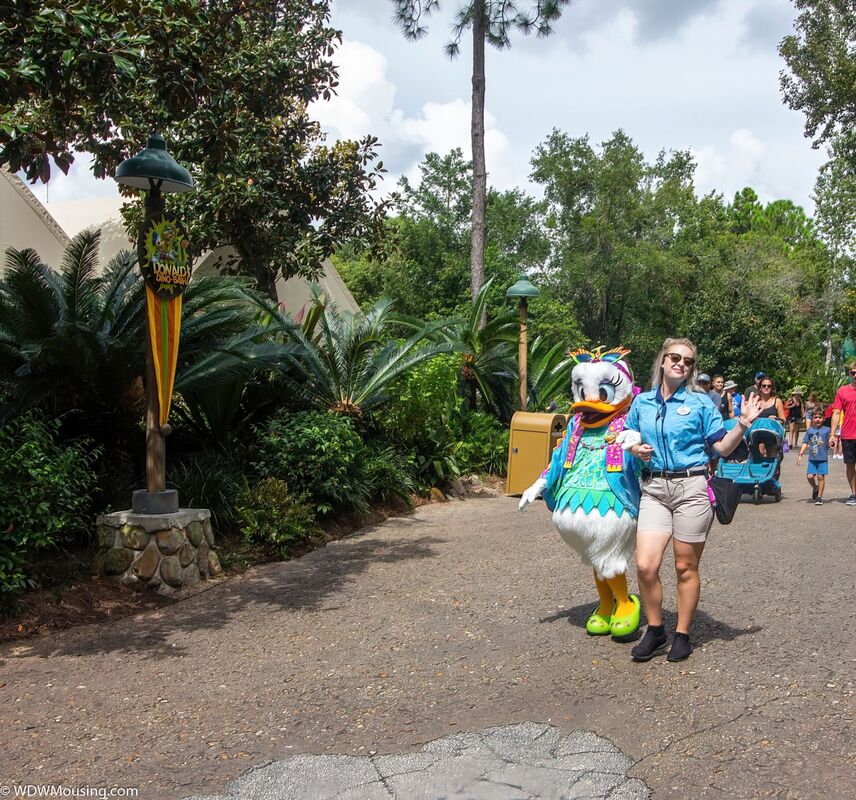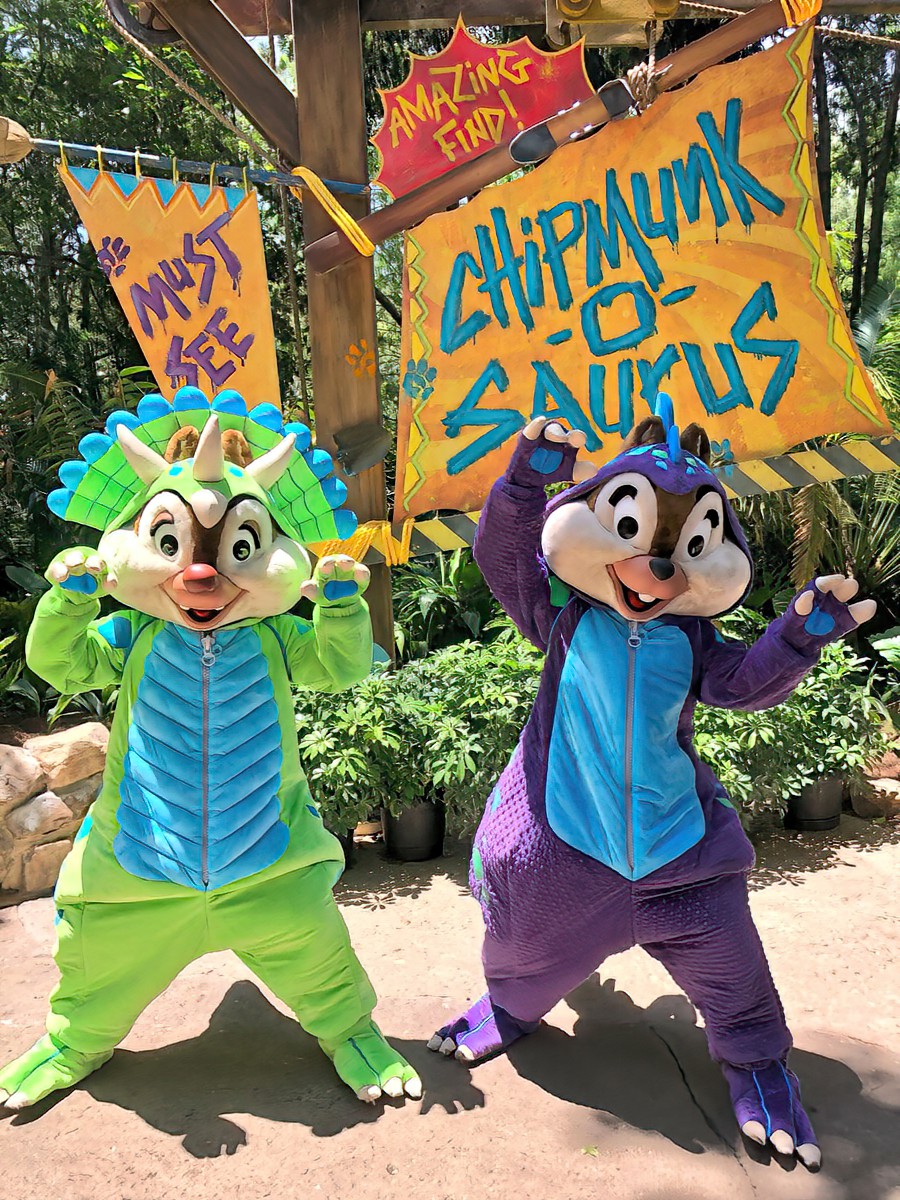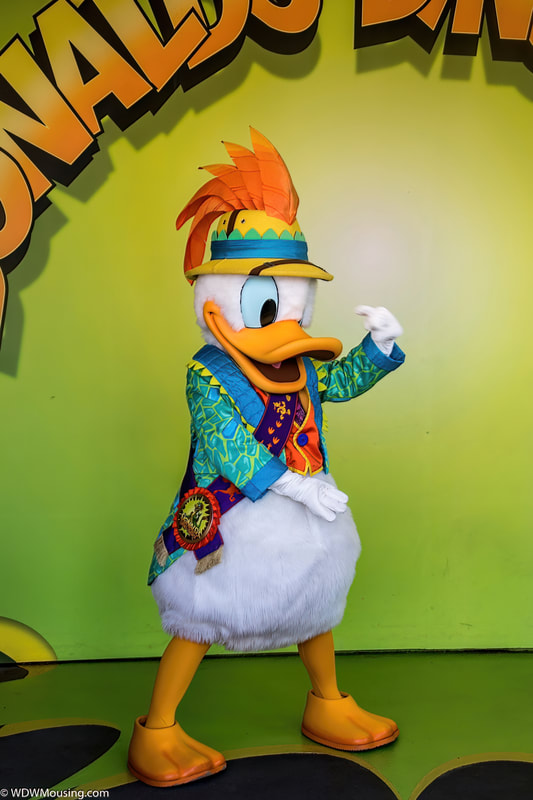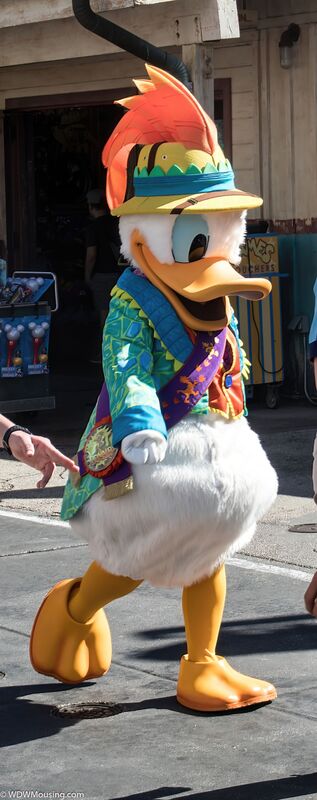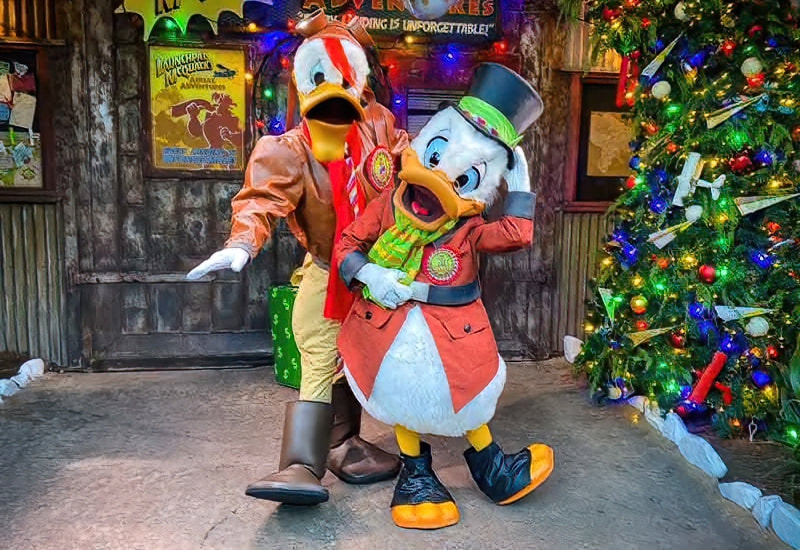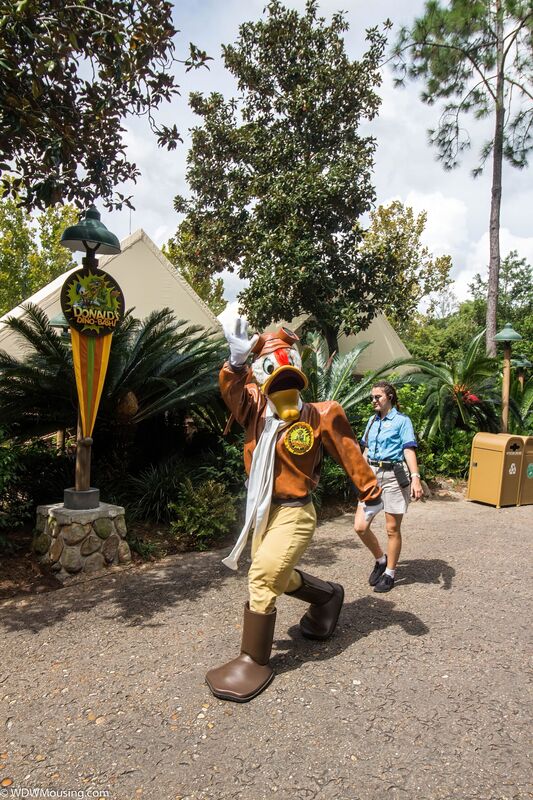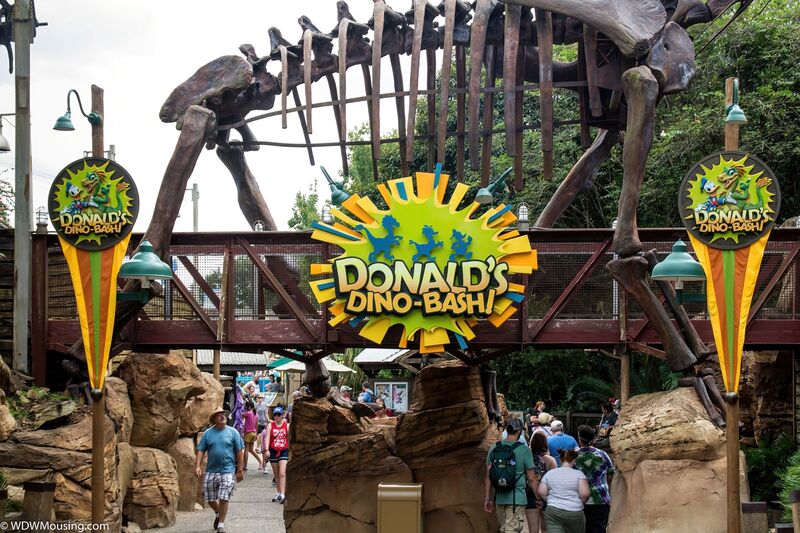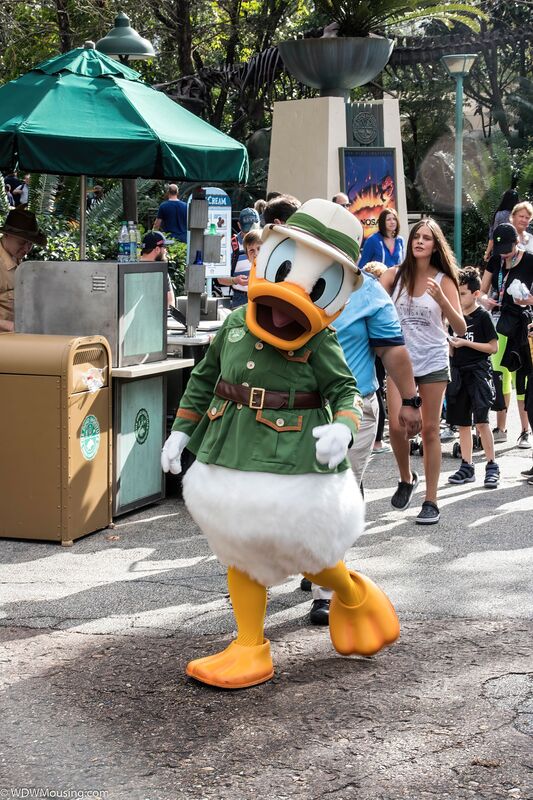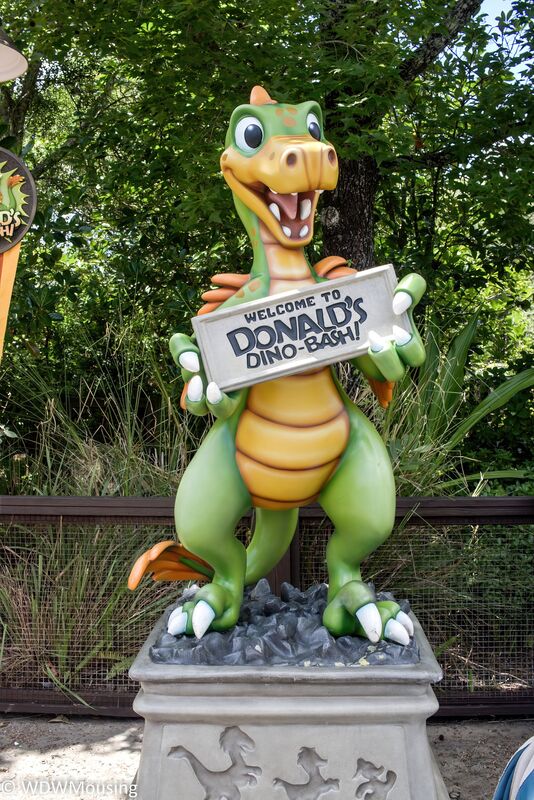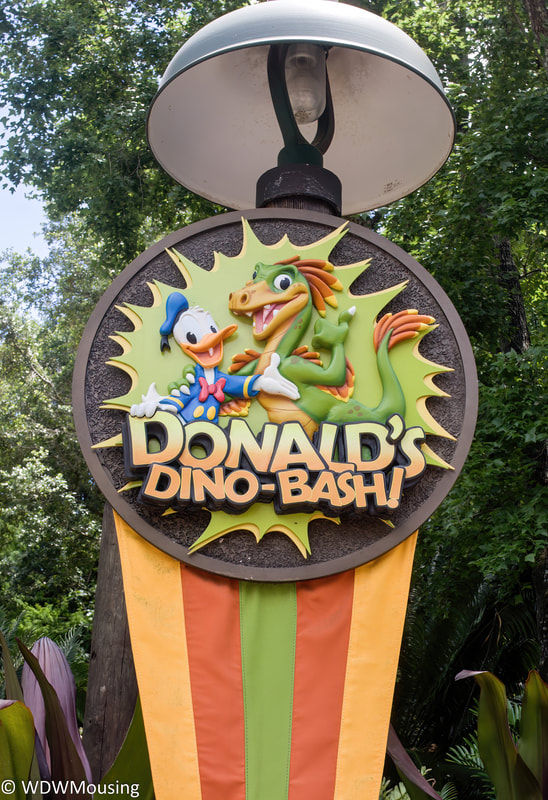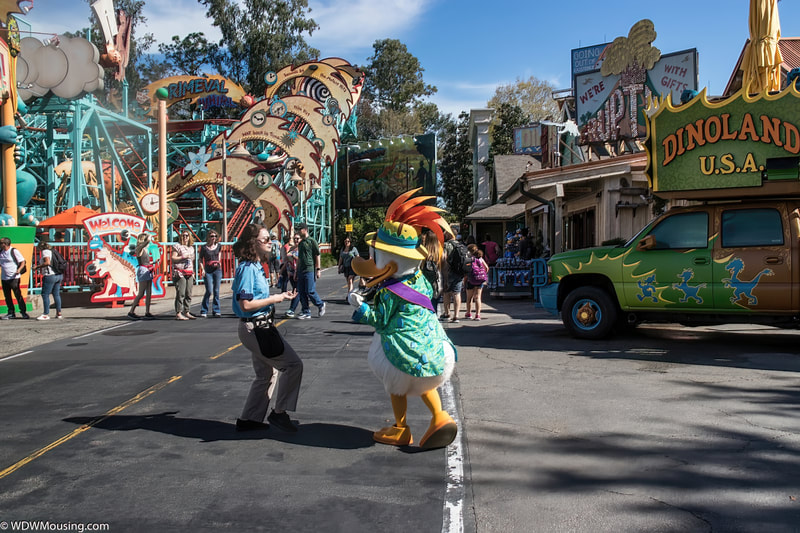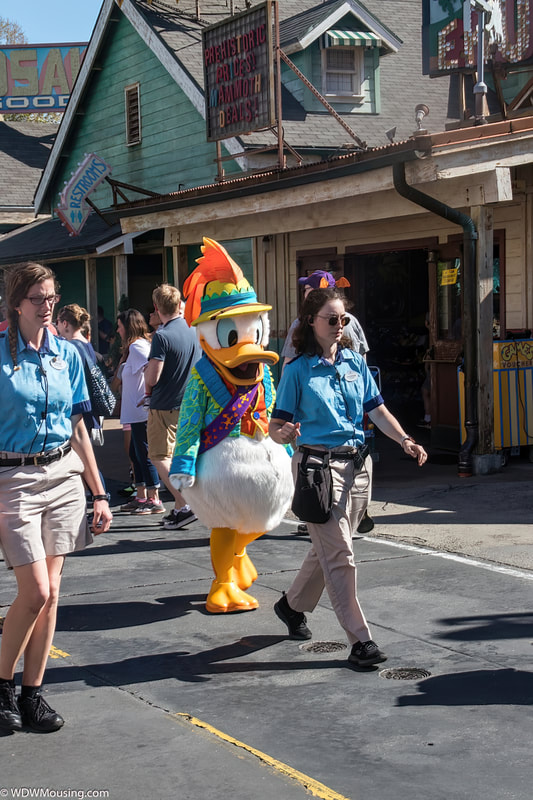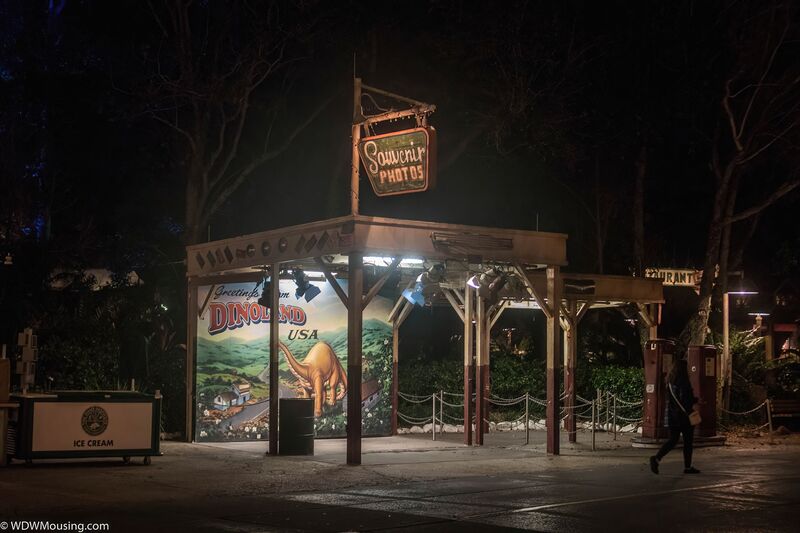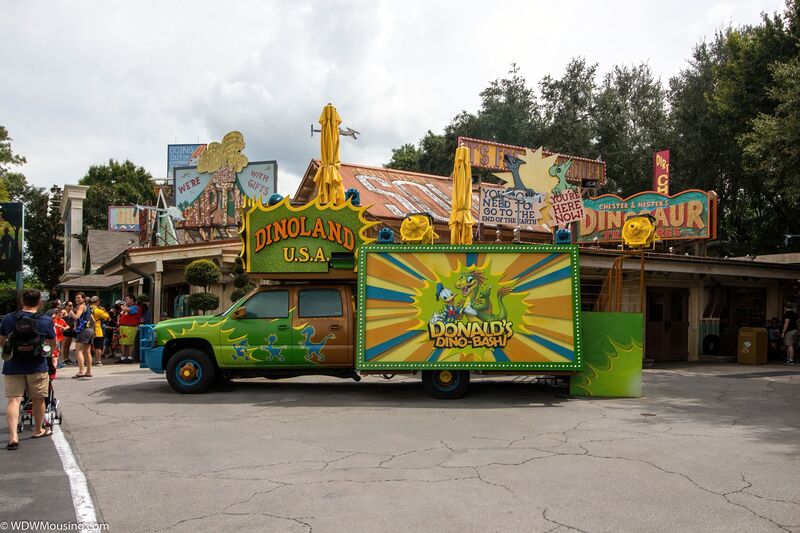Chapter 4 - Animal Kingdom - Dinoland - Part 1 posted Jun 2022
|
Before venturing into Dinoland, guests should have an understanding about what Dinoland is really about.
Joe Rodhe, creator of Dinoland described Dinoland as an “idea of chaos and order. The front half of DinoLand is just a mess. It looks like a construction site. A lot of the scaffolding that you see out in DinoLand? That’s not goin’ away. That’s DinoLand. Construction material, upheaval, dirt, piles of earth, piles of tools. It stands in opposition to the authority and the order and the kind of stuffiness of the Dino Institute.” |
History/Origin of Dinoland
To better understand Dinoland, you need to know its history.
During Animal Kingdom's development, DinoLand was to be anchored by two thrill attractions: Countdown to Extinction and a wooden rollercoaster called the Excavator.
The Excavator was to be an extension of The Boneyard Playground's setting, being the rickety remains of an ore car track left over from when the Boneyard was an ordinary gravel quarry before the fossil discoveries.
The original backstory for the Dinoland U.S.A. area of Animal Kingdom revolves around the discovery of dinosaur fossils in a former sand and gravel pit. The benefactor of a local college bought up the site, setting its paleontology students to work on uncovering the dino bones.
Left over from the site's days as a gravel pit was a major piece of machinery: The Excavator. Since then, some of the students have decided to turn the ore car system into a huge, heavily-themed, mine cart-style roller coaster that would be one of Disney's Animal Kingdom's headline thrill rides. Guests would pass by numerous, ignored old signs warning about the stability of the ore car system before arriving at load. While moving along the track, guests would pass through ribcages of dinosaur skeletons and zoom past mechanical dinosaur sculptures built by the students from old construction equipment and junk.
To better understand Dinoland, you need to know its history.
During Animal Kingdom's development, DinoLand was to be anchored by two thrill attractions: Countdown to Extinction and a wooden rollercoaster called the Excavator.
The Excavator was to be an extension of The Boneyard Playground's setting, being the rickety remains of an ore car track left over from when the Boneyard was an ordinary gravel quarry before the fossil discoveries.
The original backstory for the Dinoland U.S.A. area of Animal Kingdom revolves around the discovery of dinosaur fossils in a former sand and gravel pit. The benefactor of a local college bought up the site, setting its paleontology students to work on uncovering the dino bones.
Left over from the site's days as a gravel pit was a major piece of machinery: The Excavator. Since then, some of the students have decided to turn the ore car system into a huge, heavily-themed, mine cart-style roller coaster that would be one of Disney's Animal Kingdom's headline thrill rides. Guests would pass by numerous, ignored old signs warning about the stability of the ore car system before arriving at load. While moving along the track, guests would pass through ribcages of dinosaur skeletons and zoom past mechanical dinosaur sculptures built by the students from old construction equipment and junk.
|
The benefactor also founded the Dinosaur Institute, which would host the Countdown to Extinction dark ride. (Now called Dinosaur) Countdown to Extinction was a primeval safari, where guests could traveling back in time to see dinosaurs in their natural habitats. Together, they would have made for fun and engaging rides, standing out from the other areas of the Park. However, before Animal Kingdom opened to the public in 1998, it went through some unexpected changes. |
Images © Disney
|
Original Storyline:
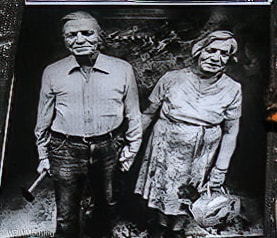
Current Backstory for Dinoland
According to the legends created by Imagineers, DinoLand USA actually started out as a small town in Diggs County, located somewhere between Texas and Florida. One day in 1947, paleontologists uncovered dinosaur bones near a Sinclair gas station, and everything changed for the sleepy town
Diggs County used to be a primarily rural area, until fossil hunters discovered dinosaur bones in the 1940s. This brought scientists to the area, primarily in the form of the Dino Institute. You can visit the Dino Institute’s headquarters while visiting Dinoland and see the collection of fossils they have amassed.
Grad students arrived from all over the country to launch fossil hunts. Gradually, these intrepid students founded the Dino Institute, which initially was used as a fishing lodge (now Restaurantosaurus) but later got its own museum building.
The Institute grow into a large corporation, still keeping the name the Dino Institute, which now runs much of the area.
Then of course, there are Chester and Hester. They are an elderly couple that ran a gas station in the area selling Sinclair gasoline. In the true entrepreneurial spirit, the pair decided to cash in on the influx of tourists. They began selling souvenirs to visitors, all dino themed of course. If you pay a visit to their gift shop, you can even see a picture of them, as well as the first dollar they ever earned. They are also responsible for the road signs found throughout the area, beckoning passing motorists to pull over and spend a few dollars.
More and more folks flocked to Diggs County, and so Chester and Hester expanded their operation by opening Chester and Hester’s Dino-Rama. There, Guests can play carnival games, ride roller coasters, and enjoy the gaudy delights the old couple built to draw in visitors.
If you’re someone who has spent more than a little time on cross county travels, this outlandish, kitschy presentation rings true to the things you’d experience on a classic American road trip.
The balance in Diggs County between serious science and fun has long been a fragile one. On one side, you have The Dino Institute, installed in the county not long after the first fossils were found in this corner of Diggs County. On the other, you have Chester and Hester, long-time residents that just want to make a living and have some fun while doing it.
This dichotomy couldn’t be made any clearer than it is on the billboards in the area.
According to the legends created by Imagineers, DinoLand USA actually started out as a small town in Diggs County, located somewhere between Texas and Florida. One day in 1947, paleontologists uncovered dinosaur bones near a Sinclair gas station, and everything changed for the sleepy town
Diggs County used to be a primarily rural area, until fossil hunters discovered dinosaur bones in the 1940s. This brought scientists to the area, primarily in the form of the Dino Institute. You can visit the Dino Institute’s headquarters while visiting Dinoland and see the collection of fossils they have amassed.
Grad students arrived from all over the country to launch fossil hunts. Gradually, these intrepid students founded the Dino Institute, which initially was used as a fishing lodge (now Restaurantosaurus) but later got its own museum building.
The Institute grow into a large corporation, still keeping the name the Dino Institute, which now runs much of the area.
Then of course, there are Chester and Hester. They are an elderly couple that ran a gas station in the area selling Sinclair gasoline. In the true entrepreneurial spirit, the pair decided to cash in on the influx of tourists. They began selling souvenirs to visitors, all dino themed of course. If you pay a visit to their gift shop, you can even see a picture of them, as well as the first dollar they ever earned. They are also responsible for the road signs found throughout the area, beckoning passing motorists to pull over and spend a few dollars.
More and more folks flocked to Diggs County, and so Chester and Hester expanded their operation by opening Chester and Hester’s Dino-Rama. There, Guests can play carnival games, ride roller coasters, and enjoy the gaudy delights the old couple built to draw in visitors.
If you’re someone who has spent more than a little time on cross county travels, this outlandish, kitschy presentation rings true to the things you’d experience on a classic American road trip.
The balance in Diggs County between serious science and fun has long been a fragile one. On one side, you have The Dino Institute, installed in the county not long after the first fossils were found in this corner of Diggs County. On the other, you have Chester and Hester, long-time residents that just want to make a living and have some fun while doing it.
This dichotomy couldn’t be made any clearer than it is on the billboards in the area.

This billboard was clearly erected by the folks over at The Dino Institute. While they once were a small ragtag group that occupied the lodge turned student housing turned restaurant. It is a clean environment with a quaint old wing feature traditional museum display. (we’ll visit the RestarantOSAURUS in a later section below)
The research institute’s facility is likely the envy of paleontologists everywhere. It has become a very professional environment where the most out of sort’s element tends to be Dr. Grant Seeker’s ties and hand puppets. (More about Dr. Seeker when we tour the Dino Institute)
The Dino Institute’s Billboard uses four key phrases (Adventure, Discover, Enjoy, and Explore) to market their attractions and get tourists to pull off of the road. A road known as US 498, which refers to the month and year (April 1998) Animal Kingdom opened.
The artwork features several families and friends, just to show us how family-friendly and important The Dino Institute really is. On the right side of the billboard, we are supposed to see directions to The Dino Institute utilizing the Dino Drive exit. The billboard also used to have quotes proclaiming that The Dino Institute is one of the finest attractions in America. Instead, however, it appears that someone has plastered over the sign with a cartoon dinosaur.
The side plastered poster comes from Chester and Hester to promote their roadside attraction, Dino-rama. What once was a gas station and parking lot has become a full-fledged tourist destination.
From fossilized finds and every plastic dinosaur you could imagine, to comics and magazines feature dinosaurs and even some kitschy folk-art dedicated to dinosaurs, this couple has truly bought in on the dinosaur craze that has taken over the county. Chester and Hester have set up multiple fair-type attractions and carnival games in their parking lot in order to further lure passersby to stop and take part in the fun.
Every dinosaur in the area is a caricature of itself, animated for maximum ‘laffs.’ Chester and Hester make a clear distinction from the image that The Dino Institute emanates, and that is entirely on purpose.
A second billboard in the area has clearly been created by the county itself or its chamber of commerce. Here we see an i tranquil scene, reminiscent of the vistas from Lady and the Tramp, which highlights the community as a whole. There are houses, a church, and even an academic or government building across the river. In the foreground, however, we see a paleontologist on the hill overlooking the scene right next to a car, likely loaded up with a family of tourists, heading into Diggs County.
For The Dino Institute we can see the museum, the Boneyard, and Sue the Tyrannosaurus rex. Meanwhile, for Chester and Hester’s Dino-Rama is presented with its oversized icon, Primeval Whirl, and Triceratops Spin. What Diggs County is promoting knows that both of these institutions are critical to their success and that if they both thrive, so will the community.
The research institute’s facility is likely the envy of paleontologists everywhere. It has become a very professional environment where the most out of sort’s element tends to be Dr. Grant Seeker’s ties and hand puppets. (More about Dr. Seeker when we tour the Dino Institute)
The Dino Institute’s Billboard uses four key phrases (Adventure, Discover, Enjoy, and Explore) to market their attractions and get tourists to pull off of the road. A road known as US 498, which refers to the month and year (April 1998) Animal Kingdom opened.
The artwork features several families and friends, just to show us how family-friendly and important The Dino Institute really is. On the right side of the billboard, we are supposed to see directions to The Dino Institute utilizing the Dino Drive exit. The billboard also used to have quotes proclaiming that The Dino Institute is one of the finest attractions in America. Instead, however, it appears that someone has plastered over the sign with a cartoon dinosaur.
The side plastered poster comes from Chester and Hester to promote their roadside attraction, Dino-rama. What once was a gas station and parking lot has become a full-fledged tourist destination.
From fossilized finds and every plastic dinosaur you could imagine, to comics and magazines feature dinosaurs and even some kitschy folk-art dedicated to dinosaurs, this couple has truly bought in on the dinosaur craze that has taken over the county. Chester and Hester have set up multiple fair-type attractions and carnival games in their parking lot in order to further lure passersby to stop and take part in the fun.
Every dinosaur in the area is a caricature of itself, animated for maximum ‘laffs.’ Chester and Hester make a clear distinction from the image that The Dino Institute emanates, and that is entirely on purpose.
A second billboard in the area has clearly been created by the county itself or its chamber of commerce. Here we see an i tranquil scene, reminiscent of the vistas from Lady and the Tramp, which highlights the community as a whole. There are houses, a church, and even an academic or government building across the river. In the foreground, however, we see a paleontologist on the hill overlooking the scene right next to a car, likely loaded up with a family of tourists, heading into Diggs County.
For The Dino Institute we can see the museum, the Boneyard, and Sue the Tyrannosaurus rex. Meanwhile, for Chester and Hester’s Dino-Rama is presented with its oversized icon, Primeval Whirl, and Triceratops Spin. What Diggs County is promoting knows that both of these institutions are critical to their success and that if they both thrive, so will the community.
Research:
- http://www.mainstgazette.com/search?updated-max=2018-05-16T09:00:00-04:00&max-results=20&start=66&by-date=false
- https://www.celebrationspress.com/2020/04/19/a-brief-history-of-diggs-county-in-dinoland-usa/
- http://allears.net/walt-disney-world-chronicles-joe-rohde-and-disneys-animal-kingdom-in-1988/
- https://allears.net/2020/08/20/whats-the-deal-with-the-carnival-rides-at-disneys-animal-kingdom-the-history-of-dinoland-usa/
Well let’s head into Dinoland, and our first stop is
Trilo-Bites
Trilo-Bites is located on the right just as guests come over the bridge into DinoLand U.S.A.
Trilo-Bites
Trilo-Bites is located on the right just as guests come over the bridge into DinoLand U.S.A.
|
What’s in a Name? Trilobites existed for nearly 270 million years. Actually, not only did they exist… for the majority of their lengthy stay on Planet Earth, they thrived. These ancient arthropods filled the world's oceans from the earliest stages of the Cambrian Period, 521 million years ago. Note: I would recommend staying with the Buffalo Chicken Chips and Ice Cream Float. |
Followup:
As we passed Trilo-Bites to enter Dinoland we’ll need to under the
Oldengate Bridge
Oldengate Bridge
click to enlarge photo
The OldenGate Bridge is a steel truss footbridge that’s guarded by a massive Brachiosaurus skeleton
This fossil Gateway is composed of the giant bones of a Brachiosaurus, one of the largest creatures that ever walked the earth. It stands fifty-two feet tall and more than eighty feet long. A peaceful plant-eater, the Brachiosaurus' enormous neck allowed it to browse amid the upper branches of prehistoric forests.
This replica fossil is cast from the bones discovered in Colorado in 1900. The original is now in the field Museum in Chicago.
To get a closer look at this astounding giant, visit THE BONEYARD, a working dinosaur dig site.
Search:
https://www.hmdb.org/m.asp?m=198209
https://wdwthemeparks.com/entertainment/oldengate-bridge/
This fossil Gateway is composed of the giant bones of a Brachiosaurus, one of the largest creatures that ever walked the earth. It stands fifty-two feet tall and more than eighty feet long. A peaceful plant-eater, the Brachiosaurus' enormous neck allowed it to browse amid the upper branches of prehistoric forests.
This replica fossil is cast from the bones discovered in Colorado in 1900. The original is now in the field Museum in Chicago.
To get a closer look at this astounding giant, visit THE BONEYARD, a working dinosaur dig site.
Search:
https://www.hmdb.org/m.asp?m=198209
https://wdwthemeparks.com/entertainment/oldengate-bridge/
The Boneyard
Just past the Oldengate Bridge on the left, kids of all ages will enjoy exploring the Boneyard.
The Boneyard Playground was one of the opening day attractions when Disney’s Animal Kingdom Park first opened on April 22, 1998 (which is also Earth Day).
The Boneyard is an interactive playground area for kids of all ages. It was created to resemble a paleontologist’s dig site. There are musical bones, interactive exhibits and even an archaeological dig where kids can excavate fossils from a Triceratops or Tyrannosaurus.
The playground is a replica of a dig site with rope ladders, tunnels and slides, on varying levels for guests to explore. The soft cushiony floor makes for a safe play area. There are a number of interactive displays here as well. With doors to open and lids to crates, and dinosaur footprints to step into.
There are dig site notes and facts posted around the walls of the enclosed area and the fossils here are archaeologically correct.
Nearby the sandbox area is not filled with real sand, but rather a no-stick variety known as “Texas grit.” Children can play archaeologist and dig for the artificial remains of a 10,000-year-old woolly mammoth.
Just past the Oldengate Bridge on the left, kids of all ages will enjoy exploring the Boneyard.
The Boneyard Playground was one of the opening day attractions when Disney’s Animal Kingdom Park first opened on April 22, 1998 (which is also Earth Day).
The Boneyard is an interactive playground area for kids of all ages. It was created to resemble a paleontologist’s dig site. There are musical bones, interactive exhibits and even an archaeological dig where kids can excavate fossils from a Triceratops or Tyrannosaurus.
The playground is a replica of a dig site with rope ladders, tunnels and slides, on varying levels for guests to explore. The soft cushiony floor makes for a safe play area. There are a number of interactive displays here as well. With doors to open and lids to crates, and dinosaur footprints to step into.
There are dig site notes and facts posted around the walls of the enclosed area and the fossils here are archaeologically correct.
Nearby the sandbox area is not filled with real sand, but rather a no-stick variety known as “Texas grit.” Children can play archaeologist and dig for the artificial remains of a 10,000-year-old woolly mammoth.
click to enlarge photos
Check out the maze with covered slides and take a make-believe ride in a Jeep inside the boneyard. The Boneyard is a great place to take a break and the ideal place for any budding paleontologists in your party! (Or even full-grown paleontologist-wannabes, as adults are also allowed to play.)
In the background listen to the music playing in the area which are spins on classics played on W-DIG radio, along with various chatter and talk that keep the area perfectly themed.
In the background listen to the music playing in the area which are spins on classics played on W-DIG radio, along with various chatter and talk that keep the area perfectly themed.
The Boneyard Sign
The Boneyard sign has a familiar look. It’s actually a replica of the shoulder blade for the Stegosaurus It is also a geographical map of Animal Kingdom and with the directional symbol for north on it , The map includes the now extinct Camp Minnie Mickey area.
The Boneyard sign has a familiar look. It’s actually a replica of the shoulder blade for the Stegosaurus It is also a geographical map of Animal Kingdom and with the directional symbol for north on it , The map includes the now extinct Camp Minnie Mickey area.
Sources:
As we pass the Boneyard and take the right path, we’ll come to the
American Crocodile Exhibit
American Crocodile Exhibit
One of the most overlooked areas of DinoLand is the American Crocodile exhibit.
The American Crocodile Exhibit is a small exhibit showcasing those reptiles are one of the closest creatures we have to actual living dinosaurs (even if dinosaurs are more related to birds).
The crocodile in the exhibit is so still that most of the time, guests think he was fake! Crocodiles don’t move around that much, and would let birds land on him, but he is real. When he does move around or would open his mouth to regulate his temperature, guests are amazed.
Research:
The American Crocodile Exhibit is a small exhibit showcasing those reptiles are one of the closest creatures we have to actual living dinosaurs (even if dinosaurs are more related to birds).
The crocodile in the exhibit is so still that most of the time, guests think he was fake! Crocodiles don’t move around that much, and would let birds land on him, but he is real. When he does move around or would open his mouth to regulate his temperature, guests are amazed.
Research:
Further on to the right is a quick snack stop,
Dino-Bite Snacks
The backstory for Dino-Bite Snacks, ties in with that of the rest of DinoLand USA. The story begins in 1946, in Diggs County, located somewhere along U.S. Highway 498. Here, a rustic fishing lodge was located and supported by locals and visitors alike. In 1947 things changed in Diggs County. An amateur fossil-hunter found dinosaur bones near the fishing lodge, and after showing them to some paleontologists, the group decided to buy the lodge and much of its surrounding land, eventually transforming the area into the Dino Institute.
Due to the creation of the institute, professors and grad students soon flooded to the area, eventually creating a dormitory and fabricate. As a way to make a few extra bucks, the grad students decided to open their cafeteria to the public.
At the same time the students created a roadside stand where tourists could buy ice cream- Dino-Bite Snacks.
Dino Bite Snacks a fun, vintage style trailer that serves up prehistoric treats!
Dino-Bite Snacks is a quick service counter that serves breakfast items including a hot breakfast wrap, as well as, tasty sweet ice cream and float treats.
Dino-Bite Snacks
The backstory for Dino-Bite Snacks, ties in with that of the rest of DinoLand USA. The story begins in 1946, in Diggs County, located somewhere along U.S. Highway 498. Here, a rustic fishing lodge was located and supported by locals and visitors alike. In 1947 things changed in Diggs County. An amateur fossil-hunter found dinosaur bones near the fishing lodge, and after showing them to some paleontologists, the group decided to buy the lodge and much of its surrounding land, eventually transforming the area into the Dino Institute.
Due to the creation of the institute, professors and grad students soon flooded to the area, eventually creating a dormitory and fabricate. As a way to make a few extra bucks, the grad students decided to open their cafeteria to the public.
At the same time the students created a roadside stand where tourists could buy ice cream- Dino-Bite Snacks.
Dino Bite Snacks a fun, vintage style trailer that serves up prehistoric treats!
Dino-Bite Snacks is a quick service counter that serves breakfast items including a hot breakfast wrap, as well as, tasty sweet ice cream and float treats.
Current Menu:
Behind Dino-Bite is Restaurantosaurus. This quick service dining location in Dinoland USA offers up meals including burgers and chicken nuggets in a unique setting.
Restaurantosaurus
Restaurantosaurus
click on photos to enlarge
Before we go into Restaurantosaurus, it’s better to understand how this restaurant fits in Dinoland. So let’s get some of Joe’s input on the Restaurant and DinoLand:
Note: Joe Rohde created Dinoland USA in Walt Disney World’s Animal Kingdom
Note: Joe Rohde created Dinoland USA in Walt Disney World’s Animal Kingdom

Joe Rohde on DinoLand
“Let’s cross the bridge into DinoLand. DinoLand is about our American love and fascination with dinosaurs, both as real science, as part of our national heritage and as popular cult icons. When you cross the bridge to DinoLand, guests are greeted with one of those trapezoid roadside signs, you know, with the routed-out letters ‘DinoLand USA, friendliest fossils in America.’ Clearly, you are somewhere along the highway in America. You are at a place where people excavate these fossils and yet they have to make a buck, right? So, you’ve got these two blended ideas that come together.
“So, there’s a kind of emotional motif woven in to DinoLand. Probably the more dominant one is this idea of chaos and order. The front half of DinoLand is just a mess. It looks like a construction site. A lot of the scaffolding that guests see as they enter into DinoLand? That’s not goin’ away. That’s DinoLand. Construction material, upheaval, dirt, piles of earth, piles of tools.
“It stands in opposition to the authority and the order and the kind of stuffiness of the Dino Institute itself, which is in the background, which represents a whole other kind of idea. We’ve set up this world of students — grad students — young, refreshing, wild, exuberant; in opposition to their professors who are rather more somber and controlled. And as you look, you’ll see again and again this sort of order and disarray, order and disarray, order and disarray setup.
According to Rohde, “There must be college students everywhere, because they form the working class of any excavation.” He went on to state that Restaurantosaurus (a dining area with classic American fare in Dinoland) could be seen as the dorm area for the college students.
“Let’s cross the bridge into DinoLand. DinoLand is about our American love and fascination with dinosaurs, both as real science, as part of our national heritage and as popular cult icons. When you cross the bridge to DinoLand, guests are greeted with one of those trapezoid roadside signs, you know, with the routed-out letters ‘DinoLand USA, friendliest fossils in America.’ Clearly, you are somewhere along the highway in America. You are at a place where people excavate these fossils and yet they have to make a buck, right? So, you’ve got these two blended ideas that come together.
“So, there’s a kind of emotional motif woven in to DinoLand. Probably the more dominant one is this idea of chaos and order. The front half of DinoLand is just a mess. It looks like a construction site. A lot of the scaffolding that guests see as they enter into DinoLand? That’s not goin’ away. That’s DinoLand. Construction material, upheaval, dirt, piles of earth, piles of tools.
“It stands in opposition to the authority and the order and the kind of stuffiness of the Dino Institute itself, which is in the background, which represents a whole other kind of idea. We’ve set up this world of students — grad students — young, refreshing, wild, exuberant; in opposition to their professors who are rather more somber and controlled. And as you look, you’ll see again and again this sort of order and disarray, order and disarray, order and disarray setup.
According to Rohde, “There must be college students everywhere, because they form the working class of any excavation.” He went on to state that Restaurantosaurus (a dining area with classic American fare in Dinoland) could be seen as the dorm area for the college students.
“Restaurantosaurus", which now has its sign on the roof, is an easy place to see that. You’ve got the sign. The sign is perfectly sane. It says “restaurant.” It is a restaurant, it says “restaurant,” but one of the alleged grad students had climbed up on the roof with a piece of corrugated metal and painted “OSAURUS” on the metal and tacked it up on the edge of the sign. “The OSAURUS, part of the sign is supposed to be a college prank”. Which is kind of an act of rebellious vandalism, against the very order of restaurant itself.
Rohde said in a recent social media post. “I assume that the building is older, like it used to be a fish camp or something.”
Source:
https://touringplans.com/animal-kingdom/lands/dinoland-usa
Rohde said in a recent social media post. “I assume that the building is older, like it used to be a fish camp or something.”
Source:
https://touringplans.com/animal-kingdom/lands/dinoland-usa
Into the Lodge (Restaurantosaurus)
The former Dino Institute was the hangout for the students and is now the Restaurantosaurus diner, but the many internal decorations reflect the town’s rich history. Each part of the restaurant has its own unique theme tied to DinoLand’s past.
The Lodge is divided into several areas:
The rambling and every expanding Restaurantosaurus is made up of permanent and "temporary" additions including an Airstream trailer. Puns and artifacts are everywhere. Well worth the time to check out.
The former Dino Institute was the hangout for the students and is now the Restaurantosaurus diner, but the many internal decorations reflect the town’s rich history. Each part of the restaurant has its own unique theme tied to DinoLand’s past.
The Lodge is divided into several areas:
- The central "Old Museum" area
- Dorms for the Dino Institute's students
- "The Hip Joint", a rec-room with a 50s diner look and an old trailer connected to the building
- The Dino Institute's Motor Pool, a garage where students have painted dinosaurs on the walls with engine grease
- And a Restaurantosaurus Lounge
The rambling and every expanding Restaurantosaurus is made up of permanent and "temporary" additions including an Airstream trailer. Puns and artifacts are everywhere. Well worth the time to check out.
click on photos to enlarge
Restaurantosaurus is split up into several different sections tied to DinoLand’s paleontology backstory. Part of the former fishing lodge is a visitor center of sorts. The mini museum hosts various bones and other fossils that students dug up at the Boneyard.
Then there’s the “Hip Joint” recreation room, with various trophies showcasing the grad students’ extracurricular escapades. For instance, there are painted rocks that interns brought from their hometowns. In addition, there are awards such as the Golden Trowel Trophy, which is given to whoever made the most finds that year. The grad students even used the restaurant as a makeshift dormitory.
According to Rohde, “There must be college students everywhere, because they form the working class of any excavation.” He went on to state that Restaurantosaurus could be seen as the dorm area for the college students.
Then there’s the “Hip Joint” recreation room, with various trophies showcasing the grad students’ extracurricular escapades. For instance, there are painted rocks that interns brought from their hometowns. In addition, there are awards such as the Golden Trowel Trophy, which is given to whoever made the most finds that year. The grad students even used the restaurant as a makeshift dormitory.
According to Rohde, “There must be college students everywhere, because they form the working class of any excavation.” He went on to state that Restaurantosaurus could be seen as the dorm area for the college students.
click on photos to enlarge

The lodge also has “historical” photos of the digs, as well as portraits of key individuals like Clarence P. Wilkerson. This gentleman believed in the project and was a major benefactor.
You can find even more intricate details outside the main restaurant area, in a Quonset maintenance garage for the excavation teams’ vehicles and other dig equipment. The interior displays several mechanics’ dinosaur-themed art, like paintings made with oil and grease and a skeleton made out of wrenches and other random tools. The gas cans are from the Sinclair brand (just like Chester and Hester’s old gas station), tying back to Sinclair’s dinosaur theme. Adjacent to the maintenance facility, there are several tents for auxiliary storage, with more fun things to discover. For example, one of the exits seems to have a bucket of water at the top, one of the mischievous students’ many pranks.
You can find even more intricate details outside the main restaurant area, in a Quonset maintenance garage for the excavation teams’ vehicles and other dig equipment. The interior displays several mechanics’ dinosaur-themed art, like paintings made with oil and grease and a skeleton made out of wrenches and other random tools. The gas cans are from the Sinclair brand (just like Chester and Hester’s old gas station), tying back to Sinclair’s dinosaur theme. Adjacent to the maintenance facility, there are several tents for auxiliary storage, with more fun things to discover. For example, one of the exits seems to have a bucket of water at the top, one of the mischievous students’ many pranks.
|
This cartoon on a wall was evidently sketched by a local mechanic in between repairing dig vehicles.
Funny notes like this give testament to the crazy grad students’ penchant for troublemaking. Not only that, but the restaurant also has some interesting ties to Disney’s larger history with dinosaurs. |
|
In addition, circling back to Dinoland’s fictional history, there’s a framed picture of Hester and Chester, with the title “American Gothic Revised”. All of these different features make the Restaurantosaurus a treasure trove of lore, so be sure to stop there for a bite to eat, or a walk through, next time you’re in DinoLand.
|
If you look around the lodge, you can see fanciful dinosaur sketches from the Rite of Spring piece in Fantasia. Plus, there’s a photograph of Walt Disney himself alongside some of the animatronic dinosaurs used for the Ford’s Magic Skyway attraction at the 1964-1965 New York World’s Fair.
|
Look around and you may see posters that represent College culture of the time
The Real Story:
- https://allears.net/2012/10/01/a-history-of-dinoland-u-s-a-and-restaurantosaurus-part-one/
- http://dinolandusa.com/the-lodge/
- https://disney.fandom.com/wiki/Restaurantosaurus
- https://touringplans.com/animal-kingdom/lands/dinoland-usa
- http://allears.net/walt-disney-world-chronicles-joe-rohde-and-disneys-animal-kingdom-in-1988/
- https://disneytips.com/8-favorite-things-found-in-dinoland-u-s-a-at-walt-disney-worlds-animal-kingdom/?utm_source=Mickey+Tips&utm_campaign=81c9164eae-MT+Email_COPY_01&utm_medium=email&utm_term=0_9bf0730414-81c9164eae-307144285
- https://www.celebrationspress.com/2020/04/19/a-brief-history-of-diggs-county-in-dinoland-usa/
- https://disneyparks.fandom.com/wiki/Ford_Magic_Skyway

Menu
Oh! by the way, the Lodge is a cafeteria-turned-restaurant,
Where you can dig into gourmet burgers and other American fare.
This is a great place to dine for guests who are less adventurous eaters.
Current Menu:
Oh! by the way, the Lodge is a cafeteria-turned-restaurant,
Where you can dig into gourmet burgers and other American fare.
This is a great place to dine for guests who are less adventurous eaters.
Current Menu:
Radio W-DIG
If you listen carefully around The Boneyard play area and Restaurantosaurus, and you can hear the fun chatter and playlist of college radio station W-DIG. Which is supposed to be an underground radio station, that has been taken over by a couple of the interns who work at the Dino Institute nicknamed “Digger” and “Bonehead.”
The Dinoland Music U.S.A. contains a lot of pop and rock music. The Radio Broadcast music is theme-based on dinosaurs and extinction (Which makes sense since the original name of the Dinosaur attraction was “Countdown to Extinction”), and some of the music should be recognizable to the guests.
Here’s a playlist:
If you listen carefully around The Boneyard play area and Restaurantosaurus, and you can hear the fun chatter and playlist of college radio station W-DIG. Which is supposed to be an underground radio station, that has been taken over by a couple of the interns who work at the Dino Institute nicknamed “Digger” and “Bonehead.”
The Dinoland Music U.S.A. contains a lot of pop and rock music. The Radio Broadcast music is theme-based on dinosaurs and extinction (Which makes sense since the original name of the Dinosaur attraction was “Countdown to Extinction”), and some of the music should be recognizable to the guests.
Here’s a playlist:
- “Dancing with the Dinosaur” by Steven Curtis Chapman
- “Ugga Bugga” by Barnes and Barnes
- “I’m A Little Dinosaur” by Jonathan Richman & The Modern Lovers
- “Watch Out” by Barnes and Barnes
- “If I Had a Dinosaur” by Raffi
- “It’s the End of the World As We Know It (And I Feel Fine)” by R.E.M.
- “Sweet Dinosaur of Mine” by Barnes and Barnes
- “Brontosaurus” by Cheap Trick
- “Walk the Dinosaur” by Was (Not Was)
- “Godzilla” by Blue Oyster Cult
- “Bad to the Bone” by George Thorogood & The Destroyers
- “Grazing In The Grass” by Friends of Distinction (part of the chorus is “Can you dig it?”)
|
It helps to understand the theme and backstory of DinoLand U.S.A, then you can better appreciate the tacky, kitschy quality, as well as, the reason for the selections in music. (Cheap Trick? Blue Oyster Cult? Raffi?!) If you are a fan of searching for themes, this area is definitely for you!
|
Tune-In:
Something new has been added to DinoLand in the summer of 2018,
Restaurantosaurus Lounge
Restaurantosaurus Lounge
|
The Lounge is open daily from 5:00 pm until park close When you see this sign, just enter through the door in the building behind it. (It’s on the left-hand side of the restaurant.)
Restaurantosaurus Lounge is tucked inside a small room at the Restaurantosaurus quick service. This small dining room has its own entrance. It almost feels like entering a speakeasy, the way it is off to the side in a small room. Guests can place their orders directly at the counter based on the menu offerings, which currently feature a selection of Cocktails like the Tequilasaurus margarita and Primordial Booze as well as Mocktails such as the Teal Rex and Paleontology Punch.
|
You may already be familiar with Restaurantosaurus in Animal Kingdom’s Dinoland, U.S.A. This popular Counter Service option serves up classics like Burgers and Chicken Nuggets in a fun atmosphere.
But a new arrival at Restaurantosaurus, where you find a spot to relax and unwind, is the Restaurantosaurus Lounge. |
Two Small Bites are on offer: Buffalo Chicken Dip with House-made Chips and Sweet-and-Spicy Mixed Nuts.
This portion of the restaurant has been entirely dedicated to Lounge seating.
Of course, the supplies and sights inside of the Paleontology storage area of the restaurant are still in place.
The regular menu has a good amount of strong drinks too. I will be back to check out the South African wines. It is hard to choose Restaurantosaurus Lounge over other bars like Nomad Lounge and Dawa Bar, but it still has its own charm.
Research:
This portion of the restaurant has been entirely dedicated to Lounge seating.
Of course, the supplies and sights inside of the Paleontology storage area of the restaurant are still in place.
The regular menu has a good amount of strong drinks too. I will be back to check out the South African wines. It is hard to choose Restaurantosaurus Lounge over other bars like Nomad Lounge and Dawa Bar, but it still has its own charm.
Research:
The Cretaceous Trail
As we round the Restaurantosaurus and Lounge we’ll head to the Dino Institute.
As we round the Restaurantosaurus and Lounge we’ll head to the Dino Institute.
|
But just before the Institute, let’s take a left into one of the quite areas of Dinoland, a Nature trail through prehistoric forest known as the Cretaceous Trail. The Cretaceous Trail is located near the entrance to Dinosaur. This trail is shaded by lush vegetation that direct decedents from the very vegetation and frequented the landscape in the Cretaceous Era.
|
|
Pachyrhinosaurus can be found amongst the shrubbery near the back. A Dino Institute dig in progress can also be found in the forest, with signage explaining how plaster casts are used for transporting fossils.
|
Cretaceous Trail is a showcase of plant-life that date back to the age of the Cretaceous such as cycads and ferns. Additionally, a few dinosaur sculptures can be found along the trail: The entry is marked by a bronze statue of an Ornithomimus in the style of other statues found in Dinosaur's extended queue, a placed at guest level that serves as a photo opportunity and a We will come across a Pachycephalosaurs dinosaur, fossil dig sites left from the original finds in 1947 and you might even hear a dinosaur or two in the brush
The Cretaceous Trail is interesting, particularly with its focus on primeval flora. As you walk down the short trail, you’ll see plants that were around in the age of the dinosaurs, along with some dinosaur statues.
This area is a bit hidden and is usually a low traffic area. |
click on photo to enlarge
Discover:
- https://www.wdwkingdom.com/cretaceous-trail-animal-kingdom-dinoland-u-s-a/
- https://disney.fandom.com/wiki/Cretaceous_Trail
- http://livingadisneylife.com/tag/cretaceous-trail/
As we proceed down the path, we’ll arrived at the Dino Institute.
Dino Institute
Dino Institute
|
With the added income to the town and the Dino Institute, the original location of the Dino Institute became an excavation site and a dorm for young paleontologists to live in during their studies. With the original location being taken over, a new Dino Institute was built in 1978. For the first twenty years the location was used as a showcase for various fossils until they introduced a way to bring guests back to the time of the dinosaurs with the invention of the Time Rover.
|
We have gone into extensive detail about Dinoland, USA and the back story found throughout the land. As you may recall after the discovery of dinosaur bones in the area, the small fishing resort became the first Dino Institute. As the years passed, the small town began to flourish as more visitors came to see the bones of the creatures that once roamed the earth. The current home of the Dino Institute has a plaque near the entrance commemorating the opening day of the location near the entrance to the building. One may notice an interesting detail about the plaque. The opening date is April 22, 1978, twenty years to the day before Disney's Animal Kingdom opened! |
|
Countdown to Extinction’s Transformation
DinoLand’s main attraction is DINOSAUR, an exciting dark ride taking you back to the late Cretaceous Period just before the dinosaurs were wiped out. The attraction originally opened with the park in April 1998 under the name Countdown to Extinction. Disney changed the ride’s name in 2000 to promote the Company’s computer-animated film Dinosaur. For example, the Iguanodon got more focus (both in the ride and in the pre/after-shows) and was redesigned to better match the film’s hero, Aladar. The basic premise and its connection to DinoLand’s fictional history stayed the same. As a hidden reference of the ride’s original form, a tribute to the original name of the attraction is just after boarding their Time Rovers. On the wall in the loading area contains the writing: “Sector CTX-WDI-AK98”. This references the name Countdown to Extinction (CTX), Walt Disney Imagineering (WDI), and Animal Kingdom 1998 (AK98).
|
Note: Background music used in Countdown to Extinction, then also for Dinosaur. It was written by Richard Bellis.
Bellis has written music for diverse attractions including the original Star Tours and Indiana Jones Adventure at Disneyland. Bellis also composed for extinct Walt Disney World attractions like the ExtraTERRORestrial Alien Encounter, Captain EO pre-show, and the Lights, Motors, Action! Extreme Stunt Show
Bellis has written music for diverse attractions including the original Star Tours and Indiana Jones Adventure at Disneyland. Bellis also composed for extinct Walt Disney World attractions like the ExtraTERRORestrial Alien Encounter, Captain EO pre-show, and the Lights, Motors, Action! Extreme Stunt Show
After the change, Dinosaur’s main character Aladar the Iguanodon, can be seen in a fountain in front of the ride.
|
As we stated before the ride was originally named Countdown to Extinction when the park opened in 1998, in 2000 the name was changed to Dinosaur in 2000 to promote the Disney animated film, Dinosaur. The two dinosaurs most prominently featured in the ride have always been an Iguanodon and Carnotaurus, which were both featured prominently in the film. Some of the scenes from the movie appear in the pre-show, to help the guests identify the Iguanodon as the film's protagonist, Aladar.
|
Dino Institute is where scientists have discovered how to send travelers back in time for an exclusive tour of the prehistoric world. The ride features a turbulent journey through the late Cretaceous period, featuring prehistoric scenes populated with dinosaur audio-animatronics |
The Ride Experience
Queue
The first section of the queue, guests will see several small exhibits including a display of small fossils, modern animals that can be traced back to the dinosaur ages, and evidence for the several theories of mass extinction.
Queue
The first section of the queue, guests will see several small exhibits including a display of small fossils, modern animals that can be traced back to the dinosaur ages, and evidence for the several theories of mass extinction.
|
The second section of the indoor queue is an eight-sided room, with the upper parts of the walls displaying some artist renderings of what the age of the dinosaurs might have looked like and some fossils. The lower sections of the walls are a simulation of sedimentary rock that contain fossils. some sections of the lower walls have windows that display some more fossils.
Hanging from the ceiling is a large globe with Pangaea, and a rod connected to the globe with measurements of hundreds of thousands of miles to show how far the theoretical asteroid that impacted with earth to cause mass extinction had to travel. |
The defining feature of the second room is its centerpiece: a Carnotaurus fossil. In the second room, at regular time intervals, the lights dim, and Bill Nye the Science Guy shares some facts and theories about the age of dinosaurs, using the globe, the paintings, and the fossil to help out with his small lectures.
After weaving through the second room, guests then enter one of two pre-show theaters.
Note: Bill Nye the Science Guy is prominent at Walt Disney Parks, most notably his appearance with Ellen DeGeneres at Ellen's Energy Adventure, an attraction that ran from 1996 to 2017 at the Universe of Energy pavilion at Epcot
|
Preshow
Next, guests enter a small theatre where a short introductive movie is played.
The first part of the movie is a small presentation by the fictional director of the Dino Institute, Dr. Helen Marsh (played by Phylicia Rashad). She claims that the "bare bones" approach of displaying research of prehistory is "about to become extinct." She says that the Dino Institute has created a "time rover" that has the ability to take guests to the age of the dinosaurs. She states that the rover is intended to take guests to a "breathtaking world where you will witness the most fantastic creatures to ever walk the earth." Dr. Marsh then transfers to a "live" feed of the control center for a comprehensive safety briefing.
Riders are greeted in the second section of the movie by the controller Dr. Grant Seeker (played by actor Wallace Langham). Dr. Seeker decides to skip most of the safety notes and get to talking about what his intentions are. He intends to use the time rover and the guests that were supposed to take a tour to go on a mission to save an Iguanodon from extinction and bring it back to the Dino Institute. He says that he tagged him with a locator during a previous "unauthorized" field trip. He then goes on to say that the Iguanodon is at the very end of the Cretaceous period. However, Dr. Marsh comes into the control center to "correct a little misstatement." She says that the tours are intended for the Early Cretaceous, and that the rovers are locked on those coordinates.
Dr. Seeker then continues his "safety briefing" by talking about flash photos and seatbelts. Dr. Marsh leaves the room during that small section of the video, and Seeker unlocks the time coordinates behind her back. Automatic doors on the opposite side of the theatre open up to the entrance of the loading area.
Next, guests enter a small theatre where a short introductive movie is played.
The first part of the movie is a small presentation by the fictional director of the Dino Institute, Dr. Helen Marsh (played by Phylicia Rashad). She claims that the "bare bones" approach of displaying research of prehistory is "about to become extinct." She says that the Dino Institute has created a "time rover" that has the ability to take guests to the age of the dinosaurs. She states that the rover is intended to take guests to a "breathtaking world where you will witness the most fantastic creatures to ever walk the earth." Dr. Marsh then transfers to a "live" feed of the control center for a comprehensive safety briefing.
Riders are greeted in the second section of the movie by the controller Dr. Grant Seeker (played by actor Wallace Langham). Dr. Seeker decides to skip most of the safety notes and get to talking about what his intentions are. He intends to use the time rover and the guests that were supposed to take a tour to go on a mission to save an Iguanodon from extinction and bring it back to the Dino Institute. He says that he tagged him with a locator during a previous "unauthorized" field trip. He then goes on to say that the Iguanodon is at the very end of the Cretaceous period. However, Dr. Marsh comes into the control center to "correct a little misstatement." She says that the tours are intended for the Early Cretaceous, and that the rovers are locked on those coordinates.
Dr. Seeker then continues his "safety briefing" by talking about flash photos and seatbelts. Dr. Marsh leaves the room during that small section of the video, and Seeker unlocks the time coordinates behind her back. Automatic doors on the opposite side of the theatre open up to the entrance of the loading area.
|
Click on video to see the Dinosaur Pre-Show
|
Notes:
|
Ride experience
- Guests enter an underground research facility where the time rover will pick them up.
- Guest go down the stairs, pass pipes, with labels on them, like, Parallel Time Converter, and strange equipment, to the Transport Loading Bay.
click on photos to enlarge
- Once the riders get on, they pull up forward for a seatbelt check.
click on photos to enlarge
- They then proceed to a testing zone, where they are transported to prehistoric times.
|
|
|
 Credit: Disney
Credit: Disney
- The rover starts to pull away again. The timer that counts down to the asteroid that causes the mass extinction claims that the asteroid is going to strike in 90 seconds, and the rover starts to pick up the pace. The scanner finds an Cearadactylus (identified only as "pterodactyl") that is flying directly towards them. The rover drives down a small hill and dodges the pterosaur.
- Now in almost complete darkness, the rover speeds through the forest and picks up a pack of Compsognathus on the scanner that is running through the forest with them. The rover falls down another small hill and loses traction.
- The Carnotaurus the riders saw before appears in front of them, and walks towards the Time Rover. Seeker turns on the four-wheel drive system and successfully gets the rover away just before the Carnotaurus gets the rover.
- The rover performs evasive maneuvers to dodge the meteors in the darkness. After dodging the meteors successfully, the rover then stumbles upon the Carnotaurus once again, which tries to lunge at them.
- This is where the ride takes the rider's photo. The rover takes off again into a small section of the forest where some of the trees are falling down. The scanner finds the Iguanodon, but Seeker decides to abort the mission and bring the rover back, as the asteroid is about to strike.
- A tree was about to fall on the rover, but the Iguanodon catches the tree and the rover proceeds. The asteroid strikes the ground and creates a flash of light, and the Carnotaurus is seen giving one last lunge.
- However, at the last second, the rover transports back to the institute, and somehow, the Iguanodon came with them.
- The rover then proceeds to the loading station. The riders then get off and proceed to some stairs, which leads to the gift shop.

As guests leave, they can see Dr. Marsh and the Dino Institute employees attempting to chase down the Iguanodon and Dr. Seeker on overhead TV monitors. They can also hear radio chatter indicating what's going on.
But in Animal Kingdom’s early days, the Iguanodon would leave the Institute to frolic at the river’s edge in Dinoland U.S.A., in full view of the Discovery Riverboats. (See Animal Kingdom Chapter 3 Discovery Island)
Sadly, this magnificent animatronic was removed when the boats closed.
Even more dreadful was that Disney shipped him off to Paris, to rot in their Studio Backlot boneyard.
But in Animal Kingdom’s early days, the Iguanodon would leave the Institute to frolic at the river’s edge in Dinoland U.S.A., in full view of the Discovery Riverboats. (See Animal Kingdom Chapter 3 Discovery Island)
Sadly, this magnificent animatronic was removed when the boats closed.
Even more dreadful was that Disney shipped him off to Paris, to rot in their Studio Backlot boneyard.
Synopsis
The adventure is tied in with the Dino Institute’s research on time travel. While you’re initially told you’ll be going on a peaceful tour, Dr. Grant Seeker gets you to help him bring back an Iguanodon. However,
Dinosaur takes you on a wild blast into the past, while you use a jeep to try and stay ahead of hungry carnivores.
The adventure is tied in with the Dino Institute’s research on time travel. While you’re initially told you’ll be going on a peaceful tour, Dr. Grant Seeker gets you to help him bring back an Iguanodon. However,
Dinosaur takes you on a wild blast into the past, while you use a jeep to try and stay ahead of hungry carnivores.
Background:
- Where great rides go to die PART 2. - Parkeology
- https://en.wikipedia.org/wiki/Dinosaur_(Disney%27s_Animal_Kingdom)
- https://www.polygon.com/2019/12/26/21031982/disney-world-dinosaur-ride
- https://www.themeparktourist.com/features/20200829/29173/it-time-bury-dinoland-usa-heres-how-land-was-designed-declined-and-what-we
- https://www.disneydining.com/dinosaur-dinoland-u-s-disneys-animal-kingdom-walt-disney-world/
- https://allears.net/animal-kingdom/dinosaur-dinoland-usa-animal-kingdom/
- http://www.fromscreentotheme.com/FunFindFriday.aspx
- https://www.themeparktourist.com/features/20180510/33849/modern-marvels-countdown-extinction-dinosaur?page=3
- http://www.D23.com
And now for some Chemistry
McDonald’s originally sponsored Countdown to Extinction, and the attraction still features a reference to the fast-food franchise. If guests look above in the ride’s loading section, they will see several colorful pipes seemingly transporting mysterious substances such as “Lycopersicon lycopersicum”. In fact, these three pipes match the condiments served at McDonald’s: red for ketchup, yellow for mustard, and white for mayonnaise. Lycopersicon lycopersicum, for instance, is in fact the scientific name for tomatoes. The other chemical names on the pipes are the other ingredients that make up the condiments.
McDonald’s originally sponsored Countdown to Extinction, and the attraction still features a reference to the fast-food franchise. If guests look above in the ride’s loading section, they will see several colorful pipes seemingly transporting mysterious substances such as “Lycopersicon lycopersicum”. In fact, these three pipes match the condiments served at McDonald’s: red for ketchup, yellow for mustard, and white for mayonnaise. Lycopersicon lycopersicum, for instance, is in fact the scientific name for tomatoes. The other chemical names on the pipes are the other ingredients that make up the condiments.
click on photo to enlarge
Gift Shop
As guests exit the ride, they enter the gift shop. Here they can purchase Dino Institute merchandise and also photos of their experience on the ride.
As guests exit the ride, they enter the gift shop. Here they can purchase Dino Institute merchandise and also photos of their experience on the ride.
click on photo to enlrge
As guests exit the Dino Institute, there are several posters of the Dinosaurs that they saw during the ride
click on photo to enlrge
Leaving the Dino Institute area, we head toward Chester & Hester’s Gas station, gift shop, etc.
But before we reach the gift shop, guests will encounter the
Donald’s Dino Bash
Donald’s Dino Bash
In 2018, as part of the "Donald's Dino Bash" event, Daisy Duck moved to the Cretaceous Trail space while the Donald meet and greet moved to a spot next to Primeval Whirl.
Note: Disney demolished the Primeval Whirl ride in September of 2021
Note: Disney demolished the Primeval Whirl ride in September of 2021
|
The Daisy meet and greet is based around Daisy's efforts to design dinosaur-inspired fashion in celebration of her dinosaur ancestors.
The bulletin board was redressed to feature some of her designs and the Corythosaurus has been given a scarf around its neck. Elsewhere on Cretaceous Trail, Chip and Dale dress up as "Chipmunkosauruses" to participate in the Dino Bash festivities. |
Backstory
|
It’s just that, Donald was doing some research and found out that his ancestors are actually dinosaurs! To mark this amazing discovery, he transformed the land into a celebration like no other! He first consulted his girlfriend, Daisy, and she went straight to work. She designed the truck they arrived in and all the outfits for themselves and their friends!
This time though, the characters wanted to design their own areas themselves. So take time to explore each character greeting spot for some unique touches the characters chose themselves! For example, Scrooge McDuck’s area is glittering with gold accents and gold ornaments that are perfect for Scrooge! Launchpad McQuack area has an oversized Christmas tree because he’s such a big guy! Daisy’s area is perfectly pink, with lots of threads and buttons. |
The story behind the transformation of Dinoland USA into Donald’s Dino-Bash is a good one. The year 2018 was not only the 20th anniversary of the opening of Animal Kingdom. It was also the year that Donald Duck discovered that his ancestors were actually dinosaurs!
This recent revolution in 2018 has little to do with the town’s backstory. |
|
Chip ‘n’ Dale’s area has antlers and strings, and Goofy has a lot of lights.
Donald’s area has a very nice touch. He chose to hang stockings for all his friends! There are also presents in the Boneyard. Be sure to check out the Snowman next to Donald’s meet and greet area! You’ll notice instead of a regular carrot nose, he has a beak! This is because he wanted to join in on the fun! |
Photo Gallery
click on photos to enlarge
Resource:
- https://disney.fandom.com/wiki/Cretaceous_Trail
- Junior Woodchucks | Disney Wiki | Fandom
- https://www.disneylists.com/2019/11/5-reasons-to-visit-disneys-animal-kingdom-during-the-holiday-season/?utm_source=DisneyList.com+Update&utm_campaign=1037c6830d-DisneyLists_com_Update_11_16_19&utm_medium=email&utm_term=0_e09735652c-1037c6830d-283624153
- https://www.wdwkingdom.com/cretaceous-trail-animal-kingdom-dinoland-u-s-a/
- https://disney.fandom.com/wiki/Cretaceous_Trail
- http://livingadisneylife.com/tag/cretaceous-trail/
- What's the Deal With the Carnival Rides at Disney's Animal Kingdom? The History of DinoLand USA - AllEars.Net
We've reached the end of Chapter 4 - Animal Kingdom - Dinoland - Part 1. Our tour has taken us thru the Boneyard, we saw the Crocodile, run through the Restaurantosaurus, headed to the Dino Institute, took a ride to the past in search of the last Iguanodon, and ended at Donald's Bash. Whoooo, am I tired!
But it's not over, next Chapter we're going to Chester and Hester's shop, then to their amusement park, and on to a show "Finding Nemo".
So see you next Chapter.
But it's not over, next Chapter we're going to Chester and Hester's shop, then to their amusement park, and on to a show "Finding Nemo".
So see you next Chapter.
|
Afterword:
WDWMousing.com is designed to be a tour of Walt Disney World through photos. We have been to Walt Disney World countless times over the past 25 years and accumulated a magnitude of photos in that time. This website is an intention to combine two of our favorite pastimes, Walt Disney World and photography, and provide an insightful pictorial tour. While doing so, we've done an extensive research of the internet and literary sources for background information on each area and attraction. The information is available, but most bits and pieces are scattered all over. WDWMousing doesn't intend to rewrite the stories, legends or data, but to try and collect it into one location with reference and links to the original articles and authors. And giving rightful credit. We've stumbled through quite a bit of mis-information, most of which came to life by fans because the origins were lost, forgotten or no one seems to remember. Over the past 25 years we've also lost most of the great Imagineers that helped develop, design and build the original concepts of Walt Disney World. So we believe it's extremely important to make sure that their efforts, intentions, details and creativity in making this the Happiest Place on Earth isn't lost. So we ask for feedback, insights, and suggestions. Thank you WDWMousing |
|



